
JUNE 2023 HARNESSING THE HEALING POWER OF SONG Music As MEDICINE Léa Seydoux On Movies, Method And Making Bond Girl History HEALTH • MONEY • TRAVEL • FOOD & DRINK • CULTURE • REAL STORIES JUNE 2023 £4.50 readersdigest.co.uk 13 Health Checks That Could Save Your Life



0223RD
The French actor talks being a Bond girl, working with Tarantino and entering the world of celebrity
“I REMEMBER”: ANDREW PRITCHARD
Once a key player in the Second Summer of Love, Andrew Pritchard recalls his reform from a life of crime to youth advocacy

CABINETS OF CURIOSITIES
The weird, wonderful (and sometimes fantastical) collections that inspired the first museums
A HUMAN HISTORY IN RUST
One man's trash is another's exhibit, source of income, or even a home
Music
illustration by Petra Braun
Discover the rich history and sumptuous scenery of this Croatian Game of Thrones filming location
Take a tour through Europe's best classical music festivals with an outdoor twist
Contents JUNE 2023 JUNE 2023 • 1 14 IT’S A MANN’S WORLD Olly Mann hunts for easy ways to break out of a food rut ENTERTAINMENT 18 INTERVIEW: LÉA
SEYDOUX
26
HEALTH 34 THE A-Z GUIDE OF HEALTH CHECKS Your quick guide to which health screenings to stay on top of at every age 42 MUSIC IS MEDICINE
therapy
gaining credibility,
palliative care Features INSPIRE 64
is
and it's showing real results for
80
TRAVEL 94 THE WONDERS OF DUBROVNIK
104 MUSIC
VIEW
WITH A
p18
cover



Call us FREE for an instant quote - It’s easy! 0808 196 2118 Our friendly team are waiting to help you Travel Insurance with No Age Limits! Goodtogoinsurance.com is a trading name of Ancile Insurance Group Limited. Authorised & Regulated by the Financial Conduct Authority - No. 471641. *Discount applies to base premium only and not to any medical screening premiums or optional extras. Discount valid until 31 Dec 2023. 24 Hour Medical Emergency Support Cover for Covid-19 Cover for Cruise Holidays Experts in Cover for Medical Conditions Excellent 10% OFF SPECIAL OFFER FOR READERS DIGEST BASE PREMIUM Quote code read10 *
Column: Monica Karpinski


JUNE 2023 • 3 5 Editor's Letter 6 Over to You 10 See the World Differently HEALTH
Hickling 54
58
DATING & RELATIONSHIPS
INSPIRE
78
TRAVEL & ADVENTURE 110 My Great Escape 112 Hidden Gems: Venice MONEY 114 Column:
Webb PETS 120 How to keep your pets cool during a summer heatwave HOME & GARDEN 122 Get started guerrilla gardening FOOD & DRINK 126
bread,
best
to enjoy
staple ENTERTAINMENT 130 June's
Highlights BOOKS 136
141 Books
TECHNOLOGY 142
FUN & GAMES 146 You Couldn’t Make It Up 149 Word Power 152 Brain Games 156 Laugh! 159 Beat the Cartoonist 160 Good News In every issue p72 Contents JUNE 2023
50 Advice: Susannah
Column: Dr Max Pemberton
Memory: Jonathan Hancock
60
72 My Britain: Canterbury
If I Ruled the World: Kate Rusby
Andy
A love letter to
and the
ways
the
Cultural
June Fiction: James Walton’s Recommended Reads
That Changed My Life: Ben Aitken
Column: James O’Malley
EDITOR-IN-CHIEF Eva Mackevic
ASSISTANT EDITOR Ian Chaddock
EDITORIAL ASSISTANT Becca Inglis
JUNIOR EDITOR Alice Gawthrop
ART DIRECTOR Richard Cooke
FINANCE MANAGER Irving Efren
PRINT ADVERTISING Keir McCumiskey
INSERTS & DIGITAL ADVERTISING Jigs Pankhania
COMMERCIAL PARTNERSHIPS Beth Bayliss
HEAD OF FINANCE Santwana Singh
MANAGING DIRECTOR Julie Leach
CHAIRMAN Steve Wilkie
TRUSTED MEDIA BRANDS INC (USA)
President and Chief Executive Officer
Bonnie Kintzer
Editor-in-Chief, International Magazines
Bonnie Munday
WRITE TO US! SEND US YOUR STORIES, JOKES AND LETTERS OR VISIT OUR WEBSITE
For all subscriber enquiries, please use the customer services number below
WE PAY...
£50 for the star letter and £30 for regular letters. Email readersletters@readers digest.co.uk or go to readers digest.co.uk/contact-us
WE ALSO PAY...
£30 for the true stories, anecdotes, jokes in Laugh! and You Couldn’t Make It Up…, and contributions to end-ofarticle fillers and My Great Escape Email excerpts@readersdigest.co.uk or go to readersdigest.co.uk/contact-us
SORRY!
We cannot acknowledge or return unpublished items or unsolicited article-length manuscripts. Do not send SAEs. Article-length stories, poetry and cartoons are not requested.

CUSTOMER SERVICES
Contact Customer Services for renewals, gifts, address changes, payments, account information and all other enquiries. Call 0330 333 2220* or email customer_service@readersdigest.co.uk
TALKING MAGAZINES
Reader’s Digest is also available in audio and accessible etext editions from RNIB Newsagent, for blind and partially sighted readers. Call the RNIB Helpline on 0303 123 9999 or visit rnib.org.uk/newsagent
SUBSCRIPTIONS
Annual subscriptions are available to be delivered monthly direct to your door. For our latest offers please visit readersdigest.co.uk/subscribe Or telephone us today on 01778 392461. Gift subscriptions also available. UK rates may vary. Overseas rates: Republic of Ireland £45, Europe £50 and Rest of the World £60 for 12 month subscription.
SMALL PRINT: Ensure submissions are not previously published. Include your name, email, address and daytime phone number with all correspondence. We may edit letters and use them in all print and electronic media. Contributions used become world copyright of Vivat Direct Ltd (t/a Reader’s Digest). Reader’s Digest is a member of the Independent Press Standards Organisation (which regulates the UK’s magazine and newspaper industry). We abide by the Editors’ Code of Practice and are committed to upholding the highest standards of journalism. If you think that we have not met those standards, please contact 0203 795 8886. If we are unable to resolve your complaint, or if you would like more information about IPSO or the Editors’ Code, contact IPSO on 0300 123 2220 or visit ipso.co.uk
PAPER FROM SUSTAINABLE FORESTS. PLEASE RECYCLE © 2017 Vivat Direct Ltd (t/a Reader’s Digest). British Reader’s Digest is published by Vivat Direct Ltd. All rights reserved throughout the world. Reproduction in any manner, in whole or part, in English or other languages, is prohibited. Reader’s Digest is a trademark owned and under license from Trusted Media Brands, Inc, and is registered with the United States Patent and Trademark Office. All rights reserved. Printed by Warners Midlands PLC. Newstrade distribution by Seymour Distribution Limited.
than
rate
number
free
type
line
mobile, BT
other fixed line
*Calls to 03 numbers cost no more
a national
call to an 01 or 02
and will be
if you have inclusive minutes from any
of
including
or
Music Thank
The great neurologist Oliver Sacks described music as “a remedy, a tonic, orange juice for the ear”. It has the power to lift us from depression, move us to tears or just take us out of ourselves for a while, and it’s at the heart of this month’s issue. O n p42, we meet people for whom music is not just a luxury—it’s a necessity. From managing movement disorders to making peace with complex emotions, it’s an irreplaceable aid in their everyday life—and there’s growing medical research to back it up.
Ever thought of combining music with one of life’s other great pleasures—travel? Turn to p104 for inspiration, where we round up some of the most wonderful classical music festivals in Europe. From mountains to lakes, via grand palaces and ancient ruins, discover some of the most stunning locations for enjoying live music.
Finally, on p135, we pay tribute to the seminal album Tubular Bells by Mike Oldfield, which is celebrating its 50th anniversary this year. A familiar tune for any horror fan, it is inseparable from the cult classic, The Exorcist, and became a template for innovation for numerous artists to come.
eva mackevic Editor-in-Chief


Follow Us

You can also sign up to our newsletter at readersdigest.co.uk Reader’sDigestis published in 23 editions in 10 languages facebook.com/readersdigestuk twitter.com/readersdigestuk @readersdigest_uk
JUNE 2023 • 5 EDITOR’S LETTER
For Eva
You The
Over To You
LETTERS ON THE April ISSUE
We pay £50 for Letter of the Month and £30 for all others
LETTER OF THE MONTH
THE POWER OF FILM
Thank you, Reader’s Digest for the article “Steven Spielberg: How I Caught My Mother’s Affair On Camera” by Jonathan Dean. I grew up in America during the 1950s and 1960s and Spielberg’s films have always resonated with me. As a child I loved dinosaurs and reading about fossils so when Jurassic Park came out, I was first in the queue at the cinema. When they got out of the car and walked across to those dinosaurs it was like I was walking with them, as old as I was I could still feel the magic of dinosaurs as I had when I was a child.
Some of Spielberg’s movies I have only been able to view once—Schindler’s List, Amistad stories that needed to be told, and by a master, but emotional viewing. I loved Close Encounters

of the Third Kind and ET as I think if there is alien life out there it will be friendly. Jaws still has the power to frighten me, even though I have seen it many times.
Thank you, Mr Spielberg, for all your wonderful films and for taking us along for the ride. And I too never rated The Shining .
MELANIE BURGESS, Aberystwyth
6 • JUNE 2023 Send letters to readersletters@readersdigest.co.uk Include your full name, address, email and daytime phone number. We JUNE edit letters and use them in all print and electronic media WE WANT TO HEAR FROM YOU!
Furry Best Friend

Rona Maynard’s “My Starter Dog” was a beautiful story. Adopting a dog in Rona’s sixties was never part of her plan but enter Casey, their rescue dog, and her whole life was transformed for the better.
Her story struck a chord with me.
I adopted Lulu, a labradoodle who had only been in the shelter for one month but came with a very sad story. When I heard it I just knew I had to have her.
Six years later she is still bringing joy to my life. There are so many reasons why she is my best friend. She entertains me with her antics, she’s there to greet me with an exuberant wag of the tail every day (no matter how many times you leave and come back), she offers endless photo opportunities, she lowers my stress levels (her loyalty knows no bounds), she has taught me to love unconditionally, she understands when no-one else does.
It’s so sad that there are so many unwanted dogs in the world. My son works for an animal welfare group and they are inundated with strays, unwanted dogs and dogs that have attacked. Some they find homes for, but he dreads every Monday morning when many of the animals that cannot be rehomed are put to sleep.
He’d take them all home if he could and often does take one or two, advertising them on his Instagram page, showing them playing with his children and his dogs so people know that they are well-behaved.
The best therapist has fur and four legs.
POPPY AITCHISON, Stockport
Idyllic Snowdonia
I loved the “My Britain” feature because it’s on my favourite subject—Snowdonia. I have the great pleasure of living within 40 minutes of Eryri (Welsh for Snowdonia). It is without a doubt the most beautiful place I have ever visited.

The verdant landscape extends over 2,000km squared, offering mountain ranges, clear lakes and plenty of fresh air. Deserted ruins provide mystical experiences, and the countless sheep as well as the view of picturesque valleys complete the idyllic location. There are many routes up Snowdon, and I’ve done them all. Some take more effort than others, but the end result is sheer enjoyment.
If my wife and I are ever stressed or unhappy, we know a walk up Snowdon will revive us and we come home with big smiles on our faces. Thank you for the extensive coverage. It has to be the most beautiful national park in Europe.
ADAM BARNES, Denbighshire
JUNE 2023 • 7
Wear Your Titles?
I found myself agreeing with a lot of Dr Max’s article “On The Wards” on the assumptions made by healthcare professionals when treating elderly patients in what can sometimes be a patronising manner. As a healthcare clinician myself, I recognise the use of terms such as “dear” and “love(y)”, both by professionals and patients. However, they are often used as a term of affection and simplicity. I have to admit that I think that the condescension tends to occur more in how the term is said, rather than in the words themselves.
Widening the debate slightly, is there a question around perhaps attaching too much importance to our titles? We may have studied at the most prestigious institutions, authored seminal books, run companies and even countries, but are there spaces where it is important, even refreshing, to remove those labels and just be? This is not an excuse for poor behaviour towards anybody; on the contrary, it is that we should treat everybody with absolute dignity, regardless of them being a professor or plumber. Perhaps the best thing in this instance would be to ask the individual what they would prefer to be called. It is something I am trying to employ more frequently in my own practice. Somebody once told me, “Wear your titles not like your hairstyle, but your hat. Know where you should take them off but absolutely put them on when you need to”.
DR PARTH SHAH, Hertfordshire
Take The Plunge
As a big proponent of the physical and mental benefits of cold water, I enjoyed reading “Cold-Water Cure”. I’m a big lover of wild swimming. To me there is nothing quite like taking the plunge into a chilly body of water, feeling the surge of adrenaline and the sensory jolt that comes with it. Although that might sound like many people’s absolute nightmare, I always notice a palpable shift in my mood and emotional state when indulging in this activity.

As Melissa Greer rightly states, this is not something that people should rush into as there are potential risks from shocking the body in such a way. I have also recently started taking regular cold showers in the evening after learning of the potential positive effects for one’s body and mind. Although I wouldn’t necessarily say I enjoy them, I’ve noticed that afterwards I feel more energised, invigorated and ready to tackle the day ahead. Sometimes stepping outside of one’s own comfort zone is actually the best thing we can do for ourselves.
JENNI WARRIOR, Oxfordshire
OVER TO YOU
8 • JUNE 2023
POETRY CORNER

Faeries by
Kay Jackson, Devon
Covered in featherdown in a mossy bank deep
The Faery awakes from her long winter sleep
She turns her face to the warm spring sun
She gazes at spiders’ webs finely spun.
Other faeries awaken too
They stretch and yawn, yet there’s so much to do
Primroses to pick, to make into spring wine
Wild fungi to find, on which to dine.
But first they have a ritual they perform every spring They take a ride on a seagull as he spreads his wing
He soars so high over the fields to the sea
The faeries shriek with delight at the view they can see.
They bring with them their magic in a faery dust sack
Which they all clutch tightly, balanced on the gull’s back Then, as they fly swiftly and swoop over the town They scatter the faery dust, it settles like a gold gown.
The folk in the town smile at the golden haze, It heralds springtime and long, summer days
Everyone turns to face the warmth of the sun They know that springtime has really begun.
Want to see your short poem published in Reader’s Digest?
Whether you’re a seasoned poet or just getting started, we’d love to see your work!
Email us at readersletters@ readersdigest.co.uk
Include your full name, address and the title of the poem. We’ll pay £30 for every published piece
On Balance by Bernard Fisherman, London
Hold the front page, something is wrong
I’ve lost my style and grace because my balance has gone
Has anyone seen my balance, I’m really very cross I’ve searched my home meticulously and have to report its lost.
Escalators are dodgy for me, I have to hold on tight
And when it comes to getting off it’s not a pretty sight
I’ve had my balance since I was born but it’s quickly slipping away I’m tripping and falling all over the place almost every single day.
My wife has to hold me tight because my balance is really not fine I wish I was more like Jonny Cash and could properly walk the line I just don’t know why I’m in such a fix
Could it be cos I’ve reached the grand old age of eighty-six?
JUNE 2023 • 9 READER’S DIGEST
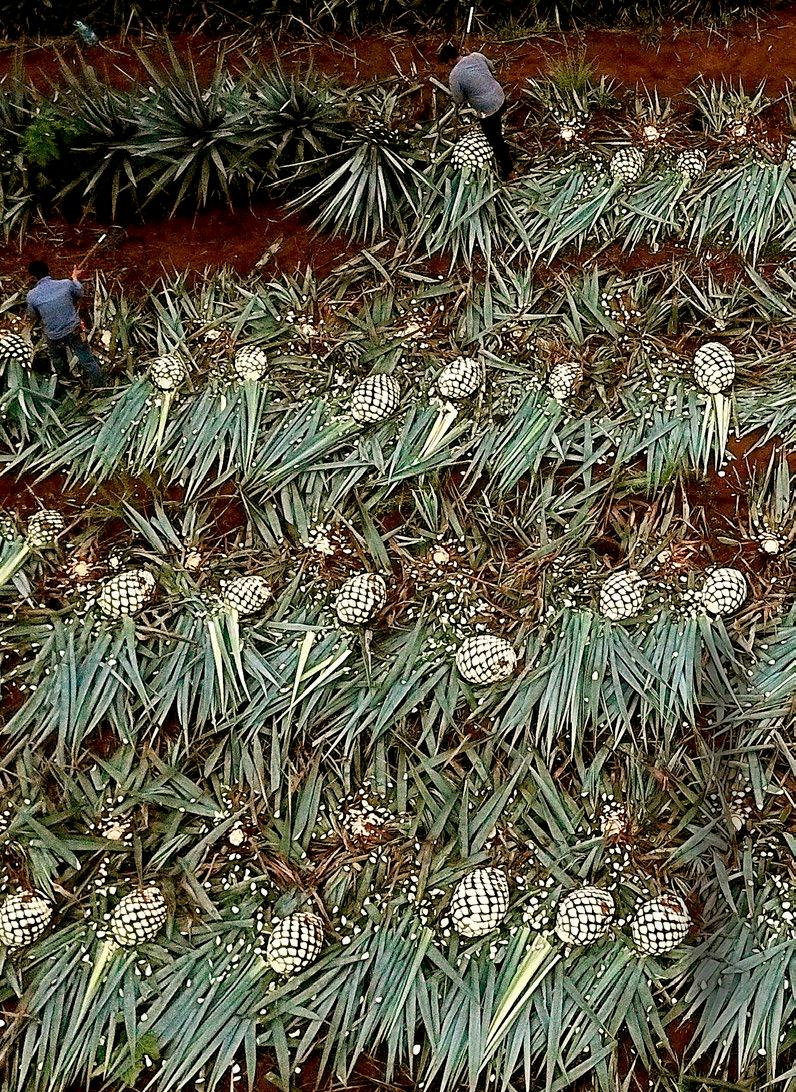
Photos: AFP vi A Getty i m AG es/UL ises RU i Z 10
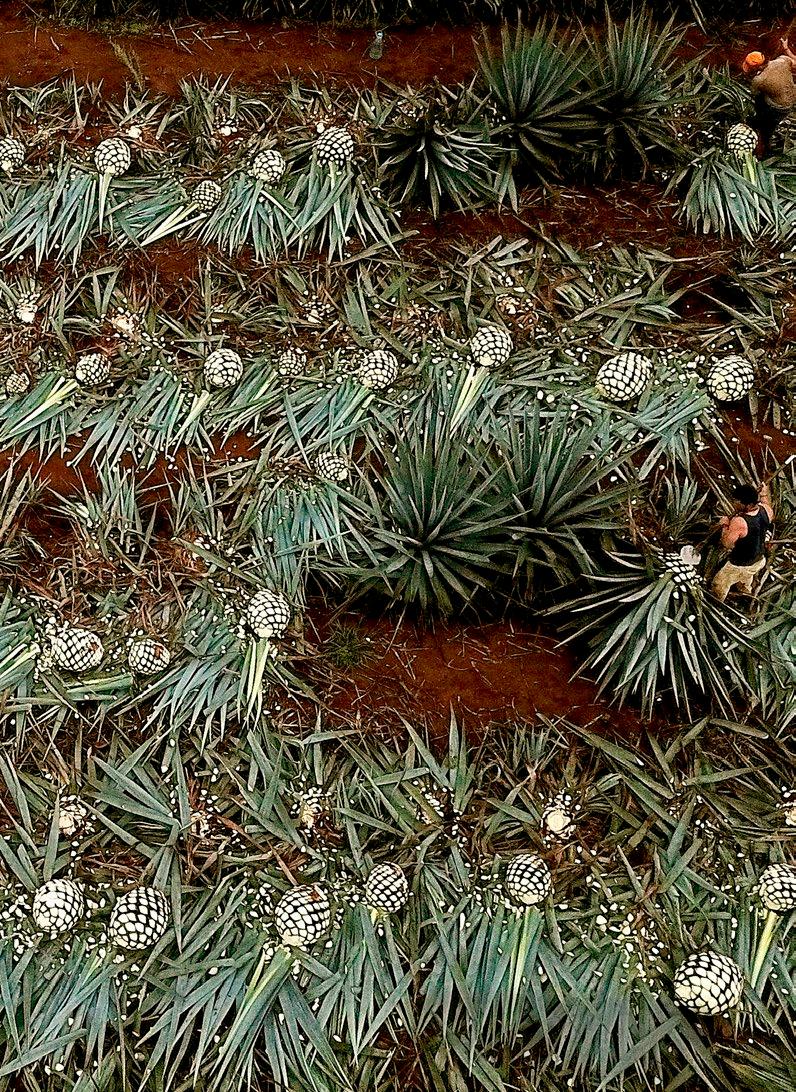
turn the page
SEE THE WORLD...

…DIFFERENTLY
From a purely botanical point of view, the blue agave belongs to the asparagus family. And like the vegetable asparagus, lots of people enjoy it. However, the blue agave is consumed in liquid form, as tequila is distilled from it. It takes eight to ten years for the plants to be harvested, as seen here on a plantation in Jalisco. This state is the centre of agave cultivation in Mexico.
12


For Food Thought
Olly Mann uses what's in the fridge and cupboards to break out of a food rut with new meals

Olly Mann presents Four Thought for BBC Radio 4, and the podcasts The Modern Mann, The Week Unwrapped and The Retrospectors
Have you ever found yourself stuck in a food loop? I have, and it’s very dispiriting. I realise there are worse things in life to be stuck in—lifts, tenancies, sewage—but, if you take plenty of pleasure in food, as I do, then coming to terms with the fact that you are often only eating what you are eating thanks to sheer lack of imagination can be really quite sobering.
Let’s turn a blind eye to breakfast. I mean, I’m busy: I’ve got two young kids to get uniformed up, teeth brushed, stuffed with cornflakes and out the door; a puppy, cat, chickens and goldfish to feed; news bulletins to catch up on, showers to take, caffeine to imbibe. It’s a wonder I manage to consume anything at all in the mornings— so I’m content enough to rotate through my ingrained repertoire: granola, eggs on toast, crumpets, smashed avocado, blueberry smoothie; croissants and waffles at the weekend. Breakfast is simply about
illustration by Daniela Alfieri JUNE 2023 • 15
variety, convenience and a pleasing familiarity for me.
However, I recently realised that my lunch and dinner menus had become similarly rigid, and, really, there’s no excuse, is there? I work from home; I’m surrounded by a large selection of supermarkets, farm shops, and street markets; and I cook from scratch most days. The only reason I wasn’t varying up my menu was because I couldn’t be bothered to put the work in. Like someone
dumped on to some spaghetti and swirled around in a glass of cheap red wine. Once it became a favourite of my wife, it evolved, over the decades, into ever-fancier versions, and now encompasses capers, sliced olives and parmesan. Posh!
My lunch choices had become even more locked-down: I was alternating only between a prawn dumpling miso soup bought in bulk from Costco, an egg and mayonnaise sandwich, and crudites
THE ONLY REASON I WASN'T VARYING UP MY MENU WAS BECAUSE I COULDN'T BE BOTHERED
who wears the same clothes every day. Or watches soap operas. I don’t want to be that person!
These were the dinner staples: a homemade pesto I do in the blender (secret: too much garlic). Fajitas with roasted veg (secret: fresh guacamole, never from a pot). Chicken nuggets and sweet potato fries (secret: air fryer. Obviously). A few recipes yanked from magazines over the years, now smeared with turmeric-yellow stains—a Honey & Co aubergine shawarma, a Lussman’s seared seabream, a Nigel Slater risotto.
And then there’s "special pasta"—a dish I invented when I was a student, which in its first incarnation was literally formed from a tin of tuna and half a tin of sundried tomatoes
sprinkled with salt and then dipped in hummus.
You’re probably thinking: stop whingeing, that all sounds perfectly decent, it’s hardly beans on toast each night. But, as I said, I like my food. I’m the kind of person who takes detours to farm shops when I see the signposts. I watch Saturday Kitchen. I intentionally try something new each time I go to a restaurant, rather than just ordering the steak and chips or whatever (a policy that served me well, right up until that time I ordered andouillette without knowing what it was, and nearly barfed up all over the brasserie).
So, time for action! Step one? Use up the random tins at the back of the cupboard that I’d enthusiastically purchased, then never bothered to
16 • JUNE 2023 IT’S A MANN’S WORLD
cook with. What would happen if I insisted on them being the central ingredient for a dish? Jackfruit tacos, that’s what. Plus a mackerel pâté, a Thai red curry, and an orzotto. A good start.
Step two was to actively unearth recipes that revolved around the ingredients in my fridge, because my bookshelves heave with Jamie, Delia and Nigella, but I don’t always have the elements of their recipes ready to play (it’s all very well substituting yoghurt for crème fraiche, but once you start adding cucumber instead of courgette, you know you’re in trouble). So, I subscribed to a couple of apps that enable you to search for recipes based on what you actually have in-hand, like "cod, leeks and mushroom", or "lamb, chilli and kohlrabi". Suddenly, I found myself making spice mixes, stirring up sauces, and generally challenging myself in the kitchen again.
Step three, and I can’t emphasise this enough, was to work on my
prep. You know those little bowls of ingredients that celebrity chefs have, ready-measured, so they can just casually chuck them in to a stew while they’re in the middle of presenting a link and sexily throwing their hair? Presumably, those little bowls are actually measured out on-set by home economists, so the recipe looks unfussy on the telly: nobody wants to see Mary Berry frantically grating garlic while simultaneously basting a chicken. But, guess what: you can do this at home too.
This was a revelation to me. Now, I prepare all the quantities first, stick them in little ramekins saved over from Gü puddings, and then, when the time comes, confidently sprinkle them into the saucepan— stress averted.
I know these efforts won’t last forever. But at least the variety should make special pasta taste more special again, next time I make it. n
Isle Of Wight Festival
Beginning with festivals between 1968 and 1970, the 1970 festival had a line-up that included Jimi Hendrix, The Who, The Doors and Joni Mitchell
Relaunched in 2002, it has since hosted many legendary acts and bands. On June 15-18 the line-up includes Pulp, The Chemical Brothers and Robbie Williams
SOURCE: ISLEOFWIGHTFESTIVAL.COM
JUNE 2023 • 17 READER’S DIGEST

ENTERTAINMENT 18

Léa Seydoux
“I See Cinema As A Global Language”
By James Mottram
French actor Léa Seydoux is making her mark in Hollywood, all while maintaining a diverse filmography and humble approach
In a suite in Paris’ Hotel du Collectionneur, Léa Seydoux is quietly unpacking her extraordinary career. Since bursting onto screens well over a decade ago, this talented, elegant actor has graced everything from Wes Anderson’s The Grand Budapest Hotel and The French Dispatch to James Bond films Spectre and No Time to Die, playing Madeleine Swann, the woman who captured the heart of Daniel Craig’s 007. “I feel very happy,” she shrugs. “I just go with the flow.” If this sounds laissez-faire, Seydoux is not someone who takes her position of privilege for granted. “I have to pinch myself,” she admits.
It’s an understandable sentiment. While many French stars don’t conquer the international film circuit, the 37-year-old Seydoux is a rare exception. Even before her international breakthrough, 2013’s intense samesex love story Blue Is the Warmest Colour, she’d landed small roles for big directors like Quentin Tarantino (Inglourious Basterds), Ridley Scott (Robin Hood) and
ANDIA / ALAMY STOCK PHOTO
JUNE 2023 • 19
INTERVIEW: LÉA SEYDOUX
Woody Allen (Midnight in Paris). She even featured opposite Tom Cruise in Mission: Impossible—Ghost Protocol, the megastar requesting her personally and casting her without an audition.
As much as she loves the Hollywood movies she’s done— and she’s increasingly doing more of them—she has her eye on conquering world cinema. “I see the cinema as a global language, and we have different dialects,” she says, reeling off a list of directors—Austrian, Israeli, Tajik—that she’s worked with in the past. “It has no boundaries. And I want to be able to explore every kind of movie in a way. And this is what I love. I mean, I love to adapt myself. I feel that I’m a bit like a chameleon. I like to transform myself.”
Alzheimer’s. As brutal as this is for Sandra to see, at the same time, she falls in love with an old friend (Melvil Poupaud), giving her joy at this most terrible of times.
Sandra’s commonplace nature, dealing with everyday vicissitudes of life, was part of the appeal for Seydoux. “It’s true that it’s the first time that I that I’ve played someone who’s normal! And it’s the reason, maybe, why people are so touched by the movie—because they can relate to her. She goes through very simple emotions. Emotions that we are all connected to. I mean, what is it to have a sick parent? It’s a movie about very simple subjects like love, death, motherhood. I like that.”

Just occasionally, though, she hides in plain sight. We’re here to talk about One Fine Morning, Seydoux’s latest, a film that’s somehow both devastating and uplifting in the same breath. She plays Sandra, a translator and single mother whose father, a former philosophy professor, has been stricken by Benson’s syndrome, a rare and cruel condition caused by
Playing down her beauty, something most directors emphasise, it’s a performance of great subtlety from Seydoux. Although we shouldn’t be surprised. As The Hollywood Reporter noted, “She’s the rare star equally adept at cranking up the wattage—her gaze can smoulder with the best of them, and she knows how to give lines a showstopping urgency—and turning it down enough to slip credibly into the skin of ordinary women.”
ENTERTAINMENT PICTURES / ALAMY STOCK PHOTO 20 • JUNE 2023
Xxxx


(This page) One Fine Morning, Seydoux’s latest film. (Left) On a Bond poster for No Time to Die
It’s Seydoux’s first film for Mia Hansen-Løve, the French writerdirector behind Bergman Island and Things to Come , who has been watching her work for years. “Something I find very special about her is that although she’s been in so many films as an actress—and she has such a long career now and experience—to me, she has an innocence about her presence on screen and how she acts,” HansenLøve tells me. “And there is a sadness about her that moves me a lot because that sadness never seems ‘acted’.”
In person, Seydoux doesn’t seem sad. She’s a little shy and softlyspoken but seems possessed of quiet self-confidence. Today, she’s wearing brown ankle boots, black and white check trousers, and a
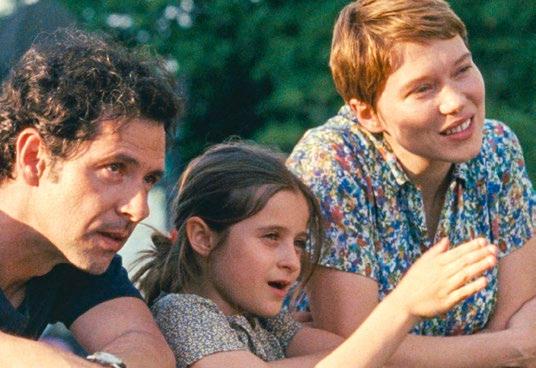
JUNE 2023 • 21
Xxx Jackman in The Son Xxxxx
READER’S DIGEST
cream, button-free top with zips at the end of the black sleeves.
Next to her, her phone’s home screen has a picture of Georges, her six-year-old son with long-term actor boyfriend André Meyer. Yet she instantly agrees with HansenLøve’s assessment of her. “I’ve always been melancholic, even as a kid,” she nods. “I was born melancholic. But I’m also very joyful. You can be both.”
Born in Paris, she has one older biological sister Camille, who later became her regular stylist, and five other half-siblings. Her mother had three children before she married Seydoux’s father. After her parents
split, when Seydoux was three, her father had two more children.
Hers was no ordinary upbringing, though. Her mother Valérie Schlumberger is a former actressturned-philanthropist, who spent much time in Africa, while her businessman father Henri Seydoux founded Parrot, a company involved in wireless technology.
Meanwhile, her grandfather, Jérôme Seydoux, was the chairman of French film outfit Pathé, while her grand-uncle was the chairman of Gaumont Film Company. Given Seydoux’s heritage, you’d imagine cinema was in her blood. “No, not at all,” she says. “It’s not something that was natural to me.” She says that

ASSOCIATED PRESS / ALAMY STOCK PHOTO
22 • JUNE 2023
(Left) Anne-Sophie Franck, Léa Seydoux and Stéphanie Sokolinski, in Girlfriends, 2006. (Opposite) Léa Seydoux attending the Venice Film Festival, 2009
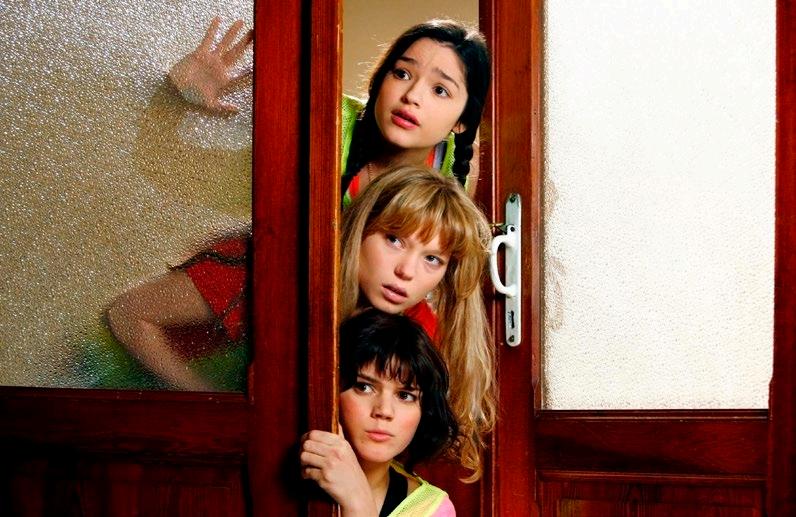
“I LOVE TO ADAPT. I FEEL THAT I’M A BIT LIKE A CHAMELEON. I LIKE TO TRANSFORM MYSELF”
her family took no interest in her blossoming film career, and, anyway, as a child she had a desire to be an opera singer. She studied music at the Paris Conservatoire.
“I grew up not really with cinema, but artists…people around me who were very inspiring,” she adds. Her parents’ connections meant she became acquainted with icons like musicians Lou Reed and Mick Jagger, and photographer Nan Goldin.
Oddly, though, her desire to act came instead through chance encounters with actors. She met one—she won’t say who—and envied
his existence. “I wanted to have his life! Because I like freedom. And I think that when you’re an actor, you have a lot of freedom.”
Then she met a second actor, whose name she also keeps guarded. “I fell in love with him. I was like, ‘Wow, he’s great! He’s a wonderful actor, he’s beautiful.’ I wanted to impress him. I was in love with him!”.
Immediately, she resolved to develop her performance skills. “It was difficult at the beginning because I had no technique,” she says. She took acting classes at French drama school Les Enfants Terribles, and in
EVERETT COLLECTION INC / ALAMY STOCK PHOTO
JUNE 2023 • 23
2007—a year after making her screen debut in the French-Belgian comedy Girlfriends—joined the prestigious New York Actors Studio.
Two years later, she was playing a bit-part in Quentin Tarantino’s Second World War film Inglourious Basterds, as the daughter of a French farmer. “I remember when I saw Tarantino for the first time I was really very shy. But I was impressed.”
It was enough to kickstart a career that truly exploded with Blue Is the Warmest Colour , which won the Cannes Film Festival’s top prize, the Palme d’Or. “I was very happy when I had the Golden Palm. Extremely happy,” she says. “But for me, the best reward is to touch people.
When I feel that I touch people’s hearts, I’m satisfied.”
As gentle as Seydoux sounds, she’s often drawn to extremes. Take last year’s Crimes of the Future, the latest film from Canadian horror maestro David Cronenberg. Like Blue Is the Warmest Colour, it required nudity (albeit in strange, sci-fitinged surroundings). Can she ever feel at ease in a situation like that?
“THE BEST REWARD IS TO TOUCH PEOPLE. WHEN I FEEL THAT I TOUCH PEOPLE’S HEARTS, I’M SATISFIED”

CD/PROD.DB / ALAMY STOCK PHOTO 24 • JUNE 2023 INTERVIEW:
LÉA SEYDOUX
With Christoph Waltz in InglouriousBasterds, 2009
Starring in Blue Is the Warmest Colour, 2013
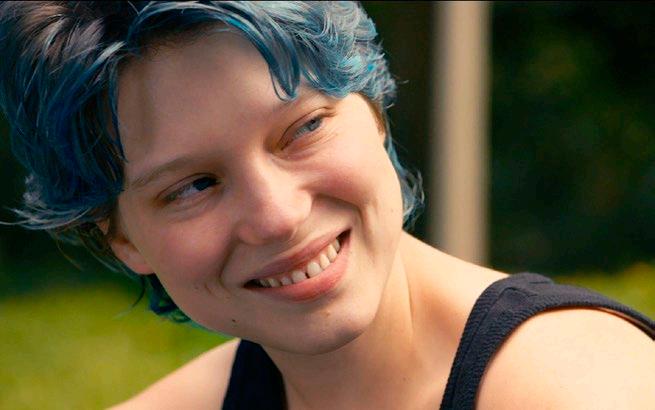
“You can’t feel comfortable! But when you’re an actor, you have to show reality. I don’t really like to be naked…but for me, if you want to do cinema and you’re an actor…you want to touch reality and the truth.”
Coming up, Seydoux has a small role in another sci-fi, Dune: Part Two , Denis Villeneuve’s follow-up to his spectacular Oscar-winning take on Frank Herbert’s epic novel. Intriguingly, she’s also set to star in a remake of erotic classic Emmanuelle for French director, Audrey Diwan. It’s due to start shooting at the end of the year, and you can expect a radical rethink from the softcore original. “I think we want to talk about a woman of nowadays. What
it is to be a woman today. And, of course, the relationship to sexuality,” she says. “We want to talk about our desire as women.”
Now also a brand ambassador for fashion giant Louis Vuitton, somehow, Seydoux has retained her down-to-earth nature—in spite of her increasing celebrity. “It’s not like a level of celebrity…it’s not like Daniel [Craig],” she protests. “He’s a superstar. If he walks the street, everybody will be like, ‘Daniel! Daniel!’ Me...?”. A look of amazement crosses her face, as if this might ever happen to her. Maybe it will, but you imagine it won’t change her a bit. n
One Fine Morning is in cinemas and on MUBI from June 16
CINEMATIC COLLECTION / ALAMY STOCK PHOTO
JUNE 2023 • 25 READER’S DIGEST



PA IMAGES / ALAMY STOCK PHOTO ENTERTAINMENT 26 • JUNE 2023
I REMEMBER…

Andrew Pritchard
Andrew Pritchard (56) went from an Action Man kid and music-obsessed teenager to one of the UK's biggest drug smugglers, who served time in HMP Belmarsh. Now he's helping to guide at-risk young people away from a life of crime
JUNE 2023 • 27
MUM ARRIVED IN THE UK IN 1951 AS PART OF THE WINDRUSH GENERATION. Marion, or Mavis as she became known, was born in October 1930, in a small village called Alligator Pond, in the parish of St Elizabeth, Jamaica. In December 1951, at the age of 21, Mum flew from her native Jamaica to Canada, then boarded a boat to the UK.
DAD, RONNIE PRITCHARD, WAS A WHITE LOCAL EAST END BOY WHO STARTED OUT AS A BUILDER. In the Fifties, he started delivering paraffin to West Indian customers, becoming friends with many. One of Dad’s new friends was a Jamaican called Bill Hill. Bill, something of a rogue, had the ambition to create the first Caribbean nightclub in London. Racism was rife in those days, so Dad agreed to help by becoming the secretary to Bill’s company. It would be easier for a white man to apply for a music licence. The Pepper Pot Club opened in 1958 at 60 Green Lanes, Haringey. Every weekend, smartly dressed West Indians would gather to listen to the latest tunes from Federal Records and the Blue Beat music labels.
ONE SATURDAY EVENING BACK IN 1958, Dad was invited to a blues party in North London. That’s where he met Mavis. Soon after, they got married and they didn’t spend a day apart for 60 years.

WHEN I WAS ABOUT FIVE, LIKE SO MANY OTHER KIDS, I WAS OBSESSED WITH ACTION MAN. The blond-haired, eagle-eyed action figure had a robust, articulated plastic body with elastic tendons. Mine had a desert camouflage uniform. They were marketed with a full range of accessories, such as different uniforms, weapons, vehicles… even a helicopter. The original form of pester
• JUNE 2023
28 I REMEMBER

(Below) Andrew, front with (from left)
Mum, Mavis, Dad, Ronnie and grandmother at a family party

power, it meant gullible kids like me would nag and pick the pockets of their long-suffering, loving parents. I would usually get some Action Man accessory every Sunday morning. One day, at the end of a financially hard month, I nagged to the point that Mum, a Jamaican disciplinarian, started looking for a belt to show me the error of my ways.
DAD, A KIND AND SALT-OF-THEEARTH EAST ENDER WHO WANTED A QUIET LIFE, had a better solution. With very little petrol, and next-to-no money, he took us to see the Changing of the Guard at Horseman’s Parade on the Mall at the opposite end to Buckingham Palace. We marched alongside the regimental band and he bought me a Mr Whippy cone with a flake.
AMONG MUM’S MANY ENTERPRISES WAS A WOMEN'S CLOTHES BOUTIQUE IN THE BASEMENT OF OUR HOUSE. Mum would cook up cauldrons of traditional spicy Jamaican chicken soup to give to West Indian customers visiting her boutique on Saturday mornings. Dad had set up changing rooms for Mum to sell “cabbages" —the nickname for extra stock from textile warehouses, through her network. This meant that her customers could buy the latest fashions before they got into the catalogues. And for a far better
READER’S DIGEST
JUNE 2023 • 29
price. Chicken soup remains an evocative smell of my childhood.
SATURDAY NIGHTS, I WOULD WATCH ALEX HALEY’S ROOTS, LIKE MOST FAMILIES WITH WEST INDIAN HERITAGE. Learning that our ancestors had been essentially kidnapped from West Africa and taken to the Caribbean as slaves for the sugar trade gave us a sense of injustice, but also of shared history.
BY THE BEGINNING OF THE 1980S, I STARTED TO BUNK OFF SCHOOL ON A REGULAR BASIS. I felt rejected by the white kids at my new school in Edmonton, North London. I was also an Arsenal supporter in deadly rival Spurs territory, and I soon found myself rebelling against the establishment.
REGGAE MUSIC AND JAMAICAN SOUND SYSTEM CULTURE
PROVED TO BE MY ONE RELEASE. I established my own sound system [a group of disc jockeys, engineers and MCs playing ska, rocksteady or reggae music], Mellow Magic, with two friends. We played a mix of soul, lovers' rock and roots reggae at our gigs. We had some dubplates and revelled in the frequent “sound clashes” with our competitors.
BY 1987, THE ADVENT OF ACID HOUSE, I THREW MYSELF INTO ORGANISING ILLEGAL RAVES. Our

biggest parties came under the banner of Genesis and Sunrise Parties. By now, in the second "Summer of Love" of 1988, at the age of just 23, I was one of the biggest promoters on the scene. Drugs and cash were the currencies, and I was coming to the attention of the newly formed police “Pay Party Taskforce”.
ON AUGUST 1, 1999, AS AN AVID REGGAE LOVER, I fulfilled my childhood dream by securing the rights to stage the largest urban music festival in the world, Reggae Sunsplash. Contacts among my extended family in Jamaica meant that I was able to successfully negotiate the right to put the event on. The temperature reached 37°C, and over 40,000 people travelled across Britain and Europe to attend
I REMEMBER
30 • JUNE 2023
Starting young: Andrew aged 15 with his first sound system

the festival in Victoria Park, East London. Celebrities arrived en masse, and the event was a huge success. And for once, entirely legal.
UNFORTUNATELY, BY THAT POINT, I HAD BEEN LURED INTO THE OTHER SIDE OF THE SCENE— DRUGS. I started out importing huge amounts of hash, but after spending some years with family in Jamaica, I got in with smugglers and was soon learning all about the trade of the premium, and most profitable product: cocaine. By the turn of the millennium, I had become a seasoned smuggler. I was a major player, importing industrial loads of cannabis and, later, cocaine from the Caribbean into the UK. In Jamaica, I learned to weld and cut steel to create false compartments in freight
lorries to hide the contraband. What could possibly go wrong, right?
IN DECEMBER 2004, I WAS INDICTED FOR IMPORTING HALF A METRIC TONNE OF PREMIUMGRADE COCAINE. Despite the fact that we had the corrupt Freight AntiSmuggling team on our payroll, it must have been naïve of me to have thought that we were the only smuggling syndicate operating through the fruit and vegetable market at the time. Because it soon came to light that we weren’t. There was one particular Essex-based drug trafficking organisation that British law enforcement had a serious interest in. We almost accidentally ended up under surveillance.
THAT LED TO MY FIRST MAJOR COURTROOM TRIAL IN 2005. My nickname in certain circles was "The Joker", thanks to my inventiveness when it came to getting out of sticky situations like this one. At the trial, I claimed that my distribution network was solely to import counterfeit premium cigars from Guyana, through shipping over loads of coconuts to the main fruit and vegetable market in East London. The defence I created was that a "wrong’un" in my organisation must have abused the supply chain to conceal huge amounts of cocaine. In reality, an agent provocateur for customs and MI6 had managed to
READER’S DIGEST
JUNE 2023 • 31

slip himself into our smuggling syndicate. Nevertheless, it was more than likely that the allegations of corruption against the police and customs must have caused sufficient doubt among the jury in that they acquitted me. We were working with a corrupt customs unit to clear the gear but what we didn’t know was that another clean unit had the docks under surveillance so they had to invent stories to cover their corrupt colleagues. That proved to be our get-out-of-jail-free card. But it would come back to haunt me. I might well have managed to dodge the bullet then, but law enforcement bears grudges.
I DIDN’T LEARN MY LESSON, THOUGH, AND WAS BACK TO MY OLD TRICKS AGAIN SOON. In 2015, I appeared at Woolwich Crown Court, and this time I wasn’t so lucky. This time, there was no option but to face the music.
AT THAT RETRIAL, I WAS FOUND GUILTY OF POSSESSION WITH INTENT TO SUPPLY COCAINE and perverting the course of justice. The judge sentenced me to 15 years of “bird” as a Category-A prisoner, where escape was impossible. This was accompanied by a crippling Proceeds of Crime Order (POCA), that meant all my ill-gotten gains would be taken away from me.
INSIDE, FULL OF REGRET FOR MY FAMILY AND VICTIMS, I BEGAN TO RE-EVALUATE. I had always tried to convince myself that my smuggling activities were “victimless” crimes. I looked at marijuana as a hippielike, easy way of life, and cocaine as a middle-class, after-dinner-party pursuit. Yet in HMP Belmarsh, every day I would see young men—boys, really—setting out on sentences for

I REMEMBER
32 • JUNE 2023 ,
stabbing and even killing other young lads in postcode gang wars for control of the drugs trade. What a senseless way to waste your life. I took it upon myself to come up with a postcode intervention course. After spending months trying to convince governors to give my idea a chance, in 2015, the One Postcode initiative launched. I designed courses that would give young people opportunities to progress in life once they got out. I shared my experiences to help them not to make the same mistakes as I did. I was convinced that by giving them alternatives, we could give them hope and, more importantly, a future. Within three months, assaults in Belmarsh on inmates and staff started to drop rapidly, making the institution safer for those who worked there and those who were obliged to live there.
DEVASTATINGLY, ON JULY 20, 2019, MY BEAUTIFUL MOTHER PASSED AWAY. This was the result of her suffering from various medical conditions, doubtless worsened by the shock of my long incarceration. This strengthened my resolve to “give back”. My dad died eight months later on April 1, 2020. They lived together, and it seems they couldn’t live without each other.
UPON MY RELEASE, I FORMED THE AP FOUNDATION, an organisation designed to stop
re-offending. For over 30 years, I had made organised crime my profession that promised the luxury lifestyle across the world—cars, villas, women, boats—only to realise it all amounted to nothing. It just created a legacy of misery and destruction.
TODAY, THE AP FOUNDATION WORKS
ACROSS SCHOOLS, YOUTH CLUBS, PUPIL REFERRAL UNITS, PRISONS ACROSS THE COUNTRY and, yes, even the police, to deliver rehabilitation programmes to persuade young people to stay away from crime. Our mission is to be a force for positive change and to turn young offenders’ lives around. We have a five-step pathway to help them. Namely, intervention, rehabilitation, training and education, employment and housing. If we can give people hope for the future, the whole of society will benefit since they will not fall back into re-offending. This is now my life’s work and a legacy project. I now see clearly that my actions in the past only destroyed communities that decent people like my parents strove so hard to build. I am driven by the urge to repair any damage and I can only hope they are proud of me, finally. n
To learn more about Andrew's work, visit apfoundation.co.uk
As told to Eugene Costello
READER’S DIGEST
JUNE 2023 • 33

photo-illo-credit-gutter

THE A-Z GUIDE TO HEALTH CHECKS IN 2023
AND CHECKS FOR UK ADULTS OF EVERY AGE
by Dr Nsisong Asanga
photo-illo-credit-gutter
HEALTH
JUNE 2023 • 35
Although chronic diseases appear to ambush the unsuspecting like a bandit, they typically develop over many years. Detecting them before they cause symptoms can give you better odds of beating them. That's what health screenings do. Health screenings help healthcare teams uncover early signs of cancers and other chronic diseases while there's an opportunity to treat them and avoid complications. According to the World Health Organis ation (WHO), early detection is essential for treating cancers and other chronic conditions.
"Screening saves lives", says Dr Sarah Welsh, co-founder of HANX, a female-focused UK sexual health brand. "The screening programmes run by the NHS can pick up cases of early cancer, which have not shown any symptoms at all, preventing progression of the disease," she adds.
A group of experts called the UK National Screening Committee (UK NSC) guide the NHS in all four UK countries on the screening programmes to offer and to whom.
This committee reviews its recommendations every three years, in line with new research findings as well as public consultation. It also monitors the overall quality of screening programmes.
The NHS offers all its screening tests free. Although private companies may offer many more, some tests they provide have not been recommended by the UK NSC because benefits don't clearly outweigh possible harm.
36 • JUNE 2023 THE A-Z GUIDE TO HEALTH CHECKS IN 2023
BENEFITS OF SCREENING TESTS
According to Dr Hana Patel, a general practitioner (GP), screenings have numerous benefits. "They help reduce people's risk of developing various conditions, or if they do develop, then to diagnose and start treatment early, to reduce disease complications," she adds.
The NHS lists other benefits of screenings, such as:
• They can help make your treatment more effective if a problem is detected early.
• They can help you make informed
decisions. For example, knowing your blood pressure or sugar levels are raised can help you decide to seek care.
• They can reduce your chances of developing complications. For example, after knowing your blood pressure is raised and you seek treatment, you might avoid complications like stroke and heart disease.
• They prevent death—for instance, those deaths caused by breast, bowel and cervical cancer or abdominal aneurysms.
Screening tests can also give you more control over your health and tricky

READER’S DIGEST
decisions like end-of-life care or succession planning.
SCREENINGS BY AGE AND SEX
Age is a significant risk factor for many chronic diseases. Experts can now predict when certain conditions are likely to occur, based on data gathered over time.
However, there are exceptions. One of them is having a family history of a disease. If anyone in your family has a chronic condition, discussing earlier screening with your GP is a good idea. But here are screenings for adults of every age to consider, according to current NHS guidelines.
FROM 18 TO 39 YEARS
The WHO classifies adults from 18 to 39 years as young. Younger adults usually have lower chronic disease risks than older ones. However, here are screenings and health checks recommended for this age group by the NHS.
EYE TESTS: Experts advise that you check your eyes often, about once a year or two. Eye checks can detect conditions like glaucoma, myopia and astigmatism.
In the UK, everyone with diabetes is offered a diabetic eye screening from age 12 to detect early signs of diabetic retinopathy—a complication of diabetes that can lead to blindness.
WEIGHT CHECKS: About one in four adults in the UK have obesity—they weigh more than is healthy, risking health complications. Weight checks are something you can do on your own, at a gym, or at any health facility. All you need are functional bathroom scales. Knowing your weight at least once a year can help you know what's usual for you and help manage your weight too.
BLOOD PRESSURE:
Blood pressure checks can help you spot high blood pressure on time and access treatment. About one in three adults in the UK have high blood pressure, but many people don't know it because it often shows no symptoms. If you already manage high blood pressure, you may need more frequent measurements. Follow the guidelines given by your care team. Managing your blood pressure can help you avoid its complications, such as stroke, heart disease and kidney disease.
MENTAL HEALTH SCREENINGS:
Your healthcare providers can screen you for depression and other mental health conditions. If you experience a persistent low mood,
38 • JUNE 2023 THE A-Z GUIDE TO HEALTH CHECKS IN 2023

deep sadness, low or no appetite, self-harm thoughts, or thoughts of harming others—they could be symptoms of depression.
The NHS provides an online selfassessment tool designed specifically to help you tell the difference between a passing bad mood and depression. If you have concerns about your mental health, you can call the NHS on 111.
SEXUALLY TRANSMITTED
INFECTIONS: You can get screened for sexually transmitted infections (STI) like chlamydia, gonorrhoea, syphilis and HIV. The UK Health Security Agency says many sexual health services in the UK offer free STI self-sampling kits for people who request them, whether they are showing symptoms or not. Testing is a good idea, especially if you think you may have been exposed to an STI, have many partners, recently
changed partners, or want to know your status.
CERVICAL CANCER: PAP smears to screen for cervical cancer are offered to all women and people with a cervix every three years from age 25 to 49 years. You may also be tested for human papillomavirus (HPV), which is linked to cervical cancer.
SCREENINGS FOR PREGNANT
WOMEN AND PEOPLE: The NHS offers pregnant women and people several screenings, including those for infectious diseases, genetic conditions and fetal conditions.
AGES 40 TO 74 YEARS OLD
The NHS considers people from 40 to 64 years to be middle-aged and those
JUNE 2023 • 39

from 65 years as older persons. Adults in this group will have all the same screening needs as younger adults, along with additional needs specifically of this group.
NHS
HEALTH
CHECK:
This is a health check-up programme for adults in England aged 40 to 74 years. The programme aims to detect early signs of heart disease, stroke, kidney disease, type 2 diabetes or dementia. Age is a major risk factor for these conditions, so as you get older, checking is more important.
Adults from 40 to 74 years without pre-existing conditions are invited for a free NHS health check every five years. However, you can also schedule a health check with your GP if you want one.
After your health check, a member of your care team will discuss your results with you and advise on the best way to reduce your risk of
dementia, kidney disease, stroke, type 2 diabetes and heart disease.
There is also an online tool called the "How Are You?" quiz that helps you assess your wellbeing. It's a short test that reminds you to take care of yourself by following a healthy diet, physical activity and other healthy lifestyle choices.
BOWEL CANCER SCREENING:
Bowel cancer is the fourth most common cancer in the UK. In the UK, everyone from age 60 is offered a bowel cancer screening home test kit until they are 74. If you are 75 or older, you can request a free test every two years by calling the free bowel cancer screening helpline on 0800 707 60 60.
BREAST
SCREENING: The lifetime risk of a woman in the UK being diagnosed with breast cancer is one in eight. The NHS offers women aged
40 • JUNE 2023
50 to 71 mammograms to detect breast cancer. Mammograms use X-rays to examine the breast tissue for early signs of cancer.
You may be able to get screenings before 50 years old if you have a high risk of developing breast cancer, such as if you have a family member with the condition.
And if you notice any difference in the way your breasts look or feel, see a GP immediately.
CERVICAL CANCER SCREENINGS:
These begin at 25, but from 50 to 64 years old they are every five years (not three years). Depending on your results, you may be invited earlier than expected.
PROSTATE EXAMS: There's no national screening programme for men in the UK, because experts don't believe the benefits outweigh the risks.
However, in the UK, prostate cancer is the most common cancer in men, affecting about 52,000 men a year (or 143 men every day). Men aged 50 and over can decide to have their prostatespecific antigen (PSA) levels checked— which can be elevated in prostate cancer, helping doctors to detect it early—and the NHS can do the test for free. It could be done sooner if there's a family history of prostate cancer.
ABDOMINAL AORTIC ANEURYSMS
SCREENING: This screening test
involves a painless ultrasound device being placed in your stomach to look for swelling in your aorta. It's offered to men as they turn 65, and it's not routinely offered to women, men below 65 or people who have been treated for the condition already, because they have a lower risk.
But if you think you need one, you can ask for a screening.
LIMITATIONS OF SCREENINGS
Despite their undeniable benefits, screenings have limitations and in some cases can do more harm than good. They are not 100 per cent reliable. Sometimes, screenings may have a false detection, making you undergo unnecessary procedures. They may fail to detect the cancer or condition, giving a false sense of relief. Also, knowing about a condition early without a clear plan to cure it can create feelings of sadness, anxiety, anger and despair.
But screenings can improve your chances of living a long, healthy life. The NHS offers several free screenings, but you can also speak to your GP about being screened if you have concerns or a higher risk of any condition. Discussing your plans and whether or not you should have screenings with your health team can help you make an informed choice. n
READER’S DIGEST JUNE 2023 • 41

This therapy is gaining credibility as it shows real results
Medicine Is WhenMusic
BY Anicka Quin
THERE’S ONE PATIENT that SarahRose Black still thinks about. Back in 2019, the nursing team in the palliative care unit at Toronto’s Princess Margaret Cancer Centre asked if she could reach out to a patient who had been there for about a week. The man was struggling, and unwilling to engage with staff or be part of any activities. “They told me, ‘He’s short and grumpy with us, and we wonder if you might have an in.’”
HEALTH
illustration by Petra Braun JUNE 2023 • 43
Black isn’t a doctor or a nurse. Since 2013 she has played an important role for patients as Princess Margaret’s on-staff music therapist. On any given day, she might see one person who’s anxious about an upcoming procedure, another who’s undergoing chemo and in need of a soothing moment. Or, like the man in the palliative care unit, it might be someone who doesn’t yet know they need her.
So, on a wintry Wednesday afternoon, Black approached the patient’s room and introduced herself.
“Absolutely,” he said through tears.
“It was as if the music went places that nothing else could,” recalls Black. “He shared with me afterward that he’d been holding in so much and had been unable to talk about anything— but the music showed up at a moment when it felt like a hug.”
Anyone who has felt that spark of joy when a favourite song comes on the radio at just the right moment—or wept along with a singer who is expressing heartache—will understand the emotional resonance of music. But now, a growing body of
A MUSIC-THERAPY SESSION CAN BE AS UNIQUE AS AN INDIVIDUAL PATIENT’S NEEDS ON A GIVEN DAY
She asked if she could sit, and offered to play some music. In an effort to convince him, she said, “If you don’t like it, you can just tell me to leave.”
After some gentle urging, the 70-something man, who had lung cancer, told her a few classical composers he liked and then turned away to look out the window. But as she started to play one of his favourites, Bach, on her portable keyboard, a change came over him. He unfolded his arms, turned toward Black and started to cry.
She stopped playing. “Do you want me to continue?” she asked.
scientific evidence is actually demonstrating that music can be medicine, too.
In a review of 400 research papers looking into the neurochemistry of music, Daniel Levitin, a psychologist and neuroscientist at McGill University in Montreal, found that playing and listening to music had clear mental and physical health benefits, including improving our immune systems and reducing stress levels.
One 2007 study from a team of Spanish researchers found that listening to music before surgery had the same effect in reducing
44 • JUNE 2023 WHEN MUSIC IS MEDICINE
pre-operative anxiety as taking diazepam—an important finding, as anxiety before a major surgery can affect post-operative pain and recovery time. Another Spanish study, conducted in 2018 in the palliative care unit of Barcelona’s Hospital del Mar, found that patients participating in a music-therapy programme experienced significant decreases in tiredness, anxiety and breathing difficulties, as well as an increase in feelings of wellbeing.
Even major healthcare institutions are embracing music therapy on a wide scale. In 2019, the National Institutes of Health in the US introduced significant funding—$20 million—to support research projects in music therapy and neuroscience.
A music-therapy session can be as unique as an individual patient’s needs on a given day. With Black, who also sings, that inevitably involves the cart of instruments she travels with (“I’m pretty much a one-woman band,” she jokes). Aside from the keyboard, to create rhythms and texture, she has other instruments such as a guitar, tambourine, singing bowls and more. She also brings recording equipment and an iPad, to supply song lyrics.
If a patient loves classical music, she’ll play it. Maybe it’s folk or jazz. She did a Bob Marley tune for a man’s assisted-dying process. “One woman spoke no English, but she taught me a Farsi folk song, and we had this wonderful exchange,” says Black. “She’d sing a line, I’d sing it back, and we were singing this beautiful song together.”
She’s gentle in her approach with patients. “I make it very clear that preexisting musical experience or training isn’t required to participate,” she says. “If I were to ask, ‘What kind of music do you like?’ that might be a difficult question to answer. Instead I ask what they want to feel, which is an easier question to answer.”

If the goal is pain management, Black might match the pace of her playing with the patient’s breathing, and then gradually slow the music. This process, called “entrainment,” can help slow the breath, too, and has a calming effect.
Or a session might be about helping a patient process the emotions stemming from what they are going through. It may even be about connecting with loved ones who are in the room with them. “Sometimes the patient says, ‘I’m having such a profound experience. I have no words,’” she says. “We know
by
Lynn Scurfield
illustration
READER’S DIGEST JUNE 2023 • 45
from so many wonderful brain studies that music can trigger memories and touch parts of the brain that other mediums cannot.”
ONCE A WEEK, Carol Cameron hops on Zoom from her home in Madison, Wisconsin. She’ll be joined by a dozen or so other participants, all following along as music therapist Jason Armstrong Baker leads them through drumming exercises— sometimes clapping their hands in a distinct rhythm he’s laid out for them, sometimes tapping on their own bodies.
Like everyone taking part in the session, Cameron, 71, has Parkinson’s disease, and this drumming circle— known as Rx 4 Rhythm—is designed to help strengthen her coordination. “My tremor is on my left side, so learning things with my left hand is difficult,” she says. “But it’s really good to get this regular rhythm going—it gives you a feeling of overcoming a problem.”
Symphony Orchestra in Philadelphia. Today, he is a neurologist who specialises in movement disorders like Parkinson’s and Huntington’s. The centre provides music therapy and more, Pantelyat explains. They’re taking music into the “precision medicine” realm.

Applying that kind of treatment to movement disorders is relatively new; previously, it was mainly the domain of cancer therapies. “There’s a revolution in oncology and cancer research—more people are being cured, and much of it can be attributed to a very targeted precision treatment that really is individualised for the patients,” he explains. “Just listening to music activates many regions of the brain simultaneously.”
Rx 4 Rhythm is just one of the programmes offered at the Johns Hopkins Centre for Music and Medicine in Baltimore. The research institution is the brainchild of Dr Alexander Pantelyat, a violin player and former member of the Penn
He adds that there is an understanding in the field of music medicine that there can be tailored interventions using music that a person actually likes, that speaks to them culturally, personally or autobiographically.
One study from the Centre for Music and Medicine followed a choir composed of Parkinson’s patients (called the “Parkinsonics”) to learn how singing might impact the speaking voice of those patients. After
illustration
by Lynn Scurfield
46 • JUNE 2023 WHEN MUSIC IS MEDICINE
12 weeks, the singers’ speaking volumes—which often fade as Parkinson’s progresses—grew demonstrably stronger. The Rx 4 Rhythm drumming circle, meanwhile, came out of a 2015 study that showed that Parkinson’s patients had improved their ability to walk after six weeks of drumming practice.
The centre’s blueprint is to continue to fund these musically-oriented groups, even after the studies have wrapped up. “Patients in the Parkinsonics told us that they didn’t
neurological disorders, along with their care partners—those in patients’ lives, usually loved ones, who are supporting them through their illness.
“There can be folks experiencing intensive symptoms, like a decline in their ability to verbally communicate,” says Devlin. Music, she notes, can sometimes help such patients find ways to respond again. “I’ve had the honour of making music with people, and all of a sudden they’re coming up with new words. It turns into this beautiful improvisational moment—
DEVLIN SAYS IT’S A POWERFUL THING TO WITNESS SOMEONE FIND THEMSELVES AGAIN FOR A MOMENT, THANKS TO A SONG
want to stop singing when the study was over,” says Pantelyat. The centre now funds a professional choir instructor, a music therapist and a social worker to help the choir members carry on with their classes, which rolled onto Zoom calls during the pandemic.
And while sessions at the centre do have therapeutic goals—working on coordination, say, or breathing techniques for anxiety management— there’s a community-building element to the groups, too. Kerry Devlin is the centre’s senior music therapist and runs an online support group for people with a broad range of
and a care partner is saying, ‘I’ve never seen this happen.’”
It’s a powerful thing, she says, to witness someone find themselves again for a moment, and when a song is the vehicle for that shift.
Much of what Devlin does is designed to help patients feel like more than just cogs in the medical system. “Of course they want to come and receive medications and treatments, but they’re also a person,” she says. “It’s important when we’re thinking about holistic care to provide opportunities for patients to actually process the impact that a diagnosis is having on their lives.”
READER’S DIGEST JUNE 2023 • 47
Music can have a profound effect on helping sick children, too. Ruth Hunston is a music therapist in the “play department” at the Great Ormond Street Hospital in London. As the UK’s oldest children’s hospital, it sees over 69,000 patients a year.
“When children are in the hospital, their worlds get much smaller,” says Hunston, who explains that her programme, introduced in 2019, helps give young patients back some sense of control. “They’re having so many things done to them and around them,
“What’s really lovely is when you go in and you start to make music, and the children invite their parents to join. There’s this beautiful interaction between everyone, and sometimes I get to step back and just watch them play—to really laugh and have fun.”
AT
THE
DR BOB
Kemp Hospice in Hamilton, Ontario, music therapy has become an integral part of patient care in residential end-of-life settings. “The palliative journey isn’t really about someone dying,” says Doug Mattina,
“THERE’S THIS BEAUTIFUL INTERACTION BETWEEN EVERYONE, AND SOMETIMES I GET TO STEP BACK AND JUST WATCH THEM PLAY”
but this allows them to create something themselves.”
Extended time in paediatric care can also affect a child’s development, says Hunston. In light of that, much of her programme is designed to help them progress. “I’ve had lots of infants who have sat up for the first time at the drums, because they’re just so motivated to play,” she says. “Or they start making sounds because I’m singing to them, and they want more.”
The parents also become part of the therapeutic process. “It’s not easy being in a hospital, and it’s not easy to leave your child there,” she says.
director of the hospice’s paediatric unit. “It’s about bringing the most joy. It’s providing the wrap-around care not only for the individual but for those impacted by it.”
Mattina himself experienced the music-therapy programme when his father spent his last days at the hospice. “I remember when the music therapist said to him, ‘Bill, what kind of mood are we in today?’ And he said, ‘Today is time to dance,’” says Mattina. He was so moved by the whole experience that he left a career in the foreign service to work full-time for the hospice. “Even though my father was
48 • JUNE 2023 WHEN MUSIC IS MEDICINE
feeling like crap, and we knew that we had days or hours left, me, my sister, my brother and my mum would dance around his bed. His favourite song for this was ‘Rasputin,’ and he would request high kicks from us as he clapped along. Sometimes he’d fall asleep as we danced.”
Sara Klinck directs the musictherapy programme at the hospice, where, at a patient’s bedside, she might improvise a call-and-response song to help them open up about how they’re feeling that day, or help a resident write a song as a legacy for their family.
“We might also revisit songs that have personal significance for residents and families, as a way to communicate emotion to one another,” she says. “It can feel like a whole choir as visitors and family members join in. For some people, sometimes what’s hard to say is easier to sing.”
It could also mean fulfilling a lifelong goal before a patient passes away, as she did for someone with late-
stage ALS. “He had very limited movement in his hands but had always wanted to play guitar,” says Klinck.
She brought in the instrument and laid it on his lap in bed. “He was able to put his hands on the strings and interact with them; often I moved the guitar, as well.” This music experience was something his family felt would be very meaningful to him.
Finding those moments is the skilled therapist’s role, but as SarahRose Black notes, people have been connecting with music for their whole lives—she is just helping them access it again at a time when they need it most.
“We have a heartbeat, so we have a drum inside us; we are wired to be musical people,” she says. She smiles softly as she reflects back on one patient, a man in his late thirties with late-stage brain cancer.
“He said, ‘I have a lot of friends, and they’re great, but they don’t really understand what’s going on here,’” she says. “He told me that the music is like a friend who ‘gets it.’” n
Animal Speak
The greatness of a nation and its moral progress can be judged by the way its animals are treated
MAHATMA GANDHI
If animals could speak, the dog would be a blundering outspoken fellow; but the cat would have the rare grace of never saying a word too much
MARK TWAIN
READER’S DIGEST JUNE 2023 • 49
8 Sobering Facts About Women And Alcohol
Everyone knows that booze can be bad for your health, but there are some surprising effects of drinking for women

1. A woman gets more drunk than a man


Susannah Hickling is twice winner of the Guild of Health Writers Best Consumer Magazine Health
Feature
If a man and a woman drink the same amount, she will almost always register a higher blood alcohol level than her male drinking buddy. This is partly because women tend to be smaller and lighter, and so have a smaller volume of blood. But it also happens because they have a higher proportion of body fat than men and less body water. Alcohol is held in body water, so it’s more concentrated in females. This in turn means it’s more likely to have an adverse effect on a woman’s health than a man’s.
2. Booze increases your risk of breast and other cancers
According to the World Health Organisation, drinking alcohol is a
50 • JUNE 2 023 HEALTH
major—but modifiable—risk factor for breast cancer, causing seven out of every 100 cases in Europe. Booze raises oestrogen levels, which can lead to faster cell division and possible tumours. On top of that, the hard stuff has also been linked to liver, bowel, mouth, oesophageal and laryngeal cancer.
3. Women are more likely to drink to cope
A number of studies have shown that women tend to use alcohol to deal with stress more than men. Alcohol use among older women has also been found to have increased more than it has for men.
4. Two large glasses of wine are the calorie equivalent of a burger
While you may avoid foods that could pile on the pounds, how often do you factor in alcoholic drinks? Not only does regular drinking lead to weight gain, but alcohol also reduces the amount of fat we burn as energy. This is because the body prioritises getting rid of the alcohol.
5. Alcohol makes you look older than you are
Unfortunately, regular drinking can affect your looks. When you drink you don’t sleep as well, so you look
more tired in the morning. Alcohol also dehydrates you and is thought to deprive your skin of nutrients. This can make your face puffy and wrinkled and your skin dull, or, alternatively, appear flushed.
6. It can aggravate menopause symptoms
As if it isn’t enough that our changing hormones affect our sleep and our body temperature, alcohol can make insomnia, hot flushes and body sweats worse.
7. Drinking increases your risk of osteoporosis
Women’s bones tend to become less dense and more brittle as they get older. Consuming a lot of alcohol can exacerbate this.
8. There are effective ways to reduce your drinking
Have several alcohol-free days a week (but don’t binge on the other days of the week). Buy an alcohol measuring cup to keep track of how many units you’re glugging at home. Find alternatives to alcohol to help you de-stress, such as exercise or having a hot bath. Go for a lower alcohol content whenever you can— drink a spritzer rather than a large glass of white wine or opt for a zeroalcohol beer. n
JUNE 2023 • 51
Go Low
Certain foods are linked to a higher risk of type 2 diabetes. But by making a few wise dietary choices you might be able to bring down or stabilise your blood
Porridge Consistently eating foods that are high in fat and low in fibre, and carbohydrates with a high GI (glycaemic index), can raise your diabetes risk. Oats are a lowfibre, low GI food—meaning they don’t cause sudden rises and dips in blood glucose—and contain healthy fats. Adding milk to your porridge increases the fat content, so opt for skimmed or soya.
Blueberries Most fresh fruit have low GI scores, though levels creep up as they ripen. Especially good if you’re hoping to avoid type 2 diabetes are blueberries, grapes and apples. These were associated with a lower risk of developing the condition in a large 2013 American study, with blueberries coming out top of the table. Aim for three servings a week of these diabetes-friendly fruits—on your porridge perhaps. Overall, a diet high in fruit and vegetables is a must
if you’re committed to controlling blood sugar.
Sweet potato Cut down on white potatoes and opt for the sweet, orange-coloured variety. They have a much lower GI score and the flesh is also high in fibre.
Garlic We love garlic and rightly so— in a 2013 Indian study of 60 people with type 2 diabetes and obesity, participants who took metformin, a drug prescribed to lower blood glucose, and garlic capsules had lower fasting and post-meal blood glucose levels than volunteers who took just metformin. Another 2017 study from China found garlic supplements had a beneficial effect on blood sugar and cholesterol levels. Eat it raw, cooked or take it in supplement form.
Yoghurt But, hang on, yoghurt is a high-fat dairy product and to be avoided, right? Not necessarily. It’s high in saturated fat, but a large 2013 American study indicates it can lower the risk of type 2 diabetes. Plain yoghurt has a low GI score. Choose the unflavoured, unsweetened variety or Greek yoghurt over more sugary flavoured or sweetened yoghurts. n
For more weekly health tips and stories, sign up to our newsletter at readersdigest.co.uk
HEALTH 52 • JUNE 2023
Ask The Expert: Sisu
Dr Emilia Elisabet Lahti is a Finnish educator specialising in sisu, the Finnish art of building inner strength. She is the author of Gentle Power: A Revolution in How We Think, Lead, and Succeed (Sounds True, 2023)
What is sisu? It’s an inner fortitude we can develop that will not let us perish or give up in the face of adversity. It’s a personal reserve of energy that helps us push through hardships and carry on.
How did you become an expert in sisu? My journey to researching sisu started when I was going through a difficult time personally. I wanted to know how humans overcome extreme adversity and what life force carries us. I did a PhD on the topic,
to be none, manage when we have to deal with sick kids or a spouse and still get up early to perform at work.
How should people get started? Own the fact that you do have hidden reserves. Then commit to small daily practices that allow you to get constructively uncomfortable with hard things so that when life does get tough, you are prepared.
What tips can you give for developing sisu? Firstly, in a quiet moment note

READER’S DIGEST

Taking A Gamble
Dr Max explains the neurology of gambling addictions
It all started innocently enough for Tanya. As she sat in my clinic, she explained that it had begun with some flutter while she was off work following an operation. She was bored, feeling a bit lonely, and an advert for an online betting site popped up. She’d never gambled before and clicked on it just out of interest.
“I always associated gambling with old men in betting shops. This wasn’t
like that at all. It seemed like fun—the advert had women just like me in it—I was bored and it was just a laugh”.
And at first it was fun. But then it became a daily treat to break up the monotony, then it shifted and became something more sinister. “It started to really control me. It was actually scary,” she explained.
Before long she was spending hours gambling online. The rest of her story is as predictable as it is sad. She lost her job, got in debt and was evicted from the flat she rented. She moved back in with her parents. By now, the buzz of gambling was all she had.
It took a further two years and a spell of homelessness before she sought treatment and turned things around with the help of a psychotherapist. It left her with shattered self-confidence and ongoing anxiety. Her story is far from unique.
54 • JUNE 2023 HEALTH
We’ve heard a lot about how alcohol use increased during the COVID-19 lockdowns, but I have already started seeing patients emerging who, confined to their home with no work, no structure and isolated from friends or family for months on end, developed a real online gambling addiction. I don’t buy into the disease model of addiction—that someone is entirely helpless to their addiction. I’m a strong believer that it may have complex psychological dimensions, but ultimately—unlike other diseases—we are in control of our behaviour. But there’s no doubt that people who are vulnerable need to be protected as best as they can— they are up against a multibillionpound industry and so the dice—if you’ll excuse the gambling pun—are loaded against them.
Gambling addiction is a fascinating—if tragic—psychological phenomenon. People often mistakenly believe it’s the winning that keeps gamblers hooked. It’s actually more complicated than that. There are several things that make it such an addictive behaviour, all based around the way it fires up the reward pathways in our brain, even if, ironically, we aren’t rewarded by a win. The buzz of the expectation is incredibly intoxicating and, in fact, neuroscience has found that gambling addiction involves many of the same neurological pathways as
drug addiction. The brain releases large amounts of the neurotransmitter dopamine, which is involved in euphoric feelings, just as happens with drugs like cocaine.
The mind also plays a role in perpetuating the addiction by falling into “cognitive errors”—false beliefs or incorrect thinking patterns. The so-called “gambler’s fallacy” is the mistaken belief that if an event happens repeatedly, a different event is imminent. This is part of what keeps gamblers hooked—with each loss, they become more convinced a win is inevitable. It fuels the behaviour despite the fact that the odds of them winning are the same.
In the past, psychology has viewed gambling as a compulsion. It was motivated by the need to relieve anxiety rather than a craving for pleasure. We now know that gambling is more akin to addiction, but we still don’t treat it as such.
While substances that cause addiction are tightly regulated or outlawed, gambling so far has had a free pass. It makes no sense why it should be treated in such a lax fashion, given the devastation it can cause. n

Max is a hospital doctor, author and columnist. He currently works full-time in mental health for the NHS. His new book, The Marvellous Adventure of Being Human, is out now
JUNE 2023 • 55
The Doctor Is In
Dr Max Pemberton
Q: If I drink a couple of glasses of wine, I end up with a hellishly painful neck, mainly on the left side, and the pain travels to the top of my head. I have wondered if I am dehydrated so always drink water before and during the wine consumption. Any ideas that could help? My GP dismissed it as nothing, but the pain is so severe I’m not sure what to do next. - Rob
A: Rob, I’ve thought about your question a lot and it’s really made me scratch my head because this seems a bit of a mystery to me. I suppose the simple answer would be to not drink alcohol. But while that might mean you don’t have this strange pain, it’s not very satisfactory because it doesn’t explain why you’re having it.
You don’t mention how much you drink. In some people who are heavy drinkers, alcohol can result in them having less muscle mass—called alcoholic myopathy—and this can cause neck and back pain. But it tends to be ongoing rather than limited to just when you drink.
Another thing we often worry about is pancreatitis, which can
be brought on by alcohol. This is very serious and the pain can be referred to the back and left shoulder. But again, this doesn’t seem to quite fit with you. It’s typically accompanied by severe upper abdominal pain and people are often very unwell with this.
So what are we left with? You’re right that alcohol can cause dehydration and this often results in a headache. It could be that this is simply what you’re experiencing. Even drinking water won’t necessarily offset the effects of alcohol.
As we age our ability to process alcohol diminishes, so we are more susceptible to its effects. In between each vertebrae in our spine is a disc filled with fluid that acts as a cushion. If you’re dehydrated then there is less cushion and this can cause neck pain.

This might be what you’re experiencing when drinking. To put your mind at rest, I recommend returning to your doctor to have your bloods checked—to check the liver, kidneys and pancreas. n
Got a health question for our resident doctor?
Email it confidentially to askdrmax@readersdigest.co.uk
HEALTH
illustration by Javier Muñoz 56 • JUNE 2023
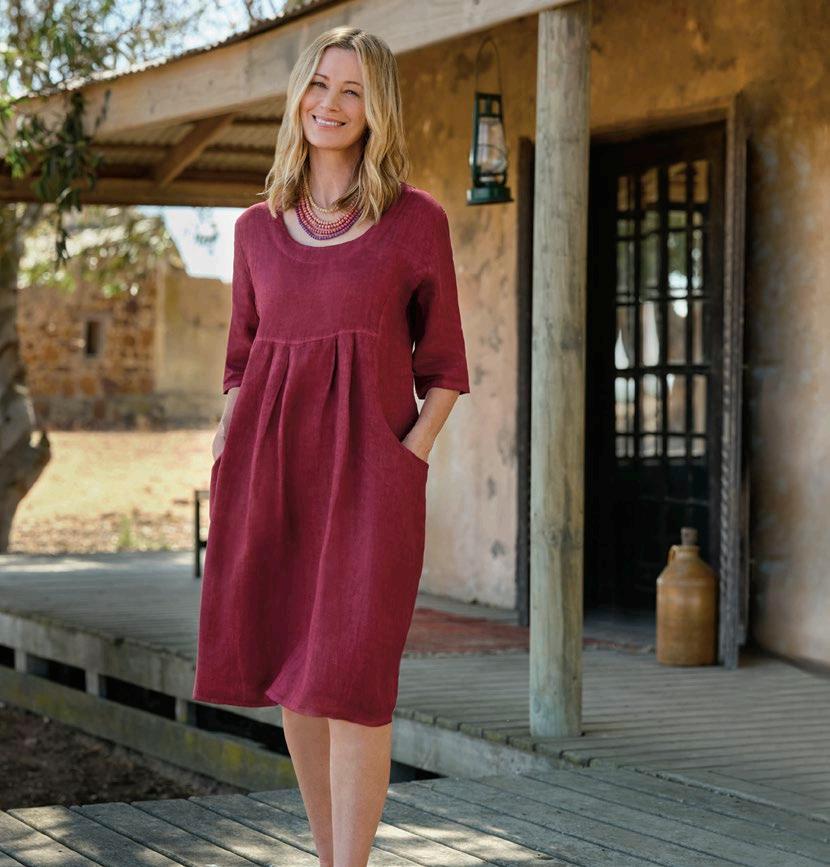




Linen Pocket Tunic Dress Ref: W104L ∙ WAS £69 100% Linen ∙ Machine washable Size: 8 ∙ 10 ∙ 12 ∙ 14 ∙ 16 ∙ 18 ∙ 20 ∙ 22 Rust Red *Terms & Conditions: Use code RRD1 for total saving of £27.00 including FREE standard delivery and returns for Mainland UK only. Offer ends 16th August 2023 and cannot be used in conjunction with promotional codes, multibuys or discounted items. Offer is valid on advertised styles (W104L) only. All orders are subject to acceptance under WoolOvers standard terms and conditions. Items can be exchanged or your money refunded, providing it is returned within 28 days from the date of purchase. WoolOvers shall not be liable for any washing errors or detergent damage. For full terms and conditions visit www.woolovers.com/terms. Exclusive offer for Reader’s Digest readers NOW £49 Use Code: RRD1 * Limited time only “Lovely dress, good quality, very easy to wear and ideal for the summer.” Wendy, Northampton SAVE £20 FREE delivery FREE returns 100% Linen Starburst Print Bright Green Mid Blue Tropical Leaf Print

Remember Like An Expert
Having a specialist subject helps you learn anything, says our memory expert, Jonathan Hancock
All three of my children were subject-matter experts before they even left primary school. My eldest son memorised every statistic on every football trading card he got his hands on. His brother knew hundreds of car makes and models by heart. And I’m sure that my daughter—a huge One Direction fan—remembered more facts about the band than they did! The experience of becoming an expert can bring long-term benefits for learning—and it’s never too late. Here are four good reasons for all of us to do a spot of specialist learning.
1. It hones our observation: a vital first step to remembering. Children are particularly good at seeing subtle differences—like my younger son and his cars—then using them to organise information and trigger recall. But focused learning like this can nudge anyone to start noticing key details— ready to remember them.
2. It gives us a mental framework, to which we can attach unrelated ideas. Even when his trading-card phase
was over, my son often linked new numbers with stored-away sports statistics. Your own area of interest might help you by suggesting soundalike words for people’s names, or letting you “map” travel directions.
3. It gets us learning in a variety of ways, often with the help of all our senses. My daughter’s pop knowledge was a rich mix of music, dances and colourful costumes, interwoven with precise facts. Immersing yourself in a subject prompts your brain to work at its best.
4. It restores our confidence to remember. We get to see what a difference it makes to be interested in something, to build up information in layers, and to keep refreshing, testing and showing off what we know. It can give all our learning a boost.
Why not pick a topic that interests you, find some books, take a course, join a club…and enjoy becoming at least an entry-level expert? Even a short spell of specialist study can reawaken learning skills that used to feel like child’s play. n
HEALTH
58 • JUNE 2023


Bone support for all the family in tablets, liquid or fizz




Osteocare® has pioneered the science of nutrition and bone health for over 30 years.
As Britain's favourite comprehensive bone health formula, its natural source calcium is carefully balanced with vitamin D (in the preferred D3 form), plus magnesium and zinc - which all contribute to the maintenance of normal bones.

Trust Osteocare, as your bones are your foundations for the future.




















and www.osteocare.com


























Osteocare® supports
Osteocare® is especially recommended for:
Pregnancy and breast-feeding
During/after the menopause
Older men/women
2023-04-13_ADOSTCONP_E
CHEWABLE TABLETS ORIGINAL TABLETS FIZZ LIQUID
†
supermarkets, chemists, health stores
UK’s No.1 VITAMINS UK ’s No.1 VITAMINS
From , Superdrug, Holland & Barrett,
*Nielsen GB ScanTrack Total Coverage Value & Unit Retail Sales 52 w/e 28 January 2023. To verify contact Vitabiotics Ltd, 1 Apsley Way, London NW2 7HF. †UK’s No.1 bone health supplement brand. Stockists may vary.
Can Cheating Ever Improve A Relationship?
Of all the sins you could commit in a relationship, cheating is seen as one of the worst. But could it also trigger a chance for a reset, which brings both partners closer together?

Monica Karpinski is a writer and editor focused on women’s health, sex, and relationships. She is the founder of women’s health media platform
The Femedic
To most Brits—80 per cent of women and 64 per cent of men—cheating is unacceptable, per a 2019 BBC survey. One in ten UK marriages ends due to infidelity. It’s not hard to see why. Cheating causes breakage: of trust and commitment, and perhaps our grand plans for what our life with that person could look like. However, it also forces pent-up feelings out into the open. Could this ever be a wake-up call to what needs fixing between two people?
I believe that it’s possible. But for a couple to emerge stronger from the wreckage, there needs to be an understanding that infidelity is nuanced—and, dare I say, a degree of compassion.
We see cheating as so repulsive that we tend to frame it in binary terms: there’s wrong and right, a villain and a victim. Not all situations are so clear-cut.
After all, a lot of us cheat—one in five, to be exact. Hurt people cheat,
60 • JUNE 2023 DATING & RELATIONSHIPS
happy people cheat, nonmonogamous people cheat (yes, really— cheating is about violating trust and boundaries, which feature in all healthy relationships). Some may cheat out of malice, but for others, it could be a desperate attempt to have their emotional needs met.
IT TAKES BEING WILLING TO FORGIVE, CHANGE AND BE OPEN
If you can try to understand someone’s reasons for straying, you can communicate openly and honestly with them about what happened. Then, you can start the work of healing.
It may be that your partner’s infidelity has nothing to do with you at all. According to renowned relationship therapist Esther Perel, cheating can sometimes be a way for people to try and connect with another version of themselves.
In an excerpt of her book, The State of Affairs: Rethinking Infidelity, republished in The Atlantic, Perel wrote that one of the most common sentiments unfaithful people voice to her about cheating is: “It makes me feel alive”.
When these folks turn away from their partners, she noted, they’re really trying to escape the person they’ve become within that relationship. Perhaps the affair makes them feel like someone who takes
more risks, or whose life feels less fixed in stone. Other times, people cheat because they feel they’re not getting what they need from their partner. In a 2015 YouGov study, 43 per cent of women surveyed said that they were driven to infidelity as they felt emotionally deprived in their relationship.
Addressing these issues is hard work. It takes a willingness to forgive and change, and to be open to what comes next. But if you can do it, there’s a chance your relationship will become healthier and more honest. You might see it as the two of you starting fresh; rebuilding the boundaries and promises that define your partnership. The unfaithful party might commit to bringing the parts of themselves they sought via their affair into your relationship, for example.
Patching things up isn’t always possible or desirable, and that’s OK. Sometimes, cheating is the final straw for a relationship already on its last legs. But it can be devastating in any case, and many relationships don’t survive it.
“Often when a couple comes to me in the wake of an affair, it is clear to me that their first marriage is over,” wrote Perel in her book. “So I ask them: would you like to create a second one together?.” n
JUNE 2023 • 61
Relationship Advice
Monica Karpinski
Q: I am over 50 and have always struggled to make friends, but I do have a small circle of people I see semi-regularly. But often, a lot of time passes between us catching up and I start to worry that the relationships aren’t strong and I’ll be left without any friends. Am I right to doubt this? And how can I feel better about it?
- Carl
A: You aren’t the first person to wonder if the quality of a friendship is reflected in how often you see each other.
In your defence, there is something to this: it takes effort to maintain friendships and they can decay if you lose touch over time. And if you’re someone who gets a lot out of socialising, it’s understandable that you’d feel down about not catching up very often.
But really, this is an insecurity that stems from the ambiguous nature of friendship. Unlike with family or a partner, there’s no formal structure to friendships: you participate only in the ways that you want to.
This uncertainty can make us doubt how our friends see us. It also means that people can have different
expectations for what a “good” friendship looks like, which may translate into how you act towards each other. For example, you might expect a close friend to talk and hang out with you regularly, but the other person might not need or want that level of contact to feel close to you. You might read the time elapsed between catch-ups as a sign your friends have lost interest in you, but this might have never crossed their minds. It’s possible they feel confident enough in the relationship to not feel the need to check in as much.
So, no—seeing your friends less frequently isn’t proof that they like you any less. But if you did want to hang out more often, there’s no harm in being the group organiser and getting something in the calendar.
Plus, you could always add to your circle by meeting new people. Making friends isn’t easy; it takes time and effort for everyone. But it certainly pays off when you find folks you click with. n
Got a question for our resident sex and relationships expert? Email it confidentially to thelovedoctor@readersdigest.co.uk
62 • JUNE 2023 DATING & RELATIONSHIPS







For your FREE brochure call us today: 0800 988 4232 Ref PCE455 Premier Care in Bathing - the UK’s No. 1 for stylish wet rooms, easy access showers and walk-in baths ■ A complete service that will transform your bathroom and your life. ■ The UK’s leading specialist for easy access walk-in baths and showers. ■ Peace of mind - helping tens of thousands of people for over 30 years. “My husband and I would like to thank you for the superb makeover. We are delighted with your service” Mr & Mrs R Pleasants www.premiercareinbathing.co.uk NOW WITH A 15 YEAR WARRANTY* Safer bathing from the mobility experts *Call 0800 988 4232 for more details

Curiosities Cabinets Of
INSPIRE

The weird and wonderful history behind private collections that became the first museums
by Harry Pearson
65
THE GARDEN MUSEUM
A stuffed crocodile at the Garden Museum, London
In the summer of 1634, an exhibition was held in a large house in Lambeth, London. It would have a major impact on the cultural life of England, and on cities far beyond our shores. It would set a fashion, in time becoming an institution. It would open up education to the masses, in much the same way the invention of the printing press had done two centuries earlier.
The exhibition was organised by John Tradescant. It offered the public the chance to view his collection, a wide-ranging selection of curious and fascinating objects—animal, vegetable and mineral—from all around the world.
One visitor summed up the amazement of what became known as "The Ark". Here was a place, he said, “Where a man might in one daye behold…more curiosities than hee would see if hee spent all his lifetime in Travell”.
Tradescant’s collection was part of a Europe-wide craze that had begun during the Renaissance. The Ark was a Wunderkammer, or cabinet of curiosities. Tsar of Russia Peter the Great, Holy Roman Emperor Rudolf II, Archduke of Austria Ferdinand II, and Augustus the Strong of Saxony all had collections that matched or exceeded Tradescant's Ark in size.
But there was an important difference, as Emily Fuggles, curator of the Tradescant Ark Gallery at the
Garden Museum, London, explains. “Until that point the Wunderkammer were the private collections of nobility and kings. John Tradescant and his son were quite different. They were professional gardeners. They threw their collection open to the public. The other great cabinets of curiosities were seen only by the rich and powerful. Tradescant’s Ark was seen by anybody who could pay the entrance fee.”
Those who did were in for a feast of the extraordinary. Georg Christoph Stirn, a German living in London who visited Tradescant's Ark, records that among much else he saw: two ribs of a whale, an ingenious boat made of bark, exotic plants, a salamander, an albino partridge, a chameleon, a powdered unicorn horn, a piece of wood from the Holy Cross, “a goose which has grown in Scotland on a tree”, an ape’s head, The Passion of Christ carved on a plum stone, “a very natural wax hand under glass”, some optical effects using paintings and “a number of things turned to stone”.
“Coming to look at the Ark became a popular day trip for Londoners,” Emily Fuggles says. “It was something new. A day out. It was very influential”.
As the Tradescant Ark illustrated, the Wunderkammer contained some very strange things. Viktor Wynd, author of The Cabinet of Wonders and owner of his own
CABINETS OF CURIOSITIES 66 • JUNE 2023

(Top) John Tradescant the Elder, 17th century. Artist: Emmanuel de Critz; (Middle) John Tradescant's guide to his Londonbased, pioneering cabinet of curiosities; (Bottom) Tradescant's Ark


READER’S DIGEST JUNE 2023 • 67
THE GARDEN MUSEUM
Wunderkammer in East London, explains, “I think my favourite exhibit from all the cabinets of curiosities is probably the one in Saint Petersburg which contains a collection of human teeth, all of which Tsar Peter the Great had extracted himself”.
The main idea of such eclectic selections was to create a threedimensional encyclopaedia that would encompass all human knowledge—to offer up nature in a nutshell.
Victor Wynd says, “The items were not arranged by chronology or type, but to look beautiful, pretty or intriguing. The collection was normally clustered together in a couple of rooms. The entire collection was on display. Nothing was hidden, labelled or explained. The visitor was free to interpret what they saw whatever way they wished.“
The cabinet of curiosities was founded on Greek philosopher Plato’s principle that “philosophy begins in wonder”. Amazement was the key. The Wunderkammer were places where imagination could simply run riot.
Art historian Giovanni Aloi comments, “This was a world in which science was not fully formed. Knowledge was based on observation. The mysteries of animal and plant reproduction were very little understood. For instance, it was believed that insects grew out of mud. So an exhibit in Tradescant’s
Dr Steve Simmons
Ark such as the Scythian Lamb, a type of Chinese fern that was believed to be able to move around like a mammal and give birth to young, seemed entirely plausible to people”.
The items in the Wunderkammer might be defined as natural history, geology, ethnography, archaeology, art and antiquities. Set side-by-side were things that were simply odd, weird, ingenious or inexplicable— clockwork automata, the hand of a mermaid. The overarching aim of all such collections was the stimulation of thought and conversation.
Tradescant's Ark was not unique. What made it special was—as Emily Fuggles says—the decision to open the collection to visitors. Although nobody realised it at the time, the Tradescant home in Lambeth had become Britain’s first museum. This situation was made permanent when Elias Ashmole bought the Ark and made the collection the basis for the Ashmolean Museum in Oxford, which opened in 1683.
The trend towards public museums quickly swept Europe. In 1727, Peter the Great’s collection— teeth and all—was moved from the Winter Palace to what would eventually become Russia’s Museum of Anthropology and Ethnography. Between 1723 and 1727, the Saxon royal family opened its own collection to the public in Dresden. Irish physician and collector Sir
68 • JUNE 2023 CABINETS OF CURIOSITIES
Hans Sloane’s Cabinet of Curiosities, stored at his house in Chelsea and consisting of 71,000 objects, would form the first collection to be housed in the British Museum.
In some cases the cabinets of curiosities remained intact, but that was not always the case, especially as time progressed. In the 16th and 17th centuries, when the Wunderkammer had been assembled, the boundaries of science had not yet properly been defined—astrology and astronomy were still viewed as the same thing, for example, and even learned men still believed in mythical creatures, such as mermaids and unicorns.
Clearly not all the exhibits were genuine, and many Wunderkammer owners seem to have known that. As
Giovanni Aloi observes, “There was a lot of one-upmanship. Aristocratic owners lied through their teeth about the provenance of the objects they owned. In a world in which fact checking was not a matter of simply doing a Google search, the owner of the cabinet’s claims were never challenged by others. The famous Fiji Mermaid, for example, was actually the upper part of the body of a monkey combined with the tail of a large fish.”
By the 18th century, however, a new breed of Enlightenment scientists had begun to reject such strange exhibits and turned against the eclectic approach of the Wunderkammer. The zoological, botanical and geological aspects of the collection were preserved
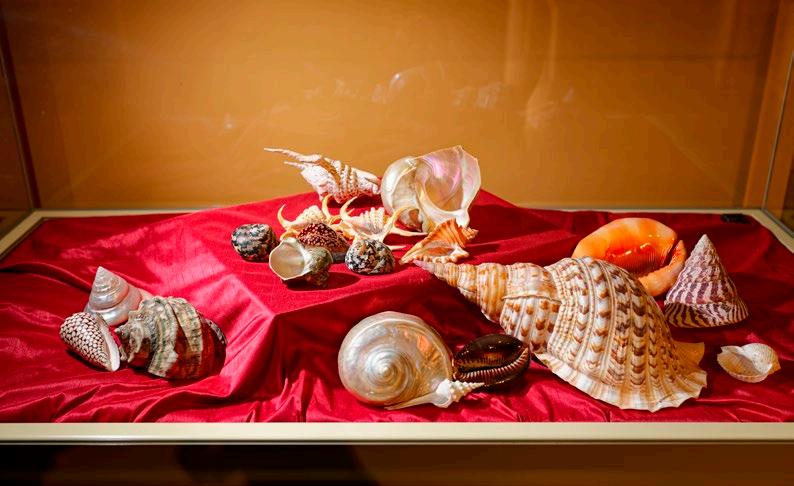
READER’S DIGEST
THE GARDEN MUSEUM
A range of exotic shells in the collection of the Garden Museum
in museums, while other elements were sold off—often to travelling showmen such as PT Barnum.
Giovanni Aloi explains, “Albert Einstein said that all scientific discovery is a flight from wonder. Western science has produced an incredible amount of knowledge of the natural world, and yet, in the process, it has also erased mythical or legendary content. In that way, perhaps, it has left our imaginations a little impoverished.”
Despite the move towards a more rigorous scientific approach to museums, some collectors still held to the philosophy of Tradescant's Ark. Bowes Museum at Barnard Castle in County Durham, which
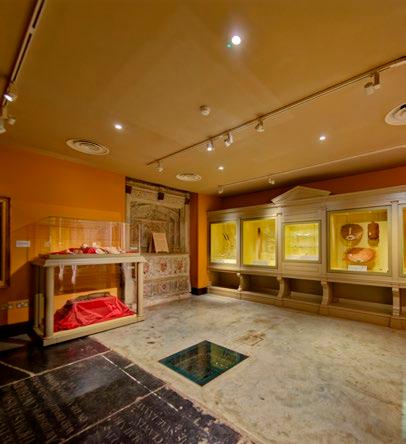
is home to the collection of John Bowes and his wife, Josephine, displays Canaletto cityscapes and Ming dynasty porcelain alongside the silver, clockwork swan that had astonished visitors to the Exposition Universelle in Paris in 1867.
The Pitt Rivers Museum in Oxford (which houses the 22,000 objects collected by army officer-turnedarchaeologist, Augustus Pitt Rivers) and Newcastle upon Tyne’s Great North Museum (based originally on the collection of 18th-century antiquarian, Marmaduke Tunstall) carry on showing similar weird wonders. Egyptian mummies, totem poles, preserved puffer fish, Japanese masks, albino birds, a

70 • JUNE 2023
CABINETS OF CURIOSITIES
The Garden Museum has many eclectic artefacts on display
THE GARDEN MUSEUM / VIKTOR WYND
Viktor Wynd’s museum in London
stuffed budgie (Sparkie Williams) who once knew 500 words—that would have pricked the interest of Renaissance antiquaries. But none of them have dragon eggs, mermaid hands or the flame-coloured tail feathers of a phoenix.
However, for those of us still looking for wonder, Giovanni Aloi has good news. Along with The Garden Museum and The Viktor Wynd Museum of Curiosities, Fine Art and Natural History (which combines old wonders such as Dodo bones with modern action figures) he says, “There are heaps of cabinets of curiosities open today. A great example is The Hunterian
Museum in London, which is a true scientific cabinet of curiosities. Although it is very, very scientific, the Sir John Soane’s Museum can also be seen as an architectural and artistic Wunderkammer”.
Viktor Wynd’s personal favourite is at Snowshill Manor in Gloucestershire, which houses the weirdly eccentric collection of Charles Paget Wade. It includes everything from mousetraps to Samurai armour.
Despite the changes in the way we view the world, the spirit of John Tradescant's Ark and the belief that, as Einstein also observed, “wonder is the basis of all true art and science”, lives on. n
Father's Day Origins
Father's Day has been celebrated among European Catholics since the Middle Ages when it was marked on St Joseph's Day (March 19)
In the US, Sonora Smart Dodd started a campaign in 1910 because there was a Mother's Day but no day to celebrate fathers like her Civil War veteran father
Over 50 years later, President Lyndon Johnson signed a presidential proclamation officially declaring the third Sunday of June as Father's Day
President Richard Nixon declared the day a national holiday in the US in 1972. The UK followed in celebrating Father's Day as an official day that same year
source: metro.co.uk
JUNE 2023 • 71 READER’S DIGEST

INSPIRE 72

My Britain:
Canterbury
Best known for its spectacular cathedral nestled among winding medieval streets, Canterbury is a Unesco World Heritage Site and one of the most visited cities in the UK. Inhabited since prehistoric times, it has a wealth of historic sites, including a city wall founded in Roman times and the ruins of a Benedictine monastery. The city has seen all kinds of populations, from Celtic tribes to French Huguenots to students and tourists today.
The Great Stour River winds its way through the scenic city, past Fransciscan gardens, antique book shops and crooked houses. Charming buildings, beautiful green spaces and a healthy selection of pubs attract up to 7.8 million visitors a year.
But what is it like to live and work in a stunning city that so many love to pass through? Locals share the secrets of life in Canterbury with Alice Gawthrop . ➺
JUNE 2023 • 73
Gary Jephcote is a team leader for Canterbury Museums and Galleries, managing the Canterbury Roman Museum and the Beaney Museum
canterburymuseums.co.uk
I’ve been living in Canterbury since 2009. I’m from Leicestershire and came here to study at Canterbury Christ Church University. After my degree I got a job for the museum service.
Canterbury is a picturesque city. The mix of medieval buildings with the cathedral makes for a fantastic view. We’re also lucky to have a beautiful river. During the summer it’s the ideal place to meet with friends for a picnic. There's always something going on in the city, but, if you want some peace, it's a tenminute walk into nature.
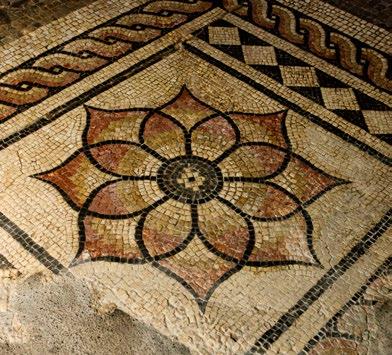

Living here you get a real sense of community. I’ve been here for almost 14 years and there is always someone I know when walking to work. There is also a lot of local pride in Canterbury. Recently the entrance to Canterbury Cathedral was refurbished and you could see how happy the residents were.
Canterbury Roman Museum takes you through the history of the Roman occupation in Canterbury and Kent. Our museum is set
alongside the remains of an insitu Roman Town House. The remains are impressive, boasting three floral mosaics and a hypocaust. It was rediscovered and unearthed in 1942, when Canterbury was bombed. Knowing the backstory of this unique period of history makes it humbling to work here. Illuminating the past is something I'm passionate about and it’s great chatting to visitors about the history of the museum and the Roman Empire.
We’re proud of the work we do with school groups too—it's often their first time in the wonderful world of museums. Also, handling Roman artefacts and getting up close with mosaics that date back 800 years makes my hair stand on end!
My favourite spot in Canterbury is along the River Stour during summer and watching the world go by.
MY BRITAIN: CANTERBURY 74 • JUNE 2023
Louise Knight is the clerk and receiver at Eastbridge Hospital and Franciscan Gardens, located on the site of the first Franciscan settlement in Britain
franciscangardens.org.uk
I have lived in Herne, Canterbury for 23 years. I was also born here and moved away to Guildford for over 20 years, but Canterbury has always been my home and I felt drawn back.
Canterbury is one of the most beautiful, popular and historic cities in England. It has something for everybody—history, archaeology, culture, diversity and entertainment. People who live in Canterbury are welcoming and extremely passionate about their city. We have a strong sense of community. We open our doors to international students and visitors.
It is an honour and privilege to work in such a beautiful location. The Franciscan Gardens change throughout the seasons and there is always something incredible to see. Located beside the River Stour, the Franciscan Gardens are the site of the first settlement of the Franciscan Friars, sent over in 1224 by St Francis to spread the word and work with the poor.
We have two amazing gardeners, Robert and Tracey, who care for this tranquil setting. These stunning gardens are the lungs of Canterbury,
hidden behind the bustling high street—a place of peacefulness, full of history.
On entering the gardens, the Friar’s Path takes you to the beautiful Wisteria Walk. Following on from this, is the Cloister Garth, and the stunning rose wall. New this year is the sunflower wall, in the Medieval Cutting Gardens. We grow many medicinal, herbal plants, vegetables and cutting flowers, which are given to our indwellers in the Eastbridge Hospital almshouses next door.
From early summer, our wildflower meadow bursts into bloom. It is next to Greyfriars Chapel, which is all that remains of the Franciscan friary destroyed by Henry VIII during the dissolution.
My favourite place in Canterbury is in the gardens under the blossom trees next to the river.


READER’S DIGEST JUNE 2023 • 75
Danielle Masters, 28, is the the assistant catering manager at Canterbury Cathedral Lodge, which is situated in the grounds of Canterbury Cathedral
canterburycathedrallodge.org
I’m from Derry in Ireland and as a child I would always say I wanted to move to England when I was older. Little did I know that I would!

I studied Hospitality and Tourism in Derry and I had to find a placement; a lot of the students went to Europe, but I chose Kent. I contacted two hotels, one being Canterbury Cathedral Lodge, and I’m so glad they responded. They had not taken part in a work placement before, so I knew I had to impress. Nine years later, I’m still here! I think it’s pretty amazing walking into work every day and enjoying the gorgeous grounds of Canterbury Cathedral. Not many people have such a great view.
The things I love most about Canterbury are the beautiful cobbled streets, the history, the people and the food. Canterbury is filled with many great restaurants, and there is always a fun buzz in the city. Everyone is so lovely and that helped me settle in, especially coming from Derry, which is smaller, but also a beautiful cathedral city.
Both Canterbury and Derry are walled cities, and I think that’s

helped me love Canterbury even more. All I have to do is take a stroll around the walls, and I’m reminded of home.
Canterbury has a lot to offer as there is so much going on, especially in the summer months. Being 45 minutes from London and 20 minutes to the beach is a bonus too. The weather is another thing I love about Kent; we aren’t as fortunate in Ireland to have such lovely sunny days as often as we do living in Canterbury.
At Canterbury Cathedral Lodge, we are known for not only our great service and people skills, but also our talented chefs. The local Kentish breakfast we serve always receives big praise from our guests from all over the world. The food in our hotel is great and all of us make sure our guests feel very much at home—I would say that’s why we have so many of them return.
They treat their stay like a little retreat, as the hotel location feels like an oasis in the middle of the city—it’s a real hidden gem. Having such stunning views of the cathedral does help, too!
MY BRITAIN: CANTERBURY
76 • JUNE 2023
Imogen Braiden is the area and event manager for Eleto Chocolate Cafe, a dessert shop that sells delicious crepes, cakes, coffee and, of course, chocolate
@eletochocolatecafe
I have lived in Canterbury for the past three and a half years. I moved here to continue my studies at the University for the Creative Arts.
Canterbury is captivating, as it’s such a melting pot for different cultures. There's always something to do and the town is always alive and buzzing. There are the night clubs or fellow cafes and pubs for those who prefer a quieter setting. With multiple universities, you’re guaranteed to find like-minded people and friends.
I’m incredibly lucky to have found the Eleto Chocolate Cafe when I did because I found such a wonderful group of staff and customers. All the staff are fantastic friends, some of whom live together and have found love here. We are a found family.
The cafe is such a nice and cosy place. We have a lot of students studying here. We hold events every month (keep an eye on our cafe socials), along with a private hire room. The cafe is open into the evening for those who wish to have a

The spirit of Canterbury is such a particular one. There are the wonderful, older buildings that have so much character to them right next to modern buildings. However, the composition of them within the street works. There are secrets hiding around corners as well—an architectural element, a bizarre place for a fire extinguisher or a horror story of Canterbury’s past residents.
cocktail, beer or glass of wine to unwind from the day, or perhaps see some friends. There's also everything chocolate, if you have a sweet tooth!
My favourite spot in Canterbury besides the cafe are the smaller streets just off the high street. That’s where you can find independent shops and restaurants. In Canterbury, there's always something interesting around the corner for you to discover. n
READER’S DIGEST JUNE 2023 • 77
MY BRITAIN: CANTERBURY
The World If I Ruled
Kate Rusby
Hailed as the “First Lady of Folk”, Kate Rusby is a Mercury Prize-nominated artist and one of the best-known contemporary English folk singers
NATIONAL SMILE TIME.
It would be a once-weekly occurrence, perhaps at 3pm on a Thursday. The country would pause for one minute and just smile at who is around them. Even better, try to make sure you are near someone who would really appreciate and feel the full benefit of that gift of a smile. Simple, easy, life-affirming both for the smile generator and smile receiver.
FREE BUSES
When I was young, one could travel anywhere in South Yorkshire for the fare of ten pence per adult, two pence per child. It opened so many doors to
workers, families, the lonely, the explorers—everyone. As a result, I discovered the beauty of the music department of Barnsley library. Music from around the world was available, and this was pre-internet! Adventures and opportunities lie at the end of a journey—I would make that journey free to all. Go discover, visit, work, learn, build, make good, all the things that make us better humans and a better society.
FREE SEEDS
Everyone would receive free seeds once a month. Seeds mostly to grow salad and vegetables, but also sometimes flowers, so we all have the opportunity to take pleasure in watching something grow. The mental health benefits of watching something grow have been proven time and time again, even in a pot in a window. Taking care of plants as they grow is such a calming, rewarding gift. We are lucky enough to have our own allotment so completely understand and appreciate the peace and beauty of growing plants.

VILLAGE/TOWN GATHERINGS
I think it would be so brilliant for villages and towns to have social gatherings at least
78
• JUNE 2023
once every two months. It would improve the mental wellbeing of so many people in the community. I come from a small village that has a gorgeous community feeling. We all look out for the most vulnerable. We used to have May Day gatherings and a village fête with each area making their own floats in secret, days full of memories of long, warm evenings, happiness and security, everyone just having fun together, with each other. Thankfully, we still have some village events that bring everyone together, but I wish it were so for everyone.
INSTRUMENTS BACK IN SCHOOLS
When I was at primary school, we all played the recorder and it was such a brilliant and free introduction to music. Now many people hate recorders, but what a fantastic part of school that was. It gave us all a basic understanding of how to read music—I always went off-piste and tried to harmonise, sometimes successfully and sometimes not! One year I was chosen to play “Little Donkey” for our swimming teacher at the local baths. I remember having to stand there at the side of the pool in my swimming costume playing the recorder while my class stared at the weird scenario! I was mortified but I did get through it. So many kids are missing out on music these days, but some schools have ukuleles, I hear. Still, the schools who play
music together are few and far between, so I say bring it back. Let them play music… just not so much in a swimming costume!
MANDATORY YORKSHIRE TEA IN ALL HOTELS AND SERVICES
I cannot describe the pure joy and happiness when I walk into a hotel room, cafe, restaurant, wherever and see they have Yorkshire Tea! It is, without doubt, the best tea on the planet. I always carry a stash with me in my case, and even a smaller emergency stash in my handbag, so wherever I am I can always have access to the drink of the gods. It should be mandatory worldwide.
BANNING USING CUTLERY WHILE EATING “HANDHELD” FOOD
I do have one thing I would like to ban. It won’t change the world but sandwiches, pizza, burgers, pasties, cake… so many foods do not require cutlery. Pick it up, enjoy the ancient pleasure of eating with your hands. Feel the food, get food on your hands, round your face, wipe your fingers on your clothes—it all washes off. There is great pleasure to be had eating with your hands. Come on, join in, get mucky! n
Kate Rusby plays Cambridge Folk Festival, July 27-30, 2023, as well as her own Underneath The Stars Festival, August 4-6. For tickets and more information, visit katerusby.com
INSPIRE
JUNE 2023 • 79

A HUMAN HISTORY IN RUST
In rubbish, there’s beauty—and hope for what can be renewed
BY Dorothy Woodend FROM THE TYEE
80
INSPIRE

Old tractor parts went into the creation of this buffalo sculpture in South Dakota
THE RELATIONSHIP
between people and their junk is a curious one. A 2022 documentary called Scrap shows just how oddly intertwined these two things can be.
When the film’s director, Stacey Tenenbaum, came across a photo of an aeroplane graveyard just outside of Moscow, the place’s ghostly quality—seemingly frozen in time— led her to wonder what happens to these kinds of things when they are no longer useful.
The film is chock-a-block with visual pleasure. Viewers float alongside retired trams and peer into the rotting husks of muscle cars, spotted with moss and lichen. But a harder message lurks beneath the lilting images: the way back from irrelevance and obsolescence demands work—often the hard, dirty and dangerous kind.
That humans use and then discard endless amounts of stuff isn’t exactly news. But how do we interact with what we throw away? The film showcases an alternative approach to the cycle of junking things once they’ve reached the end of their active life: there is worth in the saddest old hulks of rubbish, including a downed plane, a wizened train or an ancient phone booth. In fact, old stuff can be transformed into something not only useful but beautiful.
Take, for example, the iconic red phone booth, an object synonymous with the UK. Back in the 1980s, when Tony Inglis, who ran a trucking firm in England at the time, got the contract to remove phone booths that had fallen into ruin, he thought, We can’t just let them go.
So he started fixing them up. Over time, he purchased more than 2,000 of the decommissioned booths and set about resurrecting them: scraping off decades of buckled paint, replacing broken glass, slowly restoring dignity and handsomeness. Now, decades later, the refurbished booths are being put to a variety of new functions— everything from miniature libraries to coffee kiosks to defibrillator stations. There is something deeply soothing, even redemptive, about watching a person attend to the act of restoration with care and precision. Surely, if an ancient crusty thing can be brought back to a state of shining glory, humans can also be returned to a state of wholeness.
The film is as much about objects as it is about the people who love them. Consider Ed Metka of Kenosha, in the US state of Wisconsin. In the 1980s the retired civil engineer began purchasing out-of-service trams from several North American cities, including Toronto, with a plan to refurbish and resell the vehicles.
As a child he was enthralled by trams and watched the operators so
COURTESY OF JOHN LOPEZ
A HUMAN HISTORY IN RUST 82 • JUNE 2023
carefully that by the age of five, he imagined he was fully capable of driving them himself. “I was fascinated by the trolleys, by their appearance and their clicketyclackety sound.” Today, some of the trams he purchased are back in active service. “It’s very satisfying to see the streetcars up and running again,” says Metka.
The tenacity of metal, which stands long after fragile human bodies are gone, is the subject of South Dakota artist John Lopez’s metal sculptures. He welds old tractor parts, bits of machinery and rusty lengths of chain
into larger-than-life figures of buffalo, tigers and draught horses. In a stunning homage to his late father, he even created an ancient, gnarled tree covered with delicate pink metal petals.
As Lopez explains, part of his inspiration came from an old farming custom in South Dakota: dragging broken pieces of equipment up to the top of hills. “It just brings back all the memories from the old days,” says Lopez. “It has meaning, a lot of meaning.”
Poised against the landscape, the sculptures stand like dinosaurs,

PETER DAZELEY/GETTY IMAGES
READER’S DIGEST JUNE 2023 • 83
Old phone booths were given new life for this art installation in London
In Delhi, India, workers strip parts out of discarded mobile phones

markers of a time and place—and a lifetime of work. His intent was that the relics would take on new life as conversation pieces, and so continue to be useful.
In another part of the world, abandoned machines become a home for families and a source of income. Just east of Bangkok, Thailand, Fah Boonsoong and her kids and grandkids live in a hollowedout jumbo jet aeroplane—just one of many spread across a field. Tourists pay to take photographs with the derelict planes.
As the kids bounce up and down on the wings of the aircraft, their grandmother talks about being the caretaker of this aeroplane graveyard. But she takes issue with the word “graveyard,” insisting this is a vibrant
community, alive with laughing, playing kids. “Graveyards are for the dead. We’re living people, not spirits.”
Resurrection is also the focus of architect Tchely Hyung-Chul Shin, who works in South Korea and France. His architectural firm repurposes sections of old tankers and cargo ships into churches and other structures. Freed from rusting turpitude and fashioned into soaring vaulted spaces, ships’ hulls, ribbed like the inside of a whale, become things of airy beauty.
But such startling transformations aren’t easy. Cutting massive ships into their component parts is gritty, rough work. Retired vessels are sourced around the globe, but the reconstruction takes place mainly in Spain, where an international team of shipwrights disassemble the boats. Scrap shows extraordinary scenes of
SAUMYA KHANDELWAL
84 • JUNE 2023
the behemoths being dragged out of the water, turned on end and sliced into parts.
As Shin explains, when wiping away decades of accumulated rust from a section of hull, he feels connected to these old aquatic warriors like he does members of his own family. “There is a lot of emotion when I see these pieces and this boat. It’s like taking care of a friend or a parent.”
Meanwhile in the US, the disintegrating hulks of old cars emerge out of the landscape of White, Georgia, like some new type of growth. Throughout the 14-hectare site—known as Old Car City—more than 4,000 vehicles have permanent parking spaces, and curious sights emerge from the gloom. Atop a 1950s roadster heaped with pine needles, an abandoned doll pokes out. Some vehicles have been here so long that trees have grown through them. It’s kind of beautiful, and a little eerie.
Proprietor Dean Lewis sees the White junkyard as a kind of a museum. “It’s art, nature and history,” he says. Lewis inherited the place from his parents, who started it as a used car shop in 1931, but since then it has evolved into something more akin to a kingdom of decay.
From the hand-painted signs that declare “The Meaning of Life is to give Life Meaning” to the worn dirt paths carved through the woods, the place is a distinctly rustic venue. The constellations of automotive rust
possess great beauty, patterns and colours stippled on the metal exteriors like a modernist painting. It is both lovely and sad: the hopes and ambitions of another age slowly disintegrating into rust and dirt.
“WHEN THERE IS SOMETHING THAT BOTHERS ME, THE ONLY THING I CAN DO IS PHOTOGRAPH IT”
In other parts of the world, the scale of disposable culture takes on epic proportions. In Delhi, old mobile phones and TVs are dismantled by workers who make a living stripping the parts out of junked technology. Photographer Saumya Khandelwal documents the lives of these workers, her images driven by a need to do something in the middle of a juggernaut of waste: “When there is something that bothers me, the only thing I can do is photograph it.”
The intermingling of decay and new life makes for an interesting conjunction. The sheer magnificence of elemental, brutalist scrap remade into beautiful things is a reminder that with care and love, anything can be brought back from the brink. n
© 2022, DOROTHY WOODEND. FROM “HUMAN HISTORY IN RUST,” BY DOROTHY WOODEND, THE TYEE (OCTOBER 21, 2022), THETYEE.CA
READER’S DIGEST JUNE 2023 • 85

WIN £500
fashion
Feeling the need for a wardrobe refresh?
Put a spring in your step and switch up your look for the new season as we’re giving one lucky reader the chance to win £500 to spend with Cotton Traders The British brand’s latest collection features bold prints, colourful patterns and delicate details, bound to bring a fun new twist to your wardrobe. Whatever the occasion, Cotton Traders has you covered!
Question: Is Cotton Traders a…?
A. British Brand B. American Brand C. French Brand
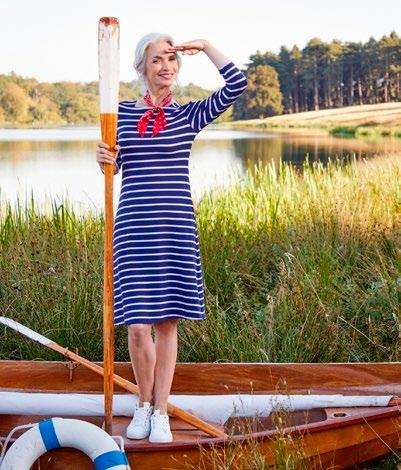
Simply answer A, B or C on the entry form or enter online. See page 151.


Shop the full collection at www.cottontraders.com Terms & Conditions: This prize is for a £500 Cotton Traders gift voucher which can be redeemed online or at any Cotton Traders Stores (excluding Saint Asaph, Crawley and Diss stores). For full terms and conditions visit cottontraders.com
spend at British
retailer,
To
Cotton Traders!
COMPETITIONS

To spend on Arena Flowers
At Arena Flowers, they are committed to growing the best products possible with the least impact on the planet.
With every bouquet you make a choice to support ethicality which helps Arena to make a positive impact on the world.
Every order they receive is arranged and hand-tied by their florists to create a unique bouquet.


We have £200 to spend on gorgeous flowers! Visit www.arenaflowers.com to order.

FIND WORDS OF THREE OR MORE LETTERS, AND ALL MUST CONTAIN THE CENTRAL LETTER.
TARGET:
Excellent: 20 or more words. Good: 15 words. Fair: 10 words.
There is one word relating to a flower that symbolises love which uses all the letters – write this word on your entry form or enter online. See page 151 play the summer wordwheel £200 to spend WIN!
I R T C N O A N A
SUMMER WORDWHEEL – WIN £200
COMPETITIONS






Get Gardening!
As the weather warms up, there’s no reason not to get out and get gardening
Whether it’s for your health, environment— or your wallet—
gardening has seen a boom in recent years. Over 7 million people have taken up gardening since the pandemic, with incredibly positive results.
Research has shown that spending more time outside is key to the nation’s well being. Nearly two thirds of UK adults said that taking in the colours, sights, smells and sounds of the great outdoors by gardening or being surrounded by nature helped with their mental wellbeing and lowered stress levels. And 43 per cent said that looking after houseplants or growing food or plants in window boxes also boosted wellbeing showing that you don’t need a big
garden to reap big rewards. Now is a great time to dig out your trowel and get your hands dirty in some sumptuous soil—wellies on or not, so here are our top reasons to get gardening this year:
Pick your own
There’s nothing like eating your own vegetables. From picking your own strawberries or unearthing the first new potatoes of the year, homegrown veg is a joy. It simply tastes better. Whether that’s down to the triumph of simply growing your own or eating it when it’s at its freshest, once you start home growing you may never stop. You don’t need to have a large plot to do so either. Herbs and smaller veg are more than happy in pots on windowsills or small balconies, and
JUNE 2023 • 89
are easy to grow from seed. Don’t forget that a windowsill garden should also provide colour as well as be useful, so experiment with different varieties for attractive foliage and variegated leaves. Often the tastiest and most beautiful varieties are only available if you grow your own. Companies such as Real Seeds (realseeds.co.uk) provide some great options for more unusual varieties of “normal” veg, such as white beetroots and purple mange tout. Are you worried about what to plant when? Simply visit Thompson and Morgan’s website (thompson-morgan.com) for some very handy info on what fruit and veg can be sown across each month of the year for a never-ending supply of produce.
Community conversations
Over the garden fence. At the allotment. While weeding your window boxes. It’s amazing who you talk to when you’re enjoying tending to your plants or veg. Simply being out and about in your garden invites interaction and conversation with neighbours and people in your local area, which in itself has multiple social and wellbeing benefits. Additionally, whether you’re a learner or a keen gardener, community gardening groups can also be invaluable for information sharing. Local seed and plant swap groups are also a great way of
meeting people and getting rid of unwanted—yet perfectly good— surplus plants, or gathering cuttings to keep the cost of buying plants down.
Stay healthy
Did you know that the amount of calories burnt from 30 minutes of gardening is comparable to playing badminton, volleyball or practising yoga? From digging to weeding to lopping and mowing, there’s a whole world of muscle movement when you’re planting and tidying. However, ensuring you’re completing jobs with minimal strain and risk of injury is imperative. Research carried out by the RHS and Coventry University shows that a good digging technique was found to have minimal backbend and a large knee bend, so be mindful and make sure you’re saving yourself from a future potential bad back..
Wild at heart
Don’t forget the wildlife. Gardens are a vital home for many species and watching visiting birds, bees and butterflies can be incredibly rewarding and relaxing for you. Try to choose the right flowers and plants that offer pollen and nectar for as long as possible from spring to autumn.


90 • JUNE 2 023
GET GARDENING!


Benefit from our expertise and invest in highquality residential and commercial property projects in the South West region.
• Invest from just £10,000
• Hands free property investing
• Sustainable building practices
• Offices in London, Bristol, Exeter, Cardiff, and Cornwall
• Development value of over £400+ million
• Benefit from stable and diversified demand in the South West

Request our Investment Guide today to learn more and find out more about alternative property investment opportunities in the South West of the UK. Scan the QR code or visit lp.acornpropertyinvest.com/investments
Don’t invest unless you’re prepared to lose all the money you invest. This is a high-risk investment and you are unlikely to be protected if something goes wrong. Investment available only to High-Net-Worth or self certificated sophisticated investors.

The content of the financial promotions on this website has not been approved by an authorised person within the meaning of the Financial Services and Markets Act 2000. Reliance on these promotions for the purpose of engaging in investment activity may expose an individual to a significant risk of losing all of the property or assets invested. SCAN ME
Call us on: +44 0203 858 9881
A fresh take on UK property investments
To attract birds, provide food and water all year. Feeders take up little room and even if you’re short on outdoor space, some, such as Nature’s Hangout Window Bird Feeder, can be attached to window panes directly. This allows you to watch birds close up from the comfort of your home.
Gadgets galore
For those who want them, gardening offers gadgets galore. From robotic lawnmowers, such as Gtech’s Robot Lawnmower RLM50, which senses obstacles and rain, and takes itself off to recharge; to Hozelocks Thermal Weeder, which blasts weeds with a thermal shock of up to 600 degrees; to Ikea’s Chilipulver, a soil moisture sensor which senses when your plants need water, there’s a huge array of tools that can make your (gardening) life easier.
Staying stylish
Alfred Wainwright once wrote, “There’s no such thing as bad weather, only unsuitable clothing”. So if you’re an all-weather gardener, make sure you’re dressed for the elements. Technical fabrics can do wonders to keep you dry or help you stay warm or cool in all weathers, so look out for Gore-Tex or Thinsulate on the label. A
hat can also be brilliant at keeping the sunshine at bay—and a nifty Panama can also bring a sense of style when weeding and pruning.
If you’re looking for something aimed literally just for the greenfingered, UK clothing company Genus (genus.gs) claims to be the world’s only brand of highperformance, technical clothing specially designed by gardeners for gardeners. With specially made pockets for tools, you’ll never lose your secateurs again.
A time to relax
It’s not all hard work. There are many ways to enjoy your outside area which don’t involve getting your hands dirty. A space for entertaining or relaxing can help you enjoy your garden even more—and let you take a moment to survey your hard work. A barbecue or pizza oven can get the party started, but choose a comfy seating option to lounge on with a glass of something chilled. The Roma Rattan Garden
Furniture Modular Lounge Set, from Out and Out Originals—with two corner chairs, two matching footstools and a coffee table is a good option as it can be rearranged to suit your space and needs. n
GET GARDENING! 92 • JUNE 2023














SCAN OR VISIT OUTANDOUT.COM TO VIEW OUR FULL RANGE OF GARDEN FURNITURE CLEARANCE OFFERS. *Excludes delivery. See website for details. While stocks last. Prices correct at time of going to press. **On selected products only CLEARANCE SALE! 60% OFF CHESTERTON Corner Rattan Set
Contemporary corner sofa with matching glass-top coffee table • Virtually maintenance-free with thick comfy cushions • Made from heavy duty polyrattan and strong steel frame NOW £599.60* PLUS! WEATHERPROOF COVERS - AVAILABLE ON MOST SETS AND ON SALE FOR JUST £132** STOCKHOLM Chaise Lounge Set with Armchair NOW £399.60* EXPRESS DELIVERY AVAILABLE • Consists of one 1 chaise seat, a two seater sofa, 1 armchair and a wood-effect coffee table • Virtually no maintenance needed
•
Fort Lovrijenac dates back to the 11th century

paradise between the mountains and the sea
Dubrovnik has seen more than its share of calamities, but it has never lost its appealing spirit
BY Chris Wright FROM HEMISPHERES
TRAVEL & ADVENTURE 94

Standing on my hotel balcony on my first morning in Dubrovnik, I can see that the city hit the jackpot in terms of physical appeal. To my left is the green nub of Lokrum Island; to my right, a surging mountainside; and, straight ahead, the craggy coastline of the Adriatic Sea, culminating in the fortified walls of Old Town.
That physical appeal perhaps explains why, in spite of all manner of historical calamities—a 17th-century earthquake, Cold War Communist oppression, the Croatian War of Independence of the 1990s—the 40,000 people who live in this Croatian city burst with good humour, hope and resilience, and a sense of belonging. Irish playwright George Bernard Shaw once described it as “paradise on Earth.”
I descend the tree-shaded terraces and plop into the sea, enjoying the sense of seclusion before the scurry that lies ahead. Today, I’m exploring Old Town, a concentration of churches, palaces, fortifications and family homes hemmed in by the battlements and turrets of the city walls. Even before I got here, I had a mental image of all this thanks to Game of Thrones (Dubrovnik was one of its major filming locations). But there’s more to Old Town than what was presented in the TV blockbuster.
I enter the walled section via the medieval Plocˇe Gate, overseen by a statue of Sveti Vlaho, the city’s patron saint, also known as St Blaise. The real story of Dubrovnik (formerly Ragusa) begins in the seventh century, the plot line threading through years as an independent republic and thriving trading hub, occupations by foreign powers, plagues and palace intrigues. For all the seeming might of its fortifications, Old Town (a Unesco World Heritage Site) has seen its share of devastation: a 1667 earthquake levelled the ancient city, and artillery fire rained down in the 1991–92 Siege of Dubrovnik.
The blocky limestone used in the post-quake rebuild is both sturdy and lovely to look at—luminous in the daytime, sepia-toned at night. But be warned: the stones on the main street, Stradun, are slippery when wet. At one point, I catch the eye of a pigeon as it slips and falls on a damp patch; it’s an awkward moment for both of us.
JUNE 2023 • 95
Old Town’s historical hodgepodge comes to a head in Luža Square, which is skirted by Baroque, Gothic and Romanesque structures. Two of the city’s most dazzling churches are here—the Church of St Blaise and Dubrovnik Cathedral—along with the grand Marin Držic ´ Theatre, whose namesake author sits outside, cast in bronze, his nose shiny from generations of rubbing.
At the entrance to the 15th-century Rector’s Palace, one of the few buildings to have survived the quake, I make my way past a profusion of cherubs and vaulted arches. Beyond the colonnaded courtyard is a crypt containing an exhibition of photographs of the Siege: burning houses, kids playing in the rubble, boarded-up shopfronts daubed with images of angels, boats and birds.
Crisscrossed by narrow alleys, which invariably lead to a precipitous flight of steps or a cockeyed square, Old Town is not easy to navigate—which is fine when you’re having a stroll, but not so great when you’re late for lunch. Finally, I find Taj Mahal, a cosy Bosnian eatery known for its hearty traditional fare, and order buredžike, meat-filled pastries topped with sour cream, followed by hadžijski c ´ evap, a beef and veggie stew.
At the end of Stradun, near the 15th-century Pile Gate, is the Large Onofrio’s Fountain, whose ornate spigots have trickled since 1438. I take a sip and cross Stradun to the
Franciscan monastery, which is home to an order that dates back to the 1300s, along with an apothecary museum that displays the scales, pipettes and cauldrons the friars used while dabbling in medicine.
I could use a restorative tonic myself, so I head for Buža Bar. Hewn into cliffs below the city walls, it invites guests to perch on tiny vertiginous terraces, suggesting a lax approach to health and safety but a staunch dedication to social media accounts like Instagram. I totter onto one and order an Aperol spritz with a splash of vertigo. “People sometimes jump in,” the waiter tells me, nodding at the frothy waves below, “but not everybody likes that.” You don’t say.
I later put Google Maps to the test as I search for my dinner destination among the alleys, some lined with gift shops and bars, others draped with laundry and potted plants. Eventually I find the Jesuit Stairs, which were modelled on Rome’s Spanish Steps. At the top stands the wildly ornate St Ignatius Church; beside this is Kopun, whose menu puts a modern spin on Croatian standards.
Ana Bitanga, Kopun’s affable manager, waves away the idea that I try something light. “Carbs,” she says, delivering a šporki makaruli (pasta in beef sauce). “We also serve it with croquettes—because if you can fry carbs, even better.” Then come capon stewed in a porcini mushroom sauce and served with forest berries, a
PARADISE BETWEEN THE MOUNTAINS AND THE SEA
96 • JUNE 2023
platter of baked peppers and a refined peasant-food dessert of egg custard, oranges and biscuits.
“People here have a love of comfort,” Bitanga notes. “Thank God for all the stairs.”
Back at the hotel, I take in the view from the terrace. Old Town’s glowing walls seem to be suspended between sea and sky, like something straight out of a fairytale.
THE NEXT MORNING, I take the 15minute ferry ride to Lokrum. There are dozens of islands around Dubrovnik, but Lokrum is especially popular—partly because of its proximity to the city, partly because of its staggering beauty. Half a mile long, the island bristles with a continent’s worth of plant species. It also has fantastic beaches, a salty
lake known as the Dead Sea (not to be confused with the one by the same name in the Middle East) and a lush botanical garden.
Bands of assertive peacocks, descendants of birds brought here in the 1850s by Austria’s Archduke Maximilian, roam the ruins of an 11th-century Benedictine monastery. A bracing climb up a nearby hill leads to the stocky turret of Fort Royal, from where Napoleon’s occupying troops trained their sights on Old Town’s terracotta roofs.
After returning to Old Town, I take a half-hour drive up the coast to Brsecˇine Harbour, where I board a motorboat and hurtle toward Šipan, the largest of the Elaphiti Islands. The boat docks at BOWA, a family-run restaurant set on a secluded, wooded beach. At this cluster of stilted
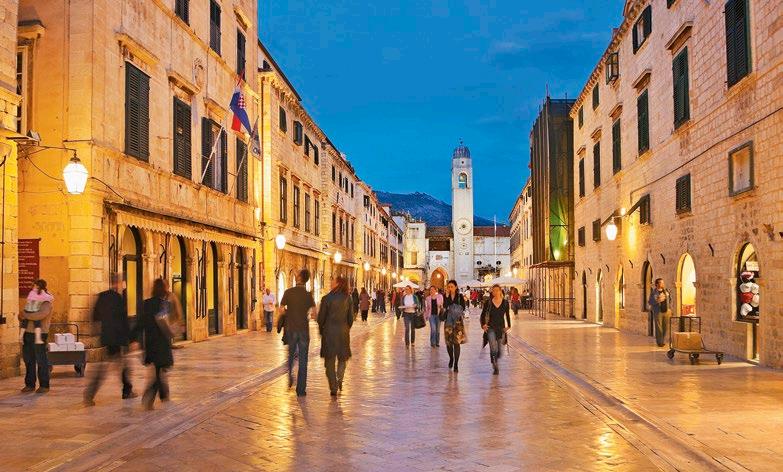
(BELOW) GONZALO AZUMENDI/GETTY IMAGES READER’S DIGEST
Stradun, the main street of Dubrovnik's Old Town
cabanas and a dinky old stone building that doubles as the kitchen, I tuck into platters of seared tuna belly, swordfish ceviche and grilled octopus. Even the salt is diligently curated, crystallised from local pools. My extended lunch continues up the coast in Mali Ston, a medieval town known for defensive walls that snake into the hills behind it. I join a small group aboard another boat and head out to a floating platform, where a crew member hauls up a rope festooned with shellfish. Bobbing on the bay, slurping oysters right out of the sea and sipping white wine, it’s a fine way to spend a sunny afternoon.
first stop is Urban & Veggie, a snazzy vegan restaurant across from Luka Gruž harbour. “This is a city of meat lovers,” says owner Ivo Dadic ´ , seated on the vine-draped back terrace, watching as I devour a splendid vegan kebab. “People thought I was mad when I opened, but we are changing minds.”
It’s a short walk to TUP, a complex that’s the centrepiece of the neighbourhood’s revival. Among the enterprises that have set up in a former carbon graphite factory are a music studio, a brewery and a ceramics workshop.
There’s also the Red History
OLD TOWN’S WALLS SEEM TO BE SUSPENDED
BETWEEN SEA AND
SKY, LIKE SOMETHING OUT OF A FAIRYTALE
That said, I have another historic coastal town to visit: Cavtat, about eight miles south-east of Old Town. We dock beside a pretty promenade bracketed by 15th-century landmarks: Our Lady of the Snows Monastery and the Church of St Nicholas. Inside the latter is a painting of Christ ascending over the town, which is equally inspiring and panoramic.
I HEAD OUT the next morning to Gruž, a hip industrial neighbourhood a few minutes north of Old Town. My
Museum, which houses a beguiling clutter of artefacts from the city’s decades under Communist rule, including a vintage Yugo car and a series of rooms set up like a typical 1970s Croatian household. Visitors are encouraged to nose through the cabinets, listen to a Beatles cover band on headphones or tap messages on a clunky typewriter. At one point, I thumb through a magazine that has American actress Linda Evans on the cover. Apparently socialist workers watched Dynasty.
(CLOCKWISE FROM TOP) DAVID CLAPP/GETTY IMAGES; ANADOLU AGENCY/CONTRIBUTOR/GETTY IMAGES; DAVID C TOMLINSON/GETTY IMAGES; ALAN COOKSONLIVERPOOL/GETTY IMAGES; BIGBEAR JIANG/500PX/GETTY IMAGES PARADISE BETWEEN THE MOUNTAINS AND THE SEA 98 • JUNE 2023

Clockwise from the top: Bathing in the Adriatic Sea; one of the cruise boats that ply the coast around Dubrovnik; Sveti Vlaho, the city's patron saint; the cable car on Mount Srd; a vineyard in the Dubrovnik region





from


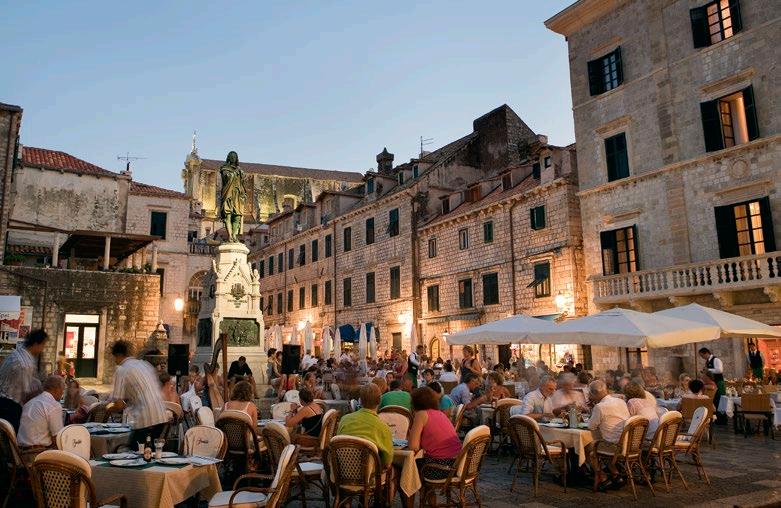 Clockwise
above: A peacock in Dubrovnik; a woman in medieval garb performs in front of the Church of St Blaise; the historic city walls; a bustling evening in Old Town
Clockwise
above: A peacock in Dubrovnik; a woman in medieval garb performs in front of the Church of St Blaise; the historic city walls; a bustling evening in Old Town
After lunch, I take a quick detour to the waterfront Cave Bar More, where you can sip fancy cocktails in a troglodytic setting. I can’t help but try the Game of Thrones cocktail, made with pink gin, golden falernum, blue Curaçao, tonic and something called “magic mix.”
On my way back to Old Town, I catch the Dubrovnik cable car, which trundles to the peak of Mount Srd, 412 metres above sea level. The journey
mountains and sea. “The birds enjoy the vines, too,” Vlašic ´ tells us. “My father says that the only reason they eat the grapes is because they’ve never tried the wine.”
Back at Old Town, I take a final sightseeing foray: a walk atop the incredible city walls, over a mile looped walk that provides an intimate perspective of the historic quarter. At one point, I turn my attention away from Fort Lovrijenac
THE RED HISTORY MUSEUM HOUSES A BEGUILING CLUTTER OF ARTEFACTS FROM THE CITY’S TIME UNDER COMMUNIST RULE
up is a nail-biter, but it’s a small price to pay for what has to be the best view in town.
Later that afternoon, I meet Ivica Vlašic ´ , who drives me to his family’s vineyard six miles east of the city. Nestled in the foothills of Malaštica mountain, Vardia is not the largest vineyard around, but that’s part of its charm. “We do everything ourselves,” Vlašic ´ says, leading a small group along a steep trail. “At harvest time, friends help—each chooses a row to pick, and at the end we have a big barbecue for everyone.”
The wine—a crisp, citrusy white—is fantastic, as is the spot where we’re drinking it, surrounded by olive, fig and cherry trees, overlooking
and lock eyes with a man standing at his kitchen window. The moment serves as a reminder that Dubrovnik is more than just a conglomeration of domes or a postcard-pretty sprawl of red roofs. As a talented local artist had told me earlier: “This is home. I belong here.”
Dinner is at Restaurant 360 Dubrovnik, a Michelin-starred standout built into the city walls, and I take my seat overlooking the old port as the bell tower clangs. The food is wonderful, as is the wine, not to mention the view. I can’t recall the last time I felt so thoroughly happy. I say this to the guy clearing my table. He smiles, and says, “Dubrovnik will do that to you.” n
(CLOCKWISE FROM TOP LEFT) HONEY INTING/EYEEM/GETTY IMAGES; MICHELE WESTMORLAND/GETTY IMAGES; PIOTR JACZEWSKI/GETTY IMAGES; DANNY LEHMAN/GETTY IMAGES
READER’S DIGEST JUNE 2023 • 101

WIN!
A three day getaway with Macdonald Resorts
One lucky reader has the chance to discover the sights and sounds of summer and win a staycation with Macdonald Resorts.
Set in some of the most picturesque locations, from the sparkling Solent Coast and the southern tip of Snowdonia National Park, to the spectacular mountains and ancient pine forests of the Scottish Highlands, Macdonald’s five UK Resorts are ideal for self-catering family holidays and active getaways.
What’s more Macdonald Resorts are pet-friendly so you need not leave your four-legged family member behind.
With championship golf courses, acres of gardens and even National Parks on your doorstep with ample walking, hiking, running and cycling trails, the activity
options are endless. The Resort locations also lend themselves as a convenient base to explore neighbouring towns and visitor attractions.
However if tranquillity is more your speed, indulge in the relaxing spa facilities onsite, meaning there is a break to suit everyone at Macdonald Resorts, no matter your interests.
The prize includes up to three nights self-catering stay in a three bedroom lodge with dinner included on the first night.
With more than 20 years’ experience of providing holidays, a Macdonald Resort break is always memorable.
For more information about Macdonald Hotels & Resorts or to book directly visit: www.macdonaldhotels.co.uk/self-catering
www.macdonaldhotels.co.uk
Question: Where can you find one of the Macdonald Resorts?
A. London
B. Liverpool
C. Snowdonia National Park
Simply answer A, B or C on the entry form or enter online. See page 151.
T’s & C’s: Prize must be redeemed by 30/11/23. Prize is for a three night stay in a three bed self-catering lodge. Entrants must be over 18 years old. The prize is subject to availability, non-transferable and there are no cash alternatives. Limited availability during school and bank holidays. The prize is eligible to be redeemed at the following properties: Elmers Court Resort, Forest Hills Resort, Lochanhully Resort, Plas Talgarth Resort, Spey Valley Resort
COMPETITIONS








MUSIC WITH A VIEW
TRAVEL & ADVENTURE
Festival, Switzerland
Verbier
Summer may well be the favourite season of classical music lovers, with numerous festivals spanning all genres and composers taking place worldwide. And what’s better than enjoying a live performance of your favourite piece? Enjoying it in the great outdoors, of course!
Here, Rosie Pentreath rounds up some of the best classical music festivals taking place in unexpected and spectacular locations around Europe this summer
Verbier Festival, Switzerland
nestled in the breathtaking Swiss Alps at 1,500 metres altitude is a picturesque little village called Verbier. While it may be best known as a premiere skiing resort that attracts everyone from the royal family members to music and film stars, there are plenty of reasons to visit it in the summer, too. One of the main ones? The Verbier Festival—a magical twoweek celebration of classical music at the top of the world.
The festival has become known for attracting the biggest soloists in the world, and this year, marking its 30th anniversary, is no exception. Chinese pianist Yuja Wang takes on Rachmaninov’s monumental Third Piano Concerto with conductor Zubin Mehta, while the young superstar
cellist Sheku-Kanneh Mason performs Elgar’s enduringly beloved Cello Concerto. Fellow cellist Yo-Yo Ma joins for a sumptuous programme of chamber music dedicated to Ludwig van Beethoven. Some of the other performers will include Renée Fleming, Evgeny Kissin, Lisa Batiashvili and many others.
As well as experiencing these sensational performers in some of the most spectacular alpine scenery Europe has to offer, the real magic of Verbier is its ethos of connecting great musicians at the height of their careers with aspiring young artists, through the Verbier Festival Academy. This year, 223 students from all over the world will receive training and attend masterclasses with the greats.
July 14 - July 30, verbierfestival.com
JUNE 2023 • 105
© ALINE PALEY
Granada International Festival, Spain
sticking with mountains, in the foothills of the Sierra Nevada in Southern Spain the spectacular Alhambra Palace can be found glinting red under the Andalusian sun. Since 1952, the International Festival of Music and Dance of Granada has taken up residence in the palace and its opulent gardens during the months of June and July, to showcase classical music, opera, ballet, Spanish dance and flamenco.
The magnificent Palace of Charles V houses the large orchestral performances and big international soloists, while the outdoor Generalife Theatre, opened by the festival in 1954 as the main venue for ballet, presents the visual spectaculars of the Spanish National Ballet, Hamburg Ballet, Spain’s National Dance Company
and the fiery flamenco of the Antonio Navarro Dance Company. Legendary singer-songwriter Bob Dylan will also draw crowds to the breathtaking Generalife.
In 2023, performances by Icelandic pianists Víkingur Ólafsson, Daniil Trifonov and Igor Levit, the Orchestre des Champs-Élysées and Philippe Herreweghe in music by Mozart and Beethoven, and a sumptuous concert version of Puccini’s Turandot from the orchestra of the Teatro Real and star soloists are among the classical music highlights. As in previous years, the festival will team up with University of Granada to invite prodigious students to take part in the Manuel de Falla Courses, which offer masterclasses and workshops in composition, musical analysis, performance and more.
June 21 – July 19, granadafestival.org

MUSIC WITH A VIEW

Puccini Festival, Italy
la Bohème. turandot. Madama
Butterfly. Nothing quite matches the high drama and intense, Italian Romanticism of operatic great, Puccini. And what better than experiencing them at Torre del Lago, in the Viareggio region of Italy, a place Puccini himself called home?
The charming village has been affectionately renamed “Torre del Lago Puccini”, and the spectacular open-air Gran Teatro all’aperto Giacomo Puccini constructed, in honour of the memory and music of the operatic great.
“I always come out here and take a boat to go and shoot snipes,”
the composer is believed to have once commented to his friend and librettist Giovacchino Forzano, “but once I would like to come here and listen to one of my operas in the open air.”
Well, now we can. Since 1930, the festival has been presenting Puccini’s masterpieces to crowds of thousands in picturesque Torre del Lago every summer. We’re picturing sultry Italian summer days closing with a gentle warmth, accompanied by fine opera and a cool glass of wine in hand, and the waters of Lake Massaciuccoli and the Tyrrhenian Sea rippling nearby. Saluti!
July 14 – August 26, puccinifestival.it
JUNE 2023 • 107
READER’S DIGEST
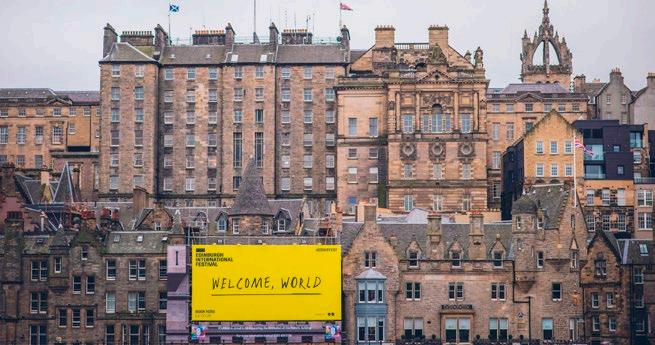
Edinburgh International Festival, Scotland
with the edinBurgh Festival Fringe around every corner, there’s a wonderful atmosphere on the historic streets of Edinburgh in August. The medieval cobbled streets of the Old Town are splashed with music and colour from buskers and jugglers, and crowds jostle to find their next entertainment. Historic squares become circles as people gather to watch miraculous performers. And inside venues like Usher Hall, Queen’s Hall and the Lyceum, another summer festival is unfolding.
Edinburgh International Festival is Edinburgh’s arts offering, and in 2023 welcomes violinist Nicola Benedetti in her first year as festival director. Picking up the baton from previous director, Fergus Linehan, the Scottish violinist has described the
role as “the honour and responsibility of a lifetime” and she is—perhaps unbelievably—the first Scottish and the first female Festival Director since the Festival began in 1947.
Benedetti will usher in the festival’s first full in-person return since the pandemic with a fresh programme that invites international guests including the Alvin Ailey American Dance Theatre from New York, South Korea’s KBS Symphony Orchestra in their first ever UK performance, the Budapest Festival Orchestra led by conductor Iván Fischer, and Simón Bolívar Symphony Orchestra of Venezuela with conductors Gustavo Dudamel and Rafael Payare. We will also see Scottish Chamber Orchestra, BBC Scottish Symphony Orchestra and the London Symphony Orchestra from closer to home.
August 4 – August 27, eif.co.uk
108 • JUNE 2023 MUSIC WITH A VIEW

Win a two-night stay at Penrhiw Priory
Win a two-night continental bed and breakfast stay in ‘Meadow’ at Penrhiw Priory, with a complimentary bottle of Prosecco and a selection of handmade Trwffl chocolates in the room on arrival.
The definition of tranquillity, Penrhiw, St Davids, nestles in acres of private gardens, enveloped by woodland paths, riversand meadows. Choose a bed and breakfast stay or take exclusive use and enjoy luxury accommodation and fine dining at two Rosette Blas Restaurant at our sister hotel, Twr y Felin, and the perfect location to explore Pembrokeshire.
Restored with the utmost care, original features subtly contrast the contemporary interiors, creating an atmosphere which welcomes. Suede wallpaper, generous sofas, and art inspired by the beauty of nature evoke a warmth throughout which extends into the eight ensuite bedrooms.
During your stay, why not indulge further at three Rosette Blas Restaurant at the sister hotel, Twr y Felin in St Davids. Blas – meaning ‘Taste’ in Welsh – offers a menu influenced by the season and locality, with dishes designed to reflect Wales and its produce.
Where would you find the Penrhiw Priory Hotel?

A. Pembrokeshire B. Surrey C. West Sussex

COMPETITIONS
For more information or to book please visit www.penrhiwhotel.com Terms & Conditions: The prize is valid, Sunday to Thursday ONLY, between October 15th 2023 and March 31st2024, excluding School and Bank Holiday and Valentine’s. Subject to change and availability at the time of booking. As hypo-allergenic properties, we are unable to accept pets. Simply answer A, B or C on the entry form or enter online. See page 151.
My
Great Escape:
Cruising The Norwegian Fjords
Our reader Rhiannon Lewis explores the mesmerising fjords of Norway by boat
Norway’s dramatic landscapes have always been on my bucket list, so a cruise through the Norwegian fjords with my mum was an ideal holiday. We journeyed from Dover, crossing the North Sea to Scandinavia. My first view of Norway was the city of Stavanger, whose streets and colourful buildings sit right at the water’s edge. From here, we travelled in a small boat to Lysefjord, away from civilisation and into the heart of the fjordlands.
Mountains towered close to the waterway. They formed wooded walls either side of us, peppered with the occasional grass-topped dwelling. A few goats clambered precariously on the shining black rocks. We passed directly below


Pulpit Rock, a flat plateau towering 1,982 feet above sea level. Then we sailed to Vagabond’s Cave, where legend says fugitives once hid. The climb up the sheer cliff face to the dark entrance seemed impossible.
The next day we travelled on the Flam Railway to the Kjosfossen waterfall, a beautiful body of water
110 • JUNE 2023
TRAVEL & ADVENTURE



Jotunheimen National Park. We were on the Sognefjell National Tourist Route, the highest mountain pass in Northern Europe. Moss grows prolifically here, hanging like furry fingers from the trees. At the foot of the mountain, on the Lustrafjord, lies Ludwig Wittgenstein’s cabin.

Striking and solitary, the cabin draws you towards it like a dream of peaceful self-sufficiency.
Onwards and spiralling upwards, at the side of the road the land falls away down steep gradients covered in silver birch. If you have a fear of heights, it’s best not to look down! Our route took us from breezy autumn sunshine to chilly winter blizzard. The sky was slatecoloured and snowflakes fell as we traversed the summit.
tumbling down a tree-lined ravine. I could feel the drops of spray on my skin and a mist surrounded the cascade. Local legend says a ghostly figure has occasionally been seen here, and it’s easy to imagine an ethereal presence among the cloud.
On another day, a steep and winding road was our path through
We journeyed back across the North Sea again. In all directions, there was only vast sky and undulating waves. I read The Troll Boy and The Witch, the book I bought to remind me of our travels. It’s a philosophical tale of magic, deep forests, and journeying—a perfect Norwegian souvenir! n
Tell us about your favourite holiday (send a photo too) and if we print it, we’ll pay £50. Email excerpts@readersdigest.co.uk
JUNE 2023 • 111

SAN NICOLÒ DEI MENDICOLI
Venice
According to the film critic Roger Ebert, Nicolas Roeg utilised Venice “as well as she’s ever been used in a movie” during his atmospheric thriller Don’t Look Now—which celebrates its 50th anniversary this year. Consciously avoiding tourist traps, Roeg instead presented an eerier, edgier Venice than is normally seen.
One key filming location was Dorsoduro’s San Nicolò dei Mendicoli church. Situated on the sestiere’s southeastern fringes, and well removed from La Serenissima’s headline sights, this is the building that John (Donald Sutherland) is tasked with restoring.
“Mendicoli” translates from Venetian to “beggars”; this area once housed poor fishermen and the church’s portico used to shelter paupers and lepers. While a seventh-century structure once stood here, the current building’s oldest parts date to the 1300s. Outside it, canals flank two sides of a typically pretty campo (plaza).
Beyond set-jetting, further incentive to visit is provided by some superb Renaissance ceiling frescos and, to the left of an old organ, Palma il Giovane’s celebrated Resurrection of Christ oil painting. Look out, too, for Corinthian-like columns and a statue of titular Saint Nicholas holding three golden spheres; these represent donations made in his legend in order to rescue three girls from prostitution.
Other parts of Venice glimpsed in Don’t Look Now include Calle de Mezzo, the hemmed-in alley along which John pursues a red-hooded figure, and, still open, the Grand Canal-side Ristorante Roma. n
By Richard Mellor
GEMS
HIDDEN

113
the best way to earn
cashback










How to save and make money while you shop, with help from these simple cashback tools













114 MONEY


It might sound too good to be true, but specialist websites, current accounts and credit cards will actually pay you for using them when spending money. Though how much you make depends on how much you spend, it can quickly add up to a decent amount. It’s how I do the bulk of my spending and shopping, and on the whole, the effort is minimal each time. Even setting up the necessary accounts isn’t too much hassle— though many of them require you to be online.
First up is the cashback website. There are a number of these, but the leading ones are TopCashback and Quidco and they’ll usually have the best rates. These two are free to use, though you can pay a membership fee for extra features and boosted rewards.
They are effectively portals you go through rather than directly to a retailer’s website. Each contains thousands of well-known brands, from Argos to M&S to Virgin Media, and they’ll offer varying rates of cashback. This could be a fixed percentage, say 1% to 10%, based on the final basket of what you buy. Or it


Andy Webb is a personal finance journalist and runs the award-winning money blog, Be Clever With Your Cash
could be a set amount, potentially up to £100 on things like new broadband contracts or insurance policies.
To get cashback, click through from the cashback site and then shop as normal. Make sure you don’t already have the shop open on another tab, as that could hinder tracking.
Don’t expect the money back straight away. First, the retailer has to confirm the purchase, and this can take months. Then it has to pay a commission back to the cashback site. Only then will you finally get your money.
Be aware that, with these sites, the cashback is never guaranteed. Don’t buy something because of the money you hope to earn—see it as a way to get extra back.
There are some new apps that will earn you money too. Airtime Rewards links to your debit or credit card, and you’ll earn when using those cards at participating retailers, such as Boots and Zizzi. It pays you back as credit towards your mobile phone bill, though it’s restricted to the major networks.
Or you can buy gift vouchers from JamDoughnut and earn instant money back. These don’t need to be for others—you can use them for your normal shopping at retailers, including supermarkets such as Morrisons or Sainsbury’s.
Alongside these sites and apps you can earn cashback from a cashback
READER’S DIGEST JUNE 2023 • 115

card. You simply spend as you would with this card rather than your normal spending card. Once you’ve got one, it’s the easiest way to earn.
A handful of banks will offer this on their current account debit card, with app-only bank Chase giving 1% back for a year, capped at £15 a month. You’ll need to deposit at least £500 into the account each month to activate your cashback for the following month.
For uncapped earnings, and if you want to benefit from additional consumer protection on purchases over £100, you’ll want to look at a cashback or reward credit card. The latter is different, as you’ll earn points, which you’ll convert to vouchers in order to spend, usually
at a specific retailer. And of course, since they are credit cards, you need to be sure you clear the balance completely every month to avoid any interest or charges. If you fail to do this, or spend more than you can afford with the card, then you’ll wipe out any benefits you would have gained from the cashback or rewards. Setting up a direct debit to clear what you owe every month can help you avoid this.
Watch out too for annual fees. Sometimes these only start after a year so be sure to calculate whether it’s worth keeping the card when it’s no longer free.
The highest paying ones are from American Express (aka Amex). The Amex Nectar card offers two Nectar
MONEY 116 • JUNE 2023
points for every £1 spent, which is the equivalent of 1% back.
For pure cashback, the Amex Platinum Cashback pays 0.75% back on the first £10,000 you spend, then increases to 1.25%. The money is paid annually as a credit to your card so you can spend it wherever you want.
Sadly not all retailers will accept American Express, so you might want to have an extra cashback credit card on hand just in case. The Barclaycard Rewards card pays a much lower 0.25%, but is fee-free to use overseas.
Or, if you shop regularly at places like John Lewis, Waitrose, M&S or Asda, you might want to get their own reward cards, which pay between 1% and 1.25% on shopping in their stores, but less elsewhere.
With most cashback and reward credit cards you can also get a welcome bonus or boosted points on your initial spending, often for the first three months. There will be eligibility criteria, and often a spending threshold needs to be hit. Timing can be key to ensure you maximise your return—which can easily be £100 or more.
The final place to earn cashback is with a Santander current account that will give you money back on your bills. There are two options available to new customers—the 123 and the Edge.
The 123 offers up to 3% on your bills, while the Edge provides a flat 1%. This covers your payments for council tax, water, energy, broadband, phone and TV.
The Santander website has a calculator where you can enter your monthly bills to see what you’ll get over a year, after the monthly fees have been taken into account. For most people, the 123 account will be most profitable just on cashback, though if you have savings the Edge also offers 4% interest on up to £4,000, which might be worth more.
There’s no need to switch from your existing account to have one of these. You can simply open one up and transfer your direct debits across to the new account. Just make sure there’s enough in there each month to cover those bills. n
Summer Solstice
While most people consider it to be “the longest day”, the summer solstice is an exact moment when the Northern Hemisphere is most tilted towards the Sun
This year, the moment when the summer solstice will occur in the UK is at 3.58pm on Wednesday, June 21
SOURCE: RMG.CO.UK
READER’S DIGEST JUNE 2023 • 117
3 Reasons To Release Equity This Summer

As the summer approaches and the evenings get longer, you might find yourself looking around your garden and picturing changes you’d like to make or spending more time with family and wanting to find ways to help them out. For many, the catch can be the extra funds required to achieve goals like these.
PARTNERSHIP PROMOTION
If you are an over 55 homeowner, you might wish to consider releasing equity. Here are three reasons why:
1. Tax-free cash lump sum
Releasing equity allows you to unlock a tax-free cash lump sum from the value of your home. The money can be spent on a variety of goals and projects, and receiving a lump sum of cash can be particularly helpful if you have a large expense like a relandscaped garden that you’d like to cover.
2. No need to move
Many homeowners consider selling their home to access the equity they have built up over time. However, downsizing can be stressful and disruptive, particularly if you are reluctant to leave your current home and the support network around it. With a Lifetime Mortgage, the UK’s most popular equity release tool, you can access this value without having to leave your home. You will retain 100% ownership of your property as you are borrowing against your home, not selling it.
3. Flexibility and control
There are no required repayments with a Lifetime Mortgage, with the amount borrowed plus the interest that will accrue
over time due when the last homeowner passes away or enters long-term care. Many homeowners choose to release equity to enjoy their later years free of required repayments, but there are also options to make flexible and voluntary payments if you wish. Making payments can help you to control your cost of borrowing over time.
Although there are many reasons why releasing equity could be suitable for you, proceeding is a big decision and its essential to speak to an expert before going ahead. Reader’s Digest Equity Release can offer you no-obligation advice from a team of expert advisers, so you can get information personalised to you. Your adviser will help you explore all of your options and give you the tools you need to make an informed decision about whether releasing equity is right for you. They will also explain the pros and cons of equity release, including the fact that taking from the value of your home now will reduce the value of your estate in the future and could affect your entitlement to means-tested benefits.
Give Reader’s Digest Equity Release a call today to find out more and book your advice appointment. Reader’s Digest Equity Release is a trading style of Responsible Life Limited. Only if your case completes will Responsible Life Limited charge an advice fee, currently not exceeding £1,690. Find out more - Call 0800 029 1233 Or visit www.readersdigest.co.uk/er2

Keeping Cool
Dogs, cats and other pets can be vulnerable in the heat and strong sunshine of the summer months
We all love the summer sunshine, but spare a thought for our pets when the temperatures start to soar. Katy Alexander, vet with national pet charity Blue Cross, has some tops tips on how you can protect your pet throughout the hot summer. She explains, “While we enjoy the sunshine and hot weather, it is important to make sure our pets are kept safe. They can quickly overheat and this can be extremely dangerous and even fatal.”
No afternoon walks
Walk your dog during cooler times of day in the early morning or evening and avoid strenuous games. If the weather remains hot then it’s safer to allow your pet to flop inside in the cool if you think it’s too hot outside.
Access to water bowls
Make sure your pet always has access to clean water, ideally in a large bowl filled to the brim. Older animals, particularly cats, are more vulnerable to dehydration.
Alternative exercise
As a rule, if the pavement is too hot
for your hand, it’s too hot for your pooch’s paws. If your dog is one that needs a long walk to burn off excess energy, find other ways to stimulate them instead.
Risk of sunburn
Light-coloured dogs and cats and those with sparse hair coats can get sunburned, which can lead to skin cancer. Keep sunbathing pets indoors when the sun is strongest. You can also apply a non-toxic human sunscreen or one specifically for pets to vulnerable areas like ears and noses.
Risk of overheating
Pets with thick fur will need regular grooming and even a trim to prevent them overheating. Seek advice from a professional groomer. Make sure your pet has access to a shady spot to chill out inside, as conservatories can also get very hot very quickly in the sunshine. You may want to invest in pet-cooling mats and fans to keep your pets and yourself as cool as possible.

Small pets in the shade
For small pets like rabbits and guinea pigs, make sure their hutches and runs are in a shaded area so they can keep
PET CORNER
120 • JUNE 2023
cool and make sure the animal and their living area is clean at all times, with water bowls topped up.
Iced treats
Make ice cubes with your pet’s favourite treat inside.
Paddling pool
Have a paddling pool with cool water in the garden for dogs to play in. Again, keep this in the shade.
Frozen bottles and damp towels
Filling plastic bottles with water, freezing them and placing them in your pet’s bed or under damp towels is a good idea. This can work for cats and dogs but will also help small animals like rabbits.

Email your pet’s picture to petphotos@readersdigest.co.uk
Be aware of more at-risk pets
Flat-faced breeds, such as French bulldogs, pugs and Persian cats, are at an even greater risk of heatstroke and collapse, as their short muzzles can make breathing difficult, therefore cooling down much harder. Older pets and those who are overweight also struggle. Take even greater care with these pets.
During heatwaves, keep your pets indoors and your home cool. If you suspect your animal is suffering from heatstroke, move them to a cool place, dampen their coat with tepid water on a towel and contact a vet. Avoid overcooling, especially small pets. n
For help visit bluecross.org.uk
Age: Nine years
Breed: Unknown
Owner: Amber McLellan
Fun Fact: I don’t have many cat friends as there are no cats that live near me, but my best friend Mr Fox is the best friend a cat can have. He visits me every day and we play “Chase Me, Chase Me”.

Floyd JUNE 2023 • 121
£100 gift voucher to spend at Pet Planet Enter our monthly Pet of the Month contest at the email above WIN!
READER’S DIGEST’S PET OF THE MONTH
Plant The Town Green
No garden? No problem. Plant in a street tree bed instead to help brighten up your neighbourhood
As a child, John Welsh loved helping out in his parents’ garden and, after finishing his studies, his first job was in a plant nursery. “But then I got pulled into a corporate career for 30 years,” he sighs.
That began to change in 2016, when John’s mother moved in with him and his husband. “She was shocked by the level of litter and dog foul in the street and suggested we plant some of the leftover plants from her old garden into the shabby tree beds outside.” Sure enough, the plants flourished, and the mess around them subsided. “It was a revelation: I could actually change something, rather than just sitting at home like a pompous old fart, whinging or shouting at the council.”
By the following year, John had created biodiverse gardens in six tree beds along the street, using only plants from saved seeds, cuttings or division.

People up and down the street stopped to ask what he was up to, and strangers turned to friends. The next year was set to look better than ever. But just as the hotly anticipated rainbow of spring blooms was set to emerge, Camden Council’s subcontractor sprayed the entire street with glyphosate. “Everything died,” John announces matter-offactly. But the residents rallied together: donating whatever plants they could to refill the pits and committing to protecting them. Now, there are 15 tree bed gardens along the street and a group of neighbours help look after them.
Street tree beds
Tree beds, also known as tree pits, are the gaps in the pavement (or occasionally large planters) in which street trees are planted. These are a great place to start! You’ll find them in most neighbourhoods, usually bare at the base.
This nakedness is an unnatural state of affairs: trees love company! Wild trees usually have a host of
122 • JUNE 2 023
HOME & GARDEN
smaller plants growing beneath their canopy, and planting under street trees can help recreate this healthy ecosystem. However, planting the wrong companions, or using the wrong method, can damage trees.
What to plant DO
• Include native, resilient plants. Look to see which species are thriving in your area, especially in other local tree beds.
• Plant a diverse range of species, including ground cover among taller stems.
• Choose shade-tolerant plants if the tree casts a big shadow. Spring bulbs found in woodlands, like bluebells (Hyacinthoides non-scripta) and wild garlic (Allium ursinum), work well below deciduous trees, taking advantage of the spring sunshine before the tree has leaves.
AVOID
• Plants with a high demand for water, like hollyhocks (Alcea rosea) or sunflowers (Helianthus annuus), unless you plan to water the bed frequently. They can compete with the tree—especially if it’s a young one—potentially killing both the tree and your plants.
• Planting climbers, such as clematis (Clematis spp.) and honeysuckle (Lonicera spp.), which could engulf the tree.
How to plant it DO
• Maintain a distance of around 1015cm between the base of your plants and the base of the trunk to prevent the bark from moulding.
• Plant densely, to cover the soil and help pollinators find the garden.
• Create a low wooden border around the edge, which will both protect your planting from being trampled and stop it spilling out and obstructing the pavement.
• Feed and enrich the soil where you’ll be planting (but avoid raising the soil level).
AVOID
• Harming the tree’s roots: use a trowel, not a shovel, and work carefully around them; never pile soil or mulch up over the root flare (the bit where the roots join the trunk), as this can cause decay or hide root problems.
• Planting if the tree is a very young sapling (less than four years old), as any plants could outcompete it for water and nutrients. n Excerpt from Get Guerrilla Gardening by Ellen Miles (Published by DK, June 8, 2023) RRP £18.99

JUNE 2 023 • 123

WIN £200
To spend at Bed Threads
Launched in August 2017, Bed Threads is currently the only linen brand in market that offers 100% Flax Linen Bedding Sets that include Two Pillowcases, A Duvet Cover and A Fitted Sheet at an accessible price point, delivered worldwide. Their mission was simple – to give you the space and sleep of your dreams by making the luxury of 100% linen accessible to everyone. We have £200 spend online! Visit www.uk.bedthreads.com to order!
Complete the crossword and the letters in the yellow squares can be sorted to reveal a word that describes how you feel before bed. Write this word on the entry form. See page 151. complete the crossword for


COMPETITIONS ACROSS 1 One neither early to bed nor early to rise (3) 3 Ogre (3) 5 Blossoms (7) 8 Simple type of question (3-2-2) 12 Gaza group (1,1,1) 13 Old Russian space station (3) DOWN 1 Rancid (3) 2 Fifth sign of the zodiac (3) 3 Instruction to a Spanish hen? (3) 4 Lettuce variety (3) 6 Shelter (3) 7 Hurried (3) 8 Short sharp bark (3) 9 Way to get a web site high in Google (1,1,1) 10 Lip (3) 11 Belonging to us (3)
12
your chance to win !
£200 to spend WIN! 8
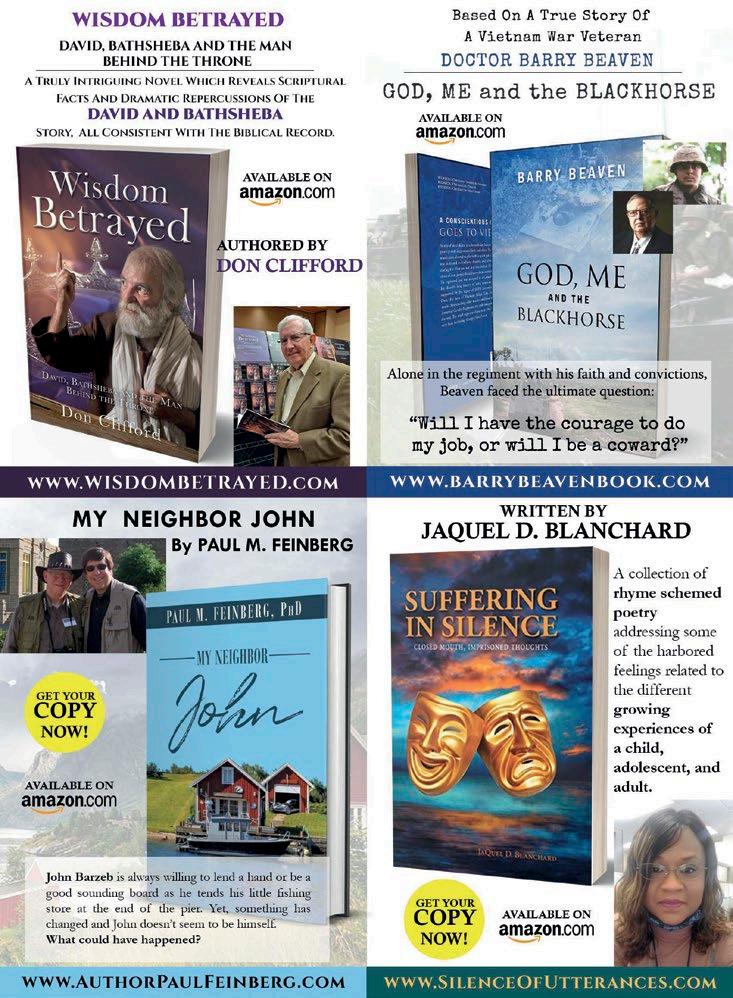

126
How
Bread Of TheJoy
eating bread can help you have balance in your diet
In How to Cook a Wolf, MFK Fisher gives the best dietary advice I have read. She says: “Balance the day, not each meal in the day.” She explains that we can still eat healthfully without trying to get fruit juice, hot or cold cereal, scrambled eggs with bacon, and buttered toast packed into the first meal of the day, and soup, beef, mashed potatoes, lima beans, and Waldorf salad packed into the second, which her contemporaries were.

Tamar Adler is a contributing editor to Vogue. Her writing has appeared in the New York Times Magazine, the New York Times Book Review, the NewYorker.com, and other publications

Here is her further guidance: “Breakfast then can be toast. It can be piles of toast, generously buttered, and a bowl of honey or jam. You can be lavish because the meal is so inexpensive. You can have fun, because there is no trotting around with fried eggs and mussy dishes.”
She is right. Breakfast can be toast; so can lunch be, or dinner. “Breaking bread” means eating. “Our daily bread” means food. It is also called the staff of life, which I like: bread there, all life leaning against it. Our
FOOD JUNE 2023 • 127
lives don’t lean against it anymore: we’ve decided that bread is bad for us. Our staff has broken, and that is part of why our diets seem so hard to get in balance.
Bread can be the thing you’re eating, not a prelude to the meal, or an afterthought. It is not bad for you. Whether as piles of toast, generously buttered, or thick slices rubbed with garlic and
Then let the rest of your meal be vegetables. Cut thick slices of bread, drizzle them with oil, and toast them in a hot oven or on a grill. Let them get nicely charred, then rub each slice lightly with the cut side of a clove of raw garlic.
In autumn, roast a whole butternut squash. Smash it in a bowl with good olive oil, a little freshly grated Parmesan, and a lot of freshly
BREAD CAN BE THE THING YOU’RE EATING, NOT A PRELUDE TO THE MEAL, OR AN AFTERTHOUGHT. IT IS NOT BAD FOR YOU

drizzled with olive oil, eating bread with intention is a good dietary strategy. I can think of no better way to get good, healthy vegetables, lush, ripe, and in season, to the middle of your plate than to let them balance on freshly toasted bread. Instead of worrying about lots of ingredients with which to trot around, buy a loaf of bread with a hard crust. Pick it based on how enticing it looks, and on how good it smells. Pick something that is round and fat or, if it is oval, that still has good girth at its ends, so you can get a lot of big, healthy pieces out of it. Make it a loaf that will require slow, deliberate chewing.
cracked black pepper. Spread the squash thickly on the toast, drizzle it with more olive oil and a squeeze of lemon juice, and sprinkle it with roughly chopped toasted almonds.
In winter, sauté Swiss chard or kale in a lot of garlic and olive oil. Top pieces of toast with ricotta or goat's cheese, then piles of garlicky greens. Squeeze each with lemon juice.
In spring, cook peas or asparagus in a little butter and water. Top each toast with a brothy spoonful of vegetables and drizzle it with crème fraîche or sour cream, then a few cracks of black pepper and chopped mint, tarragon or chives.
THE JOY OF BREAD
128 • JUNE 2023
In summer, thickly slice tomatoes. It’s best if they’re different colours. Lay an array on each slice of toast, salt them well, drizzle each with good olive oil, and top with torn basil. Or roast courgette or aubergine in an oven or on a hot grill, dress it with vinegar when hot, and top the toast with it.
For people who say that bacon is a vegetable: cook sliced garlic over very low heat in butter and a little water until it is completely tender and stewed. Top toast thickly with stewed garlic, then very thinly sliced bacon or pancetta. Cook each piece of toast under the grill until the meat is crisp and its fat has seeped into the bread. Use bread to balance your budget as much as your diet. Local vegetables are especially worth their cost if you’re eating them, prepared simply and well, mounded on a big piece of toast. As is good bread. As is the good olive oil you will drizzle, as lavishly as you want. Your bread doesn’t have to be in the middle of the plate. But if it is not your meal, let it help you relish what is. Choose a piece of good bread instead of a second pork chop or second helping of lasagna. Use it to sop up your chop’s lovely juices or wipe up the last of the lasagna’s sauce. This will make your meal easier on your stomach as well as your pocket. n
Trooping The Colour
Excerpt from An Everlasting Meal— Cooking with Economy and Grace by Tamar Adler (published by Swift Press) hbk £14.99
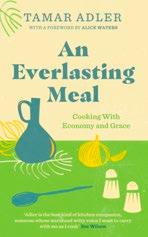
The military parade is a tradition to mark the Sovereign's "official" birthday. This year it is on June 17, although King Charles III's actual birthday is in November
It began in the 1740s, when King George II began celebrating his birthday twice because his birthday was in October and the June weather was more desirable
More than 1,400 soldiers, 200 horses and 400 musicians parade through London, followed by members of the Royal Family, concluding with an RAF fly-past
source: chroniclelive.co.uk
READER’S DIGEST
JUNE 2023 • 129

State Of The Art: The Rossettis
Carol Jacobi, curator of The Rossettis exhibition at London’s Tate Britain, speaks to Allison Lee

What drew you to curate an exhibition on the radical Rossetti generation, and do you see this movement of challenging the traditional reflected in today’s society? The Rossettis’ story is just a fascinating one with so much to unpack—be it their lives or art. What was most striking is their desire for a new kind of art form that was authentic, raw and based on lived experienced rather than rules. I think this speaks volumes to something all of us are still struggling for today. We try to find ways to obtain the truthfulness—an authenticity of life that we so value—and there is no denying that the Rossetti generation popularised this way of thinking and pioneered the search for art that could transport and transform us. Today,
Abstract painter
Georgii Uvs’ new collection in Venice presents the Mesozoic era as a path to optimism
ART
130 • JUNE 2023
I see this mirrored in the worldbuilding that happens in computer games and anime.
How is this exhibition different from your past curations?
The entanglement between words and images has been a challenge and an opportunity to try different approaches to exhibition curation. What we’re dealing with here isn’t just a collection of paintings, but a set of lives that took place. It is the most biographical exhibition I have done so far, and so much happened through the Rossettis’ lives—Gabriel led two avant-garde movements against mainstream art, Christina exceeded expectations as a successful poet, Elizabeth exuded talent beyond her age. This exhibition is different because you get a glimpse into the artists beyond the paintings and you can see the influence that they had on each other, how their styles evolved.
Does the exhibition challenge or reshape our understanding of the Rossetti generation? The exhibition explores the Rossettis’ lives from a deeper level and, in each room, you’ll find something you were not expecting. The general conception of the Rossettis is heavily dominated by Gabriel’s later works, and we wanted to assemble everything together to present a panorama of their lives. For instance, the exhibition features
Christina’s career alongside Gabriel’s, which has never been seen before. Additionally, it showcases Gabriel’s earlier works which lay the foundation for his later works that we have come to be fond of. There are also little Easter eggs around the exhibition, such as a wallpaper being inspired by the wallpaper Gabriel designed in his and Elizabeth’s room, featuring floor-to-ceiling apple trees on a dark blue background.
What did you learn by spending so much time with the exhibited pieces? There were so many new stories I wanted to tell through this exhibition. The most important one was an idea from someone I worked with; everyone thinks of Elizabeth Siddal as Ophelia in John Everett Millais’ famous work, and we wanted to free her from that painting. I’m quite pleased to say that we have succeeded in rebranding Elizabeth as not just a model, but an artist in her own right. Other than that, it’s a very colourful exhibition with love at the centre of almost every piece, between siblings, parents and children, and between, well, lovers. I think this is something we all need at the moment. Everyone could use a little reminder of love. n
Visit The Rossettis exhibition at London’s Tate Britain by September 24. You can read an extended version of this interview at readersdigest.co.uk
JUNE 2023 • 131
MONTH FILMOFTHE
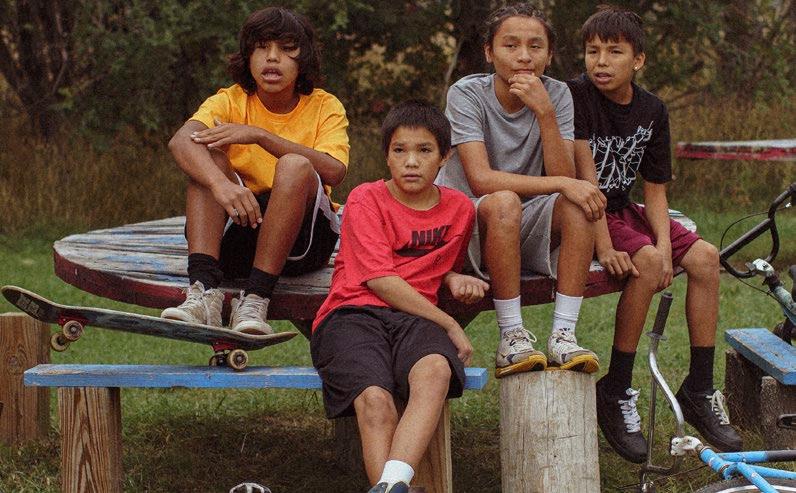 H H H H
H H H H
WAR PONY
There’s a widely held idea that Native American reservations are apart from America—that having been given this land, Native American communities simply look after it and keep to themselves. But in truth, they are a raw, honest reflection of the US’s past and present, and that’s what this film shows us, in tear-filled bucketfuls.
War Pony is an intimate, gritty coming-of-age story about two Lakota boys—Bill, a 23-year-old chancer, and Matho, a 12-year-old dreamer—trying to find their way on the Pine Ridge Indian Reservation in South Dakota. Bill takes any opportunity he stumbles on for extra cash, from buying a pregnant poodle to flogging his PlayStation. When he comes across a broken-down truck owned by a rich white man, he
hustles himself a job in the hopes of finding the American Dream. Matho is a bright, sweet boy who just wants his father’s approval. He’s torn between the usual experiences of a 12-year-old—trying to get a girlfriend and learning magic—and wanting to be a hard man, cutting his dad’s crystal meth and selling it on the street.
Co-writer Franklin Sioux Bob said that this film gives you everything, and he’s right. Encapsulating the tight-knit community as well as poverty and lack of opportunity, there’s still a glimmer of hope. It’s even funny in parts. Filmed largely on the reservation with first-time actors from the community, it almost has a documentary feel. A hard watch but an important one.
READERSDIGEST.CO.UK/CULTURE
132 • JUNE 2023
H H H H
REALITY

emmy award nominee Sydney Sweeney (White Lotus, Euphoria) stars in this tense, surreal drama based entirely on the full transcript of a conversation between two FBI agents and American Intelligence translator, Reality Winner.
On June 3, 2017, 25-year-old Reality is approached by two FBI agents, along with a silent team who, with no explanation, search her house and request she “volunteers” for questioning. This should be dull, considering that director and writer Tina Satter has stuck to the original (largely redacted) transcript. But given that the story was internationally reported, with most details released, the lack of frill works in its favour, giving a sense of the unrealness of what
occurred. For those who don’t know, Reality was the whistle-blower who leaked a document proving Russian interference in US elections.
This story could easily be overdramatised, following standard thriller tropes. But the dialogue’s small talk and jerky non-sequiturs make it more menacing. The juxtaposition of Reality being held outside her house as strangers go through her belongings, while an FBI agent attempts a casual conversation about cross-fit, for example, is discomforting, as well as funny.
Somehow both quiet and monumental, Reality asks difficult questions about truth, power and morality versus legality.
By Miriam Sallon
FILM
ALSO OUT THIS MONTH
JUNE 2023 • 133
Anyone for tennis?
Two-part profile Boom! Boom! The World vs. Boris Becker (Apple TV+) takes its title from the speed-of-sound serve the German grass court wunderkind deployed to see off countless challengers. Alex Gibney, one of our most rigorous documentarists, interviewed Becker twice: first in 2019, as his subject’s financial woes became apparent, then in 2022, shortly before he was sentenced for breaching the Insolvency Act. In the former, Becker retains traces of the leonine golden boy of yore; in the latter, he appears pallid and fraying, like a tennis ball battered beyond recognition.

won’t have seen, and even the familiar Centre Court action has been punched up for the purposes of stronger storytelling; those aces zip past us anew. But there are situations in life— cheating on loved ones, ducking fiscal responsibilities—where even a 100mph serve can’t rescue you.
Gibney argues that Becker, like many champions, believed in making life difficult for himself; in matters of money, however, he stretched himself too far. The road to HMP Wandsworth—as Gibney notes, not so far from Wimbledon—is enlivened by this filmmaker’s tremendous facility with archive. Many clips here you just

Becker’s penury is nothing compared to that of Daisy May Cooper’s Costello Jones, heroine of the BBC/HBO co-production Rain Dogs (BBC1, iPlayer). Evicted from her council flat, she’s soon down and out in seedy Soho, with young daughter in tow, and only unreliable associates to cushion their fall; her mid-series makeover comes care of a mortician pal’s make-up brush. Even at its funniest, Cash Carraway’s eight-part adaptation of her own memoirs never loses sight of the void its characters are circling. Not always comfortable viewing, granted; potent television, nevertheless.
by Mike McCahill
Retro Pick:
JohnMcEnroe:IntheRealmof Perfection (YouTube)
Becker’s tantrum-throwing rival gets comprehensively psychoanalysed using fascinating footage from the 1984 French Open final.
TELEVISION
134 • JUNE 2023

Mike Oldfield Tubular Bells 50th Anniversary Edition
no doubT anyone who caught The Exorcist when it hit cinemas in 1973 will have a Pavlovian response to those first paranoia-infused notes of Mike Oldfield’s proggy odyssey, Tubular Bells. Fifty decades on from its debut (which launched the then fledgling Virgin Records), this spine-tingling, otherworldly composition is rendered anew on the 50th Anniversary Edition, which combines hat tips to the trailblazing record and the cultural touchstones that came after it.
Featured for the first time is “Tubular Bells Intro 4”, which for the uninitiated provides a fitting eight-minute introduction to the colossal two-parter. Soft metallic chimes and a segue into tranquil guitar plucks make this shortened version sound sunnier, before a rousing electric riff pays tribute to the original’s mid-song rockout.
“Tubular X” offers Oldfield’s take on the X-Files theme—originally released on a collection of remixes of the seminal TV theme in 1998. The paranormal motif may sound a little gimmicky at first, but soon gives way to a synthy squelch and celestial soundscape, which capture the sci-fi aura that once surrounded the late 20th-century explosion of new music technology.
One criticism that Tubular Bells received the first time round was of its repetitiveness (if you’re a fan of slow build ambience, you may disagree). The same could be leveraged at this record— it’s perhaps not one for listening in one sitting, but as a whole, remains a fitting tribute to the timelessness of Oldfield’s classic album, which still persists in the popular imagination.
By Becca Inglis
Yusuf/Cat Stevens King of a Land
On his past two releases, Yusuf/Cat Stevens has largely turned his attention to reinterpretations of his iconic body of work—no bad thing for long-time fans of the gravel-voiced singer-songwriter, but those who crave new material have been left slightly wanting. This month, King of a Land applies Yusuf’s poetical imagination to a fresh collection of music, which brings his faith and desire for a fairer world to vivid life. Yusuf calls the record a “mosaic” of his multiple musical influences, whether it’s the folk-pop of “Things”, the surprisingly raucous rock on “Pagan Run”, or the Tchaikovskyinspired “How Good It Feels”. Settling into Yusuf’s simple pleas for peace and kindness feels comfortingly nostalgic on this record, particularly when it is wrapped in his distinctive croon.
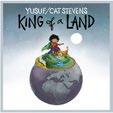
MUSIC
JUNE 2023 • 135
A
June Fiction
pair of rival Victorian-era mediums face off in this absorbing and surprisingly relatable debut novel
TheOtherSideofMrsWood
by Lucy Barker
Fourth Estate, £14.99
In essence, the plot of Lucy Barker’s debut novel is a pretty standard one. A businesswoman has been at the top of her profession for years. But then along comes a younger, more ruthless rival who, by satisfying the public’s insatiable desire for the next new thing, is soon poaching her customers. And so as one rises, the other falls.
The twist here, though, is that the businesswomen are 19th-century mediums battling it out in the surprisingly cut-throat world of spiritualism among London’s fashionable classes.

James Walton is a book reviewer and broadcaster, and has written and presented 17 series of the BBC Radio 4 literary quiz The Write Stuff

The first is Violet Wood, who’s achieved the rare feat of operating as a medium for 15 years without being exposed as a fraud. Nor has anyone ever discovered that her background is by no means as respectable as she claims. But now, approaching 40, she’s starting to wonder if her monthly Grand Séances are becoming a bit old hat—not least when she’s shocked to hear one attendee stifling a yawn.
Meanwhile, her ferociously ambitious protégé, Emmie Finch, is about to raise the stakes by manifesting her spirit guide in physical form, and not just through voice alone…
As somebody with a master’s degree in Victorian Studies, Barker clearly knows this world well, writing about it with infectious relish and a great eye for
BOOKS
136 • JUNE 2023
arresting detail. She also lets us in on the tricks of the trade, such as how to make a séance table rock (with a pulley attached to the medium’s foot, since you ask)— but acknowledges, too, the genuine solace that spiritualism provided. Best of all, she populates the world in question with a large cast of characters who, rather unexpectedly, given the circumstances, prove highly relatable. At times, Barker perhaps plonks a 21st-century feminist thumb on the scales, with references to “the patriarchy”, an early suffragist saying, “I need to do this. For me”, and a general reluctance to blame women for anything they do, however villainous. Nonetheless, this is a wildly entertaining novel which plunges us deep into a fascinating part of history that most of us won’t have known about before—but which never fails to keep the storytelling bowling along in a way that’s both emotionally engaging and thoroughly gripping. n
Name the character
Can you guess the fictional character from these clues (and, of course, the fewer you need the better)?
1. We first encounter him as the landlord of Thrushcross Grange.
2. His creator died in 1848, aged 30.
3. The great love of his life was Catherine Earnshaw.
Answer on p140
Paperbacks
OldRage by Sheila Hancock (Bloomsbury, £9.99). The muchloved actress looks back on nearly 90 years of life—and gets a few things off her chest about how things are now.
ActofOblivion by Robert Harris (Penguin, £9.99). As ever, Harris combines fantastic research with thrilling narrative in a novel about the post-Restoration hunting down of the men responsible for Charles I’s execution.
Clubland:HowtheWorking Men’sClubsShapedBritain by Pete Brown (HarperNorth, £9.99).
In their Seventies pomp, British working men’s clubs had 4 million members: an often-neglected aspect of social history that Brown explores with affection, wit and sometimes indignation.
ThisTimeTomorrowby Emma Straub (Penguin, £9.99). Delightful novel about a father-daughter relationship that benefits from a spot of time-travel.
Happy-Go-Lucky by David Sedaris (Abacus, £10.99). Sedaris is on his usual honest, bracing and funny form as he reflects on lockdown and other indignities.
JUNE 2023 • 137
RECOMMENDED READ:
High Praise
This month, we find out about the fascinating world of “church-crawlers” and the history of British churches
At Southwark Cathedral in London, you can hear the same bells that Shakespeare paid for to be rung at his brother’s funeral. In the Yorkshire village of North Grimston, 21st-century children are baptised in the same font as those of a thousand years before. “Churches,” writes Peter Ross, “hold within them Britain’s history, national and personal”— not just architectural wonders, but touching and enduring monuments to the countless numbers of ordinary people who’ve had some of the most important moments of their lives there.
Like many “church-crawlers”, Ross is no longer a religious believer himself. Nonetheless, going into an old church always feels to him like “a homecoming”. Or, as he words it elsewhere in the book: “You are entering a building, but really it is entering you.”
In Steeple Chasing, he travels across the UK visiting grand

cathedrals, tiny, neglected chapels and all points in-between. He meets everybody, from experts in the unexpectedly rude church statues (known as Sheela-na-gigs), to monks who’ve taken vows of poverty and celibacy (“I sometimes think it would be quite nice to have a wife,” muses a monk, before adding, “or even a pair of socks”).
Yet, while Ross’s tone is unfailingly warm, the book is also tinged with melancholy. Many churches, he reminds us, are disappearing and most that do remain are in obvious decline, with dwindling congregations and insufficient funds to maintain the heritage they so
BOOKS
138 • JUNE 2023
powerfully represent. All of which, I’d suggest, will only make anybody who reads this beguiling and beautifully written book even more likely to get down to some serious churchcrawling before it’s too late.
Here, Ross is in Norfolk where John Vigar, a church-lover (another nonbeliever, incidentally) introduces him to St Lawrence’s in Harpley…
“Standing in the porch, about to try the door, is always a nervous moment. Will the church be open, which is a rush? Or will it be locked, a deflating snub? Most Norfolk churches are open every day, but not everywhere is so blessed. Too often there will be the troublesome business of phoning up the vicar for the key. Certain parishes, even entire counties (‘Nottinghamshire,’ John tutted) are notorious for poor access.
Now, in the porch of St Lawrence’s, he tried the handle. It turned with a satisfying clank and we stepped inside. Over the last few months I had
Steeple Chasing: Around Britainby Church by Peter Ross is published by Headline at £22
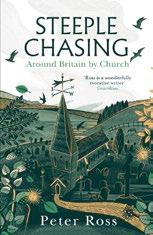
spoken with several church-crawlers, many of whom had delighted in recollecting the sensuous pleasure of that moment when the door gives. ‘I get excited just thinking about it,’ a young priest in London confessed.
The expression ‘church-crawling’ appears to have been coined by either John Betjeman or his friend, the artist John Piper. Certainly, Betjeman used it in a 1948 radio broadcast, and then expanded upon this in an article of that name the following year. ‘The instruments you need for churchcrawling,’ he informed his readers, ‘are (1) a notebook in which you can sketch and write remarks; (2) opera or field glasses for viewing roofs and stained glass; (3) a map; (4) most important, an unprejudiced eye.’
It isn’t just about what you can see, though. Church-crawling engages the other senses. The smell often hits first, that odour of damp stone, mouldering prayer books, beeswax and bat so closely aligned with the overall feel of a church—that impalpable somethingness—because both are created by the long passage of time. One crawler told me that he enjoys walking into a country church on a very hot day, after cycling for miles through the lanes, as the cold damp air offers a sudden smack of relief. There is, too, the exhilaration of those summer evenings when swifts come screaming out from the eaves.
Inside St Lawrence’s, John drew my attention to the north-west window.
READER’S DIGEST
JUNE 2023 • 139
What he wanted me to see was low down in the right-hand corner, but I still had to stand on a stone bench to get high enough. A clear glass diamond pane appeared to have something scratched into it.
‘Can you make out what it says?’
Not at first, but then, yes, I could. A name—Joseph, perhaps?—and a word that, even on such a warm day, provoked a shiver: ‘Hanged.’ This man, being a criminal, wouldn’t have merited a memorial, but someone who cared for him had scratched his name into the glass with the jewel in a ring as an act of remembrance and, for hundreds of years, the sun had shone through it into the church. This graffiti is not mentioned in any guidebook, but John had found it according to his unvarying method—careful loving patience—and thus someone’s tragic fate was brought once more into the light.
‘The more you look,’ he said, ‘the more you see.’
”Answer
to Name the Character:
Heathcliff in Emily Brontë’s Wuthering Heights. Heathcliff has had the honour of being played over the years by both actor Laurence Olivier (in a 1939 film) and musician Cliff Richard (in a 1996 stage musical).

Peter Ross’s Choice Of Great Church Books
Fluddby Hilary Mantel. A faithless priest, troubled that statues must be removed from his church, gives them a decent burial. Soon afterward, a stranger arrives… An odd and brilliant book.
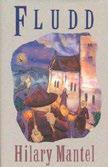
WhatToLookForInsideaChurch by PJ Hunt and Ronald Lampitt. One of those lovely old Ladybird books, full of useful information and undeniably pretty illustrations.
TheCornerThatHeldThemby Sylvia Townsend Warner. Warner imagines life in a 14th-century English convent. At once epic and full of minutiae, like a detailed tapestry glinting in candlelight.
AMonthintheCountryby JL Carr. Summer 1920, and two war veterans meet at an old Yorkshire church. One is uncovering a medieval mural, the other seeking a lost grave. Wonderful stuff.
FourQuartetsby TS Eliot. “You are here to kneel/Where prayer has been valid.” That line that followed me around Britain as I visited old churches. I was glad to have its company.
BOOKS
140 • JUNE 2023
Books
THAT CHANGED MY LIFE
Ben Aitken is the acclaimed author of The Gran Tour and The Marmalade Diaries. His new book, Here Comes The Fun, is out on May 25 (Icon Books), hardback £16.99
Bridget Jones’s Diary by Helen Fielding


This was the first book I ever read. I was 18. Its impact was huge. It made me wonder if —compared to golf, football and Baywatch—reading wasn’t so bad an option. Maybe I could relate to the protagonist. Which is odd when you consider she was a 30-something journalist living in London with a crush on Hugh Grant, and I wasn’t. Soon after, I applied to study English at Oxford. I made it clear in my application that while Nick Faldo remained my main interest, the work of Helen Fielding had excited a fondness for the written word. I didn’t get in. Though I like to think it was a close-run thing.

Notes From a Small Island by Bill Bryson
BridgetJonesgot me reading, Bill Bryson got me writing. The first book I wrote was an irreverent homage to Bryson’s iconic travelogue. About 20 years after the publication of Notes from a Small Island, for reasons that remain a mystery to me, I chose to retrace his journey around the UK. Starting in Dover, I followed Bryson’s footsteps as precisely as possible—same hotels, same restaurants, same amount of time in the bath—before ending up outside the author’s house in Yorkshire, hoping for a cup of tea. He wasn’t in. I left Bill a note communicating what I’d done and how much he meant to me. He left me in no doubt regarding the future of our relationship. Hey-ho.
Gertrude by Herman Hesse I’m tempted to say that the third book that had a big impact on my life was Bridget Jones’s Baby, but in truth I’ve not yet had the good fortune of reading the final instalment in Fielding’s groundbreaking triptych. Instead, I’m going to nominate Gertrude by Herman Hesse. Beautiful prose. A memorable story. And a significant teaching: when you’re feeling emphatically rubbish, and life’s doing nothing for you, help others. That’s always stayed with me, and I’m better for the fact.
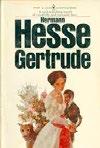
FOR MORE, GO TO READERSDIGEST.CO.UK/CULTURE
JUNE 2023 • 141

Pie In The Sky
Will drone deliveries ever happen?
BY James O'Malley

When drones first became widely available, around 15 years ago now, it wasn’t uncommon to find tech people painting dramatic pictures of how they were soon going to change the world.
However, if you look up into the largely empty sky above us, you can quite clearly see that hasn’t happened yet.
Sure, drones are useful for taking aerial photos, and are a fun hobby for nerds like me—but we’re a long way away from aerial superhighways, packed with autonomous drones zipping parcels, medical supplies
142 • JUNE 2023
JOERG BOETHLING / ALAMY STOCK PHOTO
and perhaps even your Deliveroo order around the country at speeds that would be near-impossible on the ground.
And we’re seemingly still a very long way away from it. In 2016, in a blaze of publicity, Amazon announced that it had completed its first ever aerial delivery. In a heavily stage-managed video, we saw an Amazon “Prime Air” drone pick up a parcel from the company’s Cambridgeshire warehouse and fly it across the countryside, landing in the buyer’s garden, dropping the parcel, and then returning back to its home base.
and other medical supplies by drone, thanks to a company called Zipline. And the service is very much for real.
We're a long way from aerial superhighways with drones zipping parcels and orders around the country
Like Amazon, Zipline drones are not quadcopters with propellers, but fly more like traditional planes. After being launched into the air using a catapult system, they fly autonomously to their destination hospital, and once over the hospital grounds, drop their payload via parachute, which doctors can then pick up and take straight to their patients. The drone then flies back to where it started—landing like a plane on an aircraft carrier by catching it with a wire.
But as far as I can tell, Amazon still has not completed its second ever drone delivery. In fact, since the video was released the company has reportedly downscaled its drone programme, and laid off or redeployed many of the people working on it.
So, will drone delivery ever be a thing? There are some glimmers of a possible drone delivery future, not in Britain or even the United States, but in Africa.
Because also since 2016, rural hospitals in Rwanda have been receiving regular shipments of blood
It’s a hugely impressive system, and one that surely has saved lives thanks to the speed at which blood can be delivered in a country with a poorly developed road network. And since then the company has already expanded its operations to Ghana— and has delivered over a million doses of COVID-19 vaccine by drone.

James is a technology writer and journalist. A former editor of tech website Gizmodo UK, James can be found mostly on Twitter posting jokes of variable quality @Psythor
143
TECHNOLOGY JUNE 2023 •
So could we ever expect such a system here? Unfortunately there’s a big difference between rural Africa and densely packed, bustling Britain. But now Zipline reckons it has the answer.
Earlier this year, the company announced a new short-range helicopter drone that could conceivably be used in cities to deliver food and the like. But there’s still a problem: British homes don’t have large gardens in which to land, and nobody wants loud, bulky drones constantly landing around the neighbourhood.
So how does Zipline plan to get around it?
Seemingly by taking inspiration from Thunderbird 2. The idea is that the new drone will hover overhead, quite high up—but once it is over your house, it will deploy a much smaller drone on a line from the mothership, containing a smaller propeller and your delivery. That way, the smaller, quieter drone can carefully manoeuvre to exactly where it needs to be—while the mothership remains out of sight in the skies above your home at the other end of the umbilical.
Assuming the technology can even fly a drone so precisely, the reality is that British cities may still have security and safety concerns about routinely having drones carrying stuff over our heads.
And that’s why I wonder if the real drone future could be crawling along the ground. For a few years, “autonomous delivery robots”, that look like minifridges with wheels, have been stalking the pavements of Milton Keynes, Northampton and a handful of other towns in that particular part of the world, delivering takeaway meals.

To navigate, they use an array of cameras and some clever selfdriving technology. Though they do have one added trick: if they reach an obstacle they can’t pass autonomously, such as a road that requires crossing, a human operator can connect to the cameras remotely, and safely pilot the "drone" to safety.
To date, the company claims to have made over 4 million successful deliveries. And what makes them work so well is they’ve eliminated the hard bit: flying.
It’s a very cool idea, but I must admit I’m not entirely convinced.
So perhaps we’re not so far away from a drone delivery future. It’s just that the reality might be a little bit more down to earth. n
144 • JUNE 2023
TECHNOLOGY
Ask The Tech Expert
James O'Malley
Q: My computer has got really slow, how can I speed it up? - Jane
A: We slow down a little as we age, and the same is true for our computers. But luckily, there are some steps you can take to make your machine a bit faster.
Restart your computer: The oldest advice in computing remains true. As we use our computers, we open and close apps and files, each of which require different system resources. Think of it like a kitchen worktop— there’s only so many times you can prepare food without wiping it down.
Limit what happens at start-up: When your computer first loads up, before you even touch the mouse, it has already opened programs and apps. Most of these take care of important system processes—but others are less important. For example, you don’t need Zoom to run automatically unless you’re making a call. Head to Control Panel or Settings and disable your least-needed start-up items.
Defrag your hard disk: If you run Windows, you may want to periodically defragment your hard disk
Garcia
in Settings. This doesn’t mess with any of your data, but it does put it into a more logical order, which means your computer can find files more quickly.
Uninstall what you don’t need: Check how full your hard disk is. If it is close to being completely full, then deleting files you don’t need, or uninstalling programs you no longer use will give your PC that little extra breathing room to use the spare memory.
Reinstall your operating system: Sometimes it is good to start again with a clean state. Make sure you know what you’re doing—and make sure you back-up anything important first!
Physically clean your computer: Heat is your computer’s worst enemy, and modern operating systems automatically throttle down the processors if it gets too warm, to stop any fires breaking out. Occasionally blast the fans and other air holes with some compressed air to remove the dust, so heat doesn’t build up.

Bite the bullet and upgrade: And finally, the most annoying advice: if your computer is more than a few years old, it might now be time to upgrade. n
145 JUNE 2023 • READER’S DIGEST
illustration by Daniel
Homophones are words that share the same pronunciation, no matter how they are spelled. If they are spelled differently then they are called heterographs. Find heterographs meaning:
Win £30 for your true, funny stories!
Go to readersdigest.co.uk/contact-us or facebook.com/readersdigestuk
The lunchtime retirement party had gone on longer than I had expected, so I was running late. I still had to walk the dog this evening and he would be waiting impatiently.
Swaying slightly as the alcohol I had consumed hit me, I let myself in through the back door. I slipped the dog lead off its hook, picked up the poo bags and headed off on our walk.
The evening stroll lasted about an hour, and I returned home with a much clearer head, only to be greeted by a laughing wife and a confused-looking labrador.
“Are you going to take Ralph with you next time?” the wife chuckled as I gazed down at the empty lead in my hand.
DENNIS PEASNELL, Herts
My partner and I had not long moved into our rurally-located new house. Being a nature lover, I was excited to learn of several sightings of wild boar in the area.
You Couldn’t Make It Up 146 • JUNE 2023
FUN & GAMES AND THE £50 GOES TO… SHARON WALLIS, Manchester £50 PRIZE QUESTION ANSWER TO MAY'S PRIZE QUESTION THREE-IN-ONE AMERICAN CIVIL, BOER, COLD THE FIRST CORRECT ANSWER WE PICK WINS £50!* Email excerpts@readersdigest.co.uk
DOUBLETALK
MOVE UP AND DOWN QUICKLY & ARAB CHIEF
Two weeks in, while my husband was at work, I was sitting in the garden when I heard the unmistakeable grunt of a group of pigs. Although it seemed quite distant it was very frequent, almost rhythmic throughout the morning, and I eagerly posted my finding onto the local community social media group. When my husband arrived home at lunchtime, I excitedly dragged him into the garden to share my news.
As we sat poised to listen, he whispered: “It’s difficult to hear anything over the sound of that pneumatic drill they’re using to dig the bottom of the road out.”
Of course, I never told him or the online community that my wild boars were in fact just the rumblings of a busy workman with a drill.
NICOLA RICHARDSON, Sussex
While waiting for a cataract operation, I couldn’t wear my contact lenses so reverted to my old glasses. A friend saw me in the pub and said, “You’re looking very studious in your glasses. It’s the most intelligent that I’ve seen you in a long time!”.
CAROLINE DODD, Cheshire
Not so long ago, I took my grandparents on a trip to Guildford. The regular road back was closed, so Granny suggested another route she used to take. It was not successful. We ended up at a roundabout she had either forgotten about or didn’t know

existed. After three trips round, we ended up on the motorway heading into London—the exact opposite way to where we wanted to go.
Two and a half hours and a lot of stress later, when we were finally home in the driveway, Grandpa pointed to the screen in the centre console of the car. “This thing has a built-in sat nav, you know.”
REBECCA ORAM,
Hampshire
We were sharing our safari holiday photographs with our friends. They started giggling at a photo of the cockerel that had flown up onto the table after breakfast and been busy helping to clear up the leftovers.
“The Cornflakes box came to life!” my holiday buddy explained.
“You’re lucky it wasn’t Frosties!” a friend quickly replied.
ANITA KAUR
JUNE 2023 • 147
cartoon by Guto Dias



12 ISSUES FOR ONLY £24 SUBSCRIBE TODAY AND NEVER MISS AN ISSUE UK DELIVERY FREE BEST VALUE OFFER PLUS, RECEIVE YOUR COPY EACH MONTH BEFORE IT HITS THE SHOPS! EASY WAYS TO SUBSCRIBE… 3 TELEPHONE: UK only. Open Mon-Fri 8:30am-6pm, Sat 9am-5pm. Overseas +44 1788 392461 0330 333 2220 Quoting JUNEMAG ONLINE: www.readersdigest.co.uk/maymag BY POST: FREEPOST: WARNERS GROUP (READ) Enclose your full contact and address details along with a cheque for £24 made payable to Reader’s Digest, quoting JUNEMAG You can also purchase a single issue or subscription for digital download at www.readersdigest.co.uk/digitalmag
Word Power
Ahoy! Do you know your nautical terms, or are you a landlubber? Let this quiz help you find your sea legs
BY GEORGE MURRAY
1. scuttle—A: freshwater rations. B: purposely sink a ship. C: naval battle between two ships.
2. coxswain—A: rudder. B: person in command of a boat. C: person responsible for cleaning the cabins.
3. bulkhead—A: dividing wall between a ship’s compartments. B: front of a vessel. C: sailor who loads cargo.
4. trim—A: make efficiency adjustments to sails. B: captain’s quarters. C: sailor’s uniform.
5. killick—A: small rocky island. B: small anchor. C: small buoy.
6. gangway—A: warning called when one ship is about to hit another. B: opening where people board and disembark. C: entire crew of a ship.
7. escutcheon—A: main mast’s uppermost reaches. B: spare sail. C: part of a ship where its name is displayed.
8. ebb—A: new sailor. B: recede, as a tide. C: hazardous rapid.
9. baggywrinkle—A: life-boat tarp. B: cloud formation indicating a storm surge. C: soft covering for cables to prevent sail chafing.
10. belay—A: layover in a harbour. B: delayed departure. C: fasten, as a rope would be.
11. leeward—A: away from the wind. B: toward a safe port. C: sonar used to find rocks.
12. doldrums—A: equatorial zone known for low winds. B: low trough after a wave crest. C: clouds almost low enough to be fog.
13. jetty—A: landing pier. B: cargo dumped overboard to lighten the load. C: outboard motor.
14. pooped—A: recorded in the ship’s log. B: swamped by waves over the stern. C: sick with scurvy.
15. bilge—A: shipboard cuisine. B: water that collects in the lower hull. C: acute seasickness.
JUNE 2023 • 149 FUN AND GAMES
IT PAYS
TO INCREASE YOUR
Answers
1. scuttle—[B] purposely sink a ship; The captain scuttled the craft to keep it from falling into enemy hands.
2. coxswain—[B] person in command of a boat; The whole crew rowed to the rhythm expertly set by their coxswain.
3. bulkhead—[A] dividing wall between a ship’s compartments; Cal banged on the bulkhead to tell the guys in the next cabin to keep it down.
4. trim—[A] make efficiency adjustments to sails; Following a change in wind, Captain Roberval ordered us to trim the mainsail.
5. killick—[B] small anchor; Sheila dropped a killick over the side of her boat and proceeded to pull out her fishing rod.
6. gangway—[B] opening where people board and disembark; 2,000 tourists spilled through the cruise ship’s gangway.
7. escutcheon—[C] part of a ship where its name is displayed; The harbour master raised her binoculars to examine the unexpected arrival’s escutcheon.
8. ebb—[B] recede, as a tide; Fernanda pumped the oars with all her energy, fighting the ebbing current to try to reach the shore.
9. baggywrinkle—[C] soft covering for cables to prevent sail chafing; Old, unreliable rigging rope is often recycled into baggywrinkle.
10. belay —[C] fasten, as a rope would be; The new recruit struggled to belay the lines, which kept sliding off their pins.
11. leeward —[A] away from the wind; All the life rafts were launched from the leeward side of the sinking ship.
12. doldrums—[A] equatorial zone known for low winds; Sayid sighed as they entered the Pacific doldrums: a shift at the oars could surely not be far off.
13. jetty—[A] landing pier; A crowd stood all along the jetty, waving adieu to the steamship.
14. pooped—[B] swamped by waves over the stern; as, “We’re pooped !” sputtered the helmsman as he fled his post.
15. bilge—[B] water that collects in the lower hull; Sully moaned when he dropped his pocket watch and heard it splash into the bilge.
VOCABULARY RATINGS
7–10: fair 11–12: good 13–15: excellent
WORD POWER
150 • JUNE 2023
Reader’s Digest Competitions –
Enter today for your chance to win!

You will find this photograph somewhere inside this issue of the Reader’s Digest magazine, but can you find it? Once you have, simply write the page number on your entry form, or enter online.
Competitions – How to enter
Enter By Post Or Online – June 2023 closing date for entries: 17 June 2023
Online: readersdigest.co.uk/magazine-competitions
By Post:
Complete the entry form and send via post to Reader’s Digest Competitions, Warners Group Publications, West Street, Bourne, PE10 9PH
COMPETITION ENTRY RULES
Competitions are open to residents of the UK, Eire and BFPOs, aged 18 or over, except Reader’s Digest employees and any associated partners or affiliated companies. No purchase necessary. Entries can be made via post or online. There is no cash alternative and prizes are not transferable. Only one entry per person. Winning entries will be chosen at random and winners will be notified by email or post. Winners must agree to publication of their name, age and photo. Your information will only be used in accordance with our privacy policy. Entry implies acceptance of these rules. Full terms can be viewed online at readersdigest.co.uk/ competition-rules.
JUNE 2023
ENTRY FORM
Fill in all your answers below:
(enter as many as you like – one entry per competition per person)
Page 86 £500 Cotton Traders voucher
Page 87 Prize Wordwheel –£200 Arena Flowers
Page 102 Macdonald Hotel Break
Page 109 2-Night stay at Penrhiw Priory
Page 124 Prize Crossword –£200 Bed Threads
Page 151 Photo Finder
Name:
Address:
Postcode:
Telephone:
Email:
n * I opt-in to receive the reader’s digest email newsletter for offers and competitions
n * I opt-in to be contacted by third party competition promoters about future offers and promotions (*please tick)
WIN!
3 X £50
Photo Finder
COMPETITIONS
Brain GAMES
Sharpen Your Mind
Labyrinth
Fauna Farce
MEdiuM All flounders are flatfish. Some flatfish are freshwater fish. Flamingos only make friends with freshwater fish. If a fish is a flamingo’s friend then it is a frog’s foe. Flounders have either four fins or five. Five-finned flounders fear frogs. Four-finned flounders are not freshwater fish.
One of these “facts” does not follow. Find the falsehood:
F Some fish that fear frogs are flatfish.
F Flamingos will not make friends with all flounders.
F If a freshwater fish is a flounder it has five fins.
F Some frogs have five-finned flounders as foes.
152 • JUNE 2023 FUN & GAMES
by
b eaudoin;
Farce by d arren r
Labyrinth
Louis-Luc
Fauna
igby
Easy
C
B B C D D B
Petal Problem
difficult The flower pictured right grows its petals one at a time in a specific pattern. Once it has its first petal (as shown in Phase I), it adds its next three petals following the exact same process. From these pictures of its progression, can you determine which of the three options (A, B or C) depicts what the flower will look like in Phase IV?
First In
difficult Place the letters A, B, C and D into this grid so that each letter appears exactly once in each row and column, with one cell in each row and column left blank. Each letter outside the grid indicates the letter that must appear first in its respective row or column (reading in from the edge of the grid closest to the letter, and skipping any blank cells). Can you complete the grid?
Do The Maths
MEdiuM Use five mathematical symbols (+, −, ×, ÷, and √) to complete the equation. Use each symbol only once, and ignore the standard order of operations.
? 36 ? 4 ? 9 ? 3 ? 2 = 7
JUNE 2023 • 153 First i n by Fraser s impson; p eta L p rob L em and d o t he m ath by e mi L y g oodman
I.
A. II. B. III. C.
For
PAGE 155
answers, turn to
ACROSS
1 The footballer realised in the last few minutes that it was __ __ to him (3-2)
4 The first meal of the day (9)
9 Framework of hexagonal cells (9)
10 Petty officer on a merchant ship (5)
11 Sport with pucks and sticks (3,6)
12 Walk or run with leaping strides (5)
13 Good Will Hunting star (4,5)
15 Cheap, old British sub-machine gun (4)
17 Of the present month (4)
19 Victories (9)
23 Played by Sylvester Stallone (5)
24 Perceptive (9)
26 Where you are now (5)
27 Noiseless (9)
28 Aping someone (9)
29 Set of biological attributes (5)
CROSSWISE
Test your general knowledge. Answers on p158
DOWN
1 Belief that there is no God (7)
2 Not strict (7)
3 Cargoes (8)
4 Small streams that babble (5)
5 At a very early stage (9)
6 Meat on a skewer or spit (6)
7 Kind of rifle (7)
8 Switched on (5,2)
14 Italian dictator (9)
16 Humiliates (8)
17 Tel Aviv native, for example (7)
18 Feudal Japanese warrior (7)
20 Stood on by an orator (7)
21 Artists’ models (7)
22 Californian desert tree with links to the Bible and the band U2 (6)
25 Colloquialism (5)
154 • JUNE 2023
BY Louis-Luc Beaudoin SUDOKU
BRAIN GAMES ANSWERS
FROM PAGE 152 1 5 3 6 9 4 3 8 8 7 2 3 6 4 1 7 6 5 6 2 9 4 1 7 2 3
To Solve This Puzzle
Put a number from 1 to 9 in each empty square so that:
F every horizontal row and vertical column contains all nine numbers (1-9) without repeating any of them;
F each of the outlined 3 x 3 boxes has all nine numbers, none repeated.
Labyrinth
Fauna Farce
The fourth (some frogs have five-finned flounders as foes.)
First In
Petal Problem
B. Each of the flower’s petals rotates clockwise by 120 degrees, then a new petal is added at the bottom.
Do The Maths
√36 × 4 − 9 ÷ 3 + 2 = 7
JUNE 2023 • 155 READER’S DIGEST
1 7 8 2 5 4 3 6 9 5 6 3 8 1 9 4 7 2 9 2 4 3 6 7 5 1 8 8 1 6 7 3 5 9 2 4 4 3 7 6 9 2 1 8 5 2 5 9 4 8 1 7 3 6 3 8 5 1 4 6 2 9 7 6 9 2 5 7 3 8 4 1 7 4 1 9 2 8 6 5 3 SOLUTION C B A D A D B C C D B A D A C B B A C D
Laugh!
WIN £30 for every reader’s joke we publish!
Go to readersdigest.co.uk/contact-us or facebook.com/readersdigestuk
Anyone interested in a precise list of Bugs Bunny quotes? I can send them in a WhatsApp Doc.
MELANIE LODGE, West Yorkshire
What goes “oom oom”? A cow walking backwards.
MATTHEW SMITH, Sheffield
Everyone talks about Karl Marx but never mentions his sister, Onya. She invented the starting pistol!

DENNIS BOON
What’s the difference between a cat and a comma? One has the paws before the claws and the other has the clause before the pause.
LEE SEVILLE, Cheshire
I grilled a chicken for two hours today. It still wouldn’t tell me why it crossed the road!
ELI LEBRETT
Which celebrity is the best at cutting down trees? Justin Timberlake.
STEVE HOLLANDS, Hertfordshire
Yesterday I saw a man spill all his Scrabble letters on the road. I asked him, “What’s the word on the street?”.
ROBERT AITCH, Cheshire
FUN & GAMES
156 • JUNE 2023
ASK A COMEDIAN
Liam Withnail
A comic with over 10 million TikTok and Instagram views, Liam Withnail is set to premiere his new stand up show, Chronic Boom, at Edinburgh Fringe. Ian Chaddock asks him about his funniest experiences…
What stand up/film stands out as making you fall in love with comedy? I’d love to tell you it was something intellectual like Peter Sellers in Dr Strangelove. The truth is that in 1997, Jim Carrey’s Liar Liar hit the screens and to me, the funniest man alive was revealed. His rubber-faced buffoonery led me to ask my parents to take me to drama club, and the rest is history!
What do you remember about your first time doing stand up? Well, I first did stand up aged eight as part of a talent competition at Haven Holiday camps. What I mainly remember is telling some jokes my dad knew and lots of old ladies pinching my cheeks. Probably the best gig of my life, in retrospect.
What is the weirdest heckle you’ve ever heard and how did you respond? In Glasgow I once had a drunk woman ambush the stage and
throw a gin and tonic over me. I was in the middle of a fairly inoffensive routine about a takeaway, so I’m not sure why! The gig was stopped and when we returned I came on stage with an umbrella, for protection from other flying liquids.
What is the weirdest job you’ve ever found out someone in the audience does for a living? I recently met an artist who paints canvases using toy cars instead of paint brushes. It turns out lots of high-end car manufacturers have employed him for custom artwork! Luckily, we were filming and managed to get a viral clip out of the discussion.

What has been your most hilarious live show experience? As part of the Edinburgh comedy collective Viva La Shambles, we had monthly shows with “stand up challenge” sections. You would perform stand up while
JUNE 2023 • 157
undergoing an ordeal, like eating the UK’s spiciest hot sauce, having elastic bands pinged at you or being electrocuted!
What is one thing you’ve found out about a famous comedian you’ve met that surprised you? I was recently at a skiing comedy festival in Austria with Dylan Moran. He’s exactly the same in real life as he was in Black Books. Most comics are playing up to it at least a little bit, but he’s like an alien that has just landed on Earth.
What’s the funniest album you’ve ever heard and why? A good question for a comic with a music-based podcast. We recently covered the Arctic Monkeys knock-off The Reytons, and it was hilarious for all the wrong reasons. Subtlety is not their strong suit.
What is your new stand up show about? It’s jokes and stories about learning I have a chronic illness. Funnier than it sounds!
FindLiamonInstagramat@liamwithnail
LiamWithnail’snewstandupshow,Chronic Boom,premieresatEdinburghFringeinAugust
EnjoyAnAlbumpodcastisavailableonallusual podcastplatforms
My Weird Sibling

Twitter users share their funniest weird sibling stories
DJTheOldMan: My sisters and I would eat peas like pills with a big glass of milk.
@LiterallyHatGuy: My brother went into an exhibition and took photos of the fire extinguisher thinking it was a work of art.
@CarolineJosephs: As a child my sister would act like a cat and hiss at you if you upset her.
@Robnhood6: One of my brothers wanted to grow up and be a Muppet. The other wanted to be a Clydesdale horse.
@Stillwatergirl: My sister and I had my baby brother convinced that he had a twin that we kept in the cupboard and would take him out and play with him and have fun whenever my brother wasn’t around.
CROSSWORD ANSWERS
Across: 1 All-up, 4 Breakfast, 9 Honeycomb, 10 Bosun, 11 Ice hockey, 12 Bound, 13 Matt Damon, 15 Sten, 17 Itsy, 19 Successes, 23 Rambo, 24 Observant, 26 Earth, 27 Inaudible, 28 Imitating, 29 Sexes
Down: 1 Atheism, 2 Lenient, 3 Payloads, 4 Brook, 5 Embryonic, 6 Kebabs, 7 Assault, 8 Tuned in, 14 Mussolini, 16 Degrades, 17 Israeli, 18 Samurai, 20 Soapbox, 21 Sitters, 22 Joshua, 25 Slang
LAUGH
Beat the Cartoonist!

Think of a witty caption for this cartoon—the three best suggestions, along with the cartoonist’s original, will be posted on our website in mid-JUNE. If your entry gets the most votes, you’ll win £50. Submit to captions@readersdigest.co.uk by JUNE 7. We’ll announce the winner in our August issue.
APRIL WINNER

Our cartoonist’s caption, “You are in denial about climate change” failed to beat our reader Michael Goldstone, who won the vote with, “And when exactly did you start thinking that you were a fish?” Congratulations, Michael!
The Mayor of London on childhood, tackling air pollution and dealing with criticism IN THE JULY ISSUE

SADIQ KHAN

I REMEMBER… Geezer Butler
The bassist and lyricist of the legendary metal band, Black Sabbath, looks back on his incredible life
What’s In A Song?
Will AI destroy music making? Or is it the industry’s future? We ask the experts
READER’S DIGEST JUNE 2023 • 159
cartoons by Royston Robertson

GOOD NEWS
from around the World

America’s Only Native Stork May No Longer Be Endangered
While many animal populations seem to be dwindling, one species that is moving in the opposite direction is America’s native wood stork.
The wood stork is the only stork that breeds in North America. In 1984, it was declared an endangered species after its population plummeted to just 5,000 mating pairs. At the time, scientists predicted that the bird would be completely wiped out by 2000.
Today, it numbers 10,000 mating pairs, and the Fish and Wildlife Service is proposing a delisting of the wood stork as an endangered species. So how did the population bounce back?
The success is in part down to the resourcefulness of the wood stork. The wood stork’s native home was in the Everglades in Florida, but it migrated north as the Everglades were being destroyed by development. In 1987, former Savannah Coastal Refuges biologist John Robinette noticed stork nests in Georgia, as stork populations moved to safer wetlands.
According to Stephanie Kurose, a senior policy specialist at the Centre for Biological Diversity, the Endangered Species Act is also to thank for this recovery. In an email to NPR, she said, “The act saved the wood stork and it helped preserve and rebuild vital habitats throughout the southeast, which has improved water quality and benefited countless other species who call the area home.”
The Endangered Species Act has saved 99 per cent of the species that were on the list since 1973. A hundred types of plants and animals have been delisted as their populations become stable again.
If the wood stork is delisted, it will remain protected by other laws and a monitoring plan will be put in place to ensure the population remains stable.
by Alice GAwthrop
160 • JUNE 2023
GOOD NEWS


Free up cash and lower your overheads in a comfortable, well-located home High-quality,

Moving to one of our coastal, rural or semi-rural residential parks could help you free up cash and save on your bills. So, not only will you be super-comfortable in a brand new, move-in ready home in a like-minded community. You’ll also have more to spend on the good things in life and could be closer to friends and family. Whether you’re retiring or winding your work down, it’s time to give yourself the opportunity to make the most of every day.
homes
Safe, secure community of like-minded residents
Private garden and parking
No stamp duty
Part exchange and assisted move options available
Get in touch to find out more or arrange a park visit: www.tingdene-parks.net | 01933 427817 | info@tingdene.net
Move in ready homes available
IT’S TIME TO FOCUS ON LIFE NOT THE COST OF LIVING
Freedom to live life to the full. Modern comforts. Community spirit
low-maintenance, single-storey





































1 0 2 3 4 5 6 7 8 9 10 11 12 13 14 15 16 17 18 Call FREE today for a FREE brochure & home de monstra tion www.mobilityfurniturecompany.co.uk *The 50% offer is taken from the least expensive item and must be ordered at the same time. 0800 810 8782 TRULY MADE-TO-MEASURE RISE & RECLINE CHAIRS CHOICE OF BACK HEIGHT CHOICE OF SEAT HEIGHT CHOICE OF SEAT DEPTH CHOICE OF SEAT WIDTH Choose from our extensive range of chairs and selection of 400 fabrics & upholsteries Ultra comfort pocket sprung AERO-seat option your old furniture THE 1 THE 2ND ITEM* WARRANTY INCLUDED FREE WITH EVERY MECHANISED ITEM SALE ! „ Putting your feet up is a way to reduce swelling Dr Rob Hicks „ FOAM POCKET SPRUNG Flexible finance packages MOBILITY FURNITURE COMPANY THE handcrafted in great britain ELECTRIC SOFA BED














































































































































































 Clockwise
above: A peacock in Dubrovnik; a woman in medieval garb performs in front of the Church of St Blaise; the historic city walls; a bustling evening in Old Town
Clockwise
above: A peacock in Dubrovnik; a woman in medieval garb performs in front of the Church of St Blaise; the historic city walls; a bustling evening in Old Town






























































 H H H H
H H H H


































































